- Skip to main content
- Skip to primary sidebar
- Skip to footer


How To Visit the Acropolis in 2024: Tickets, Hours, Tours, and More
Eleni Gimouki Last Updated: September 26, 2023
Every year, millions of people visit this ancient site in Athens. It has one of the most recognizable temples in the world. But did you know there’s much more to see at the Acropolis than just the Parthenon? In this guide, find out what you need to know about how to visit the Acropolis from getting tickets to the best guided tours, what to see at the Acropolis, and more.
Pro Tip: Planning what to do on your trip to Athens? Bookmark this post in your browser so you can easily find it when you’re in the city. Check out our guide to Athens for more planning resources, our top Athens tours for a memorable trip, top things to do in Athens , and The Best Athens Tours to Take and Why.
Visiting the Acropolis: What We’ll Cover
The site of the Acropolis has been inhabited since as far back as 5000 B.C. and it’s still largely intact to this day. While you may easily recognize the Parthenon, there’s far more to see at the Acropolis than this iconic temple.
The area included in most Acropolis admissions covers quite a bit of ground on this hilltop site with some tickets even including ruins like the Ancient Agora, Hadrian’s Library, museums, and much more in Athens. It can be overwhelming figuring out how best to see the Acropolis let alone understanding the long history and rich mythology of the site.
We highly recommend visiting megamonuments like this with expert local guides. Not only will they help you navigate the site and its history but, more importantly, they take care of the details so you can just enjoy your time at one of the most important ancient sites in the world. Check out our Acropolis tours .
We’ve put together this guide to help you prepare for your visit. Here’s everything you need to know about how to visit the Acropolis in Athens. Here’s what we’ll cover:
- Opening hours and tickets
- How much time to budget for your visit
- What to see at the Acropolis
- Guided tour options
- Facts and history of the Acropolis
- Places to eat nearby
Not ready to book a tour? Check out our Acropolis Guide or The Best Athens Tours to Take and Why .
Acropolis Opening Hours and Tickets
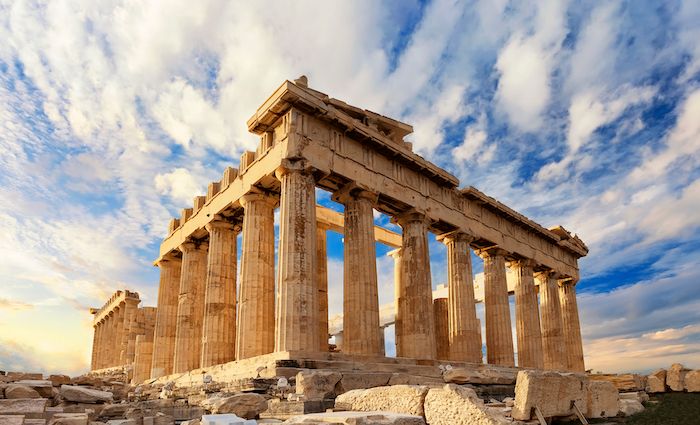
Opening Hours:
The Acropolis is open almost every day of the year from 8 am to 7:30 pm in the summer (last entrance at 7 pm) and 8 am to 5 pm in the winter (last entrance at 4:30 pm). Closing hours are subject to change, particularly in September and October, so be sure to check the official website for updated info.
There are several days that the Acropolis archaeological site is closed: January 1, March 25, May 1, Easter Sunday, December 25 and 26.
Pro Tip: If you can, try to visit the Acropolis either in the morning or in the evening when the weather isn’t quite as hot. The added benefit of visiting early in the morning is that it will be less busy.
- Adult Single Use ticket: €10 (valid for one admission to the Acropolis archaeological site and the slopes)
- Adult Combined ticket: €30 (valid for one admission to each site included over a five-day period)
The Combined ticket is valid for one admission to each of the following sites the Acropolis of Athens, Ancient Agora of Athens, Ancient Agora of Athens Museum, Archaeological Museum of Kerameikos, Hadrian’s Library, Kerameikos, Lykeion Archaeological Site, North slope of the Acropolis, Olympieio, Roman Agora of Athens, and South Slope of Acropolis.
Finally, there are also some free admission days:
- 6 March (in memory of Melina Mercouri)
- 18 April (International Monuments Day)
- 18 May (International Museums Day)
- The last weekend of September annually (European Heritage Days)
- Every first Sunday from November 1st to March 31st
Address: Acropolis of Athens
How Long To Spend at the Acropolis
Short Answer: 2 hours
When you visit the Acropolis, you’re not only going to see the Parthenon. On Acropolis Hill, you’ll find some of the most important monuments of Ancient Greece. Each one of them has its own history and architecture. So, try to spend some time admiring the details of each monument—you’ll certainly be impressed.
Pro Tip: Every time I visit the Acropolis, it seems different to me. I always feel that there’s something new and exciting to discover about it. With every visit, I see it from a different point of view. Two hours is enough for a first visit to the Acropolis site, but no doubt you’ll want to come again.
Check Out Our Best Athens Tours
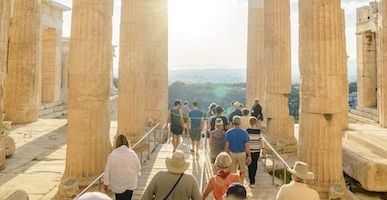
Top Rated Tour
Skip the Line Acropolis Tour with Parthenon and Museum
Towering above the modern city of Athens, explore the ancient forum home to the relics of Classical Greece. From the world’s oldest theatre to the iconic Parthenon, the Acropolis is a beacon of civilization and philosophy. Head back in time to the time of Plato and Socrates on this Skip-the-Line tour.
Starting at €80

Likely to Sell Out
Athens Local Food Tour in Monastiraki
Explore the gastronomic world of Athens through the city’s central market. Enjoy homemade pastries, authentic wines, cheeses, honey-soaked donuts, and much more. Your local guide will lead you through the best spots in the lively Monastiraki neighborhood for a delicious experience in Athens.
Starting at €68
Not ready to book a tour? Check out our Athens Guide for more resources and The Best Athens Tours to Take and Why .
What To See at the Acropolis
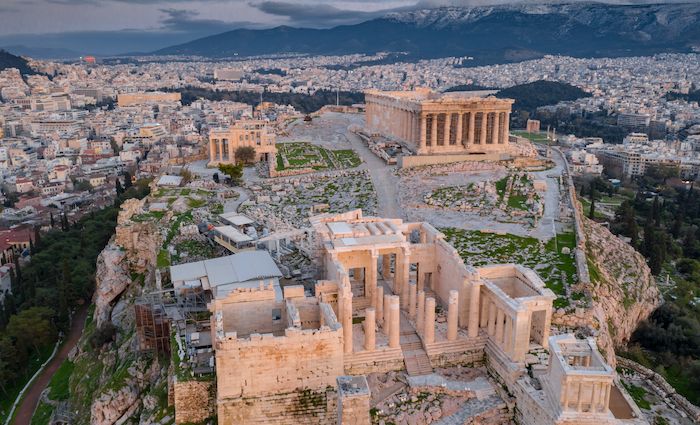
The archeological site of the Acropolis has a lot for visitors to see. Here is a short list of the must-see monuments at the Acropolis. For a more detailed list with descriptions, images, and some historical context, check out our article on the top things to see at the Acropolis .
- Temple of Athena Nike
- Erechtheion
- Odeon of Herodes Atticus
- Statue of Athena Promachos
- Sanctuary of Asclepius
- Theater of Dionysus
- Conservatory of Pericles
- Altar of Athena
Acropolis Tour Options
The Acropolis is a massive archeological site with a long, rich history and incredible mythology. Navigating both the physical site and its place in history can be overwhelming.
A guided tour of the Acropolis is so much more than skipping the lines. Your expert local guide will take you on an exploration through space and time in one of the most important places of Ancient Greece.
Skip-the-Line Acropolis Tour with Parthenon and Museum (4 hours)
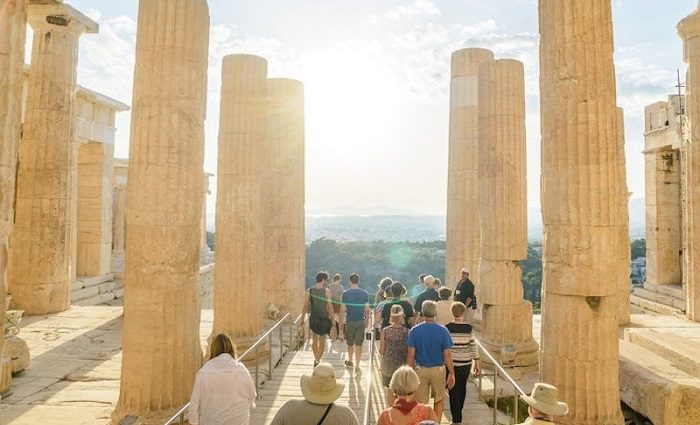
On our skip-the-line Acropolis tour, you’ll spend half a day walking in the footsteps of Plato and Socrates with an expert archaeologist guide. They’ll guide you on an exploration of the Acropolis, Parthenon, Theater of Dionysus, Odeon of Herodes Atticus, Temple of Athena, Nike, and other great monuments.
The major benefit of going with a guide is the stories you’ll hear about this ancient place. It’s one thing to see these sites, it’s another to see them knowing the historical context, the importance they played in history, and the changes and upheaval they endured. To end your tour, you’ll visit the Acropolis Museum where you can look through the glass to see the ancient ruins and buildings it was built over.
Not ready to book a tour? Check out our Acropolis Guide for more resources plus our Best Athens Tours to Take and Why .
Facts and History of the Acropolis
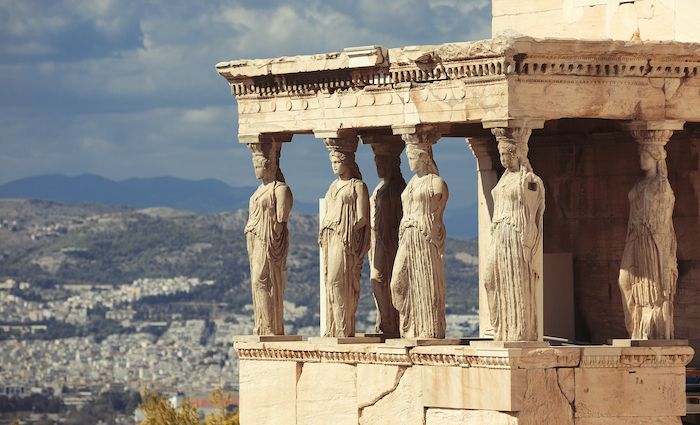
The Acropolis is an ancient site with a great deal of interesting history. Here are some quick points, but read our in-depth article to discover more astounding facts about the Acropolis .
- The name “Acropolis” actually means the “edge of the city” (in Greek “akro=edge + polis=city”).
- The Parthenon was built in the 5th century B.C. and is a monument-symbol of democracy.
- During the Byzantine era, it was converted into a Christian church. Under Frankish rule, it became a catholic church. During the Turkish occupation, it was converted into a mosque.
- The monuments have survived fires, earthquakes, invasions, wars, and conquerors all these years.
- Lord Elgin removed many important parts of the Acropolis monuments in 1801.
- In 1987, the Acropolis was inscribed in the UNESCO catalogue.
- The process of restoration of the Parthenon Temple, as well as the other monuments of the Acropolis, began in 1975.
Places To Eat Nearby
There are lots of restaurants and cafés near the Acropolis. Here are a few of our favorites. For more great places to eat, check out our guide to the best restaurants in Athens .
Kitchen Lab Corner : €€ | Coffee Shop —A tasty option for your breakfast or brunch before visiting the Acropolis. Especially your children will certainly love it.
Bairaktaris : € | Traditional Greek Cuisine —After this tour, it is a great choice to try some traditional Greek souvlaki, especially as lunch.
GB Roof Garden Restaurant And Bar : €€€€ | Fine Dining —Enjoy Mediterranean cuisine in the rooftop restaurant of this hotel with great views of the Acropolis.
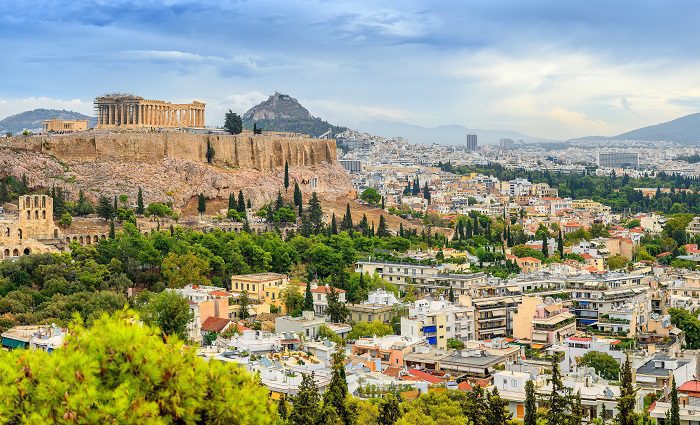
Where To Stay in Athens
A great hotel at a great price has become the norm in this internet era. Our article explains what areas are the best in Athens, so you can get a great deal in the perfect location!
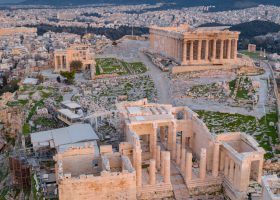
Reader Interactions
Leave a comment cancel reply.
Your email address will not be published. Required fields are marked *
- Travel Guide
- In The Press
POLICY & TERMS
- Cancellation Policy
- Terms & Conditions
- Privacy Policy

Winter: 08:00 17:00 Last entrance 16:30 Summer: From the 1st.09.2022 the opening hours apply. 1-15.09.2022: 8:00- 19:30 Last entrance to the Site at 19:00 On the 1st of September 2022 the opening hours apply, due to a gradual reduction in the length of the day, as follows: 1st to 15th September 08:00 - 19:30 Last entrance to the Site at 19:00, 16th to 30th September 08:00 - 19:00 Last entrance to the Site at 18:30, 1st to 15th October 08:00 - 18:30 Last entrance to the Site at 18:00 and 16th to 30th October 08:00 - 18:00 Last entrance to the Site at 17:30. Urgent Notice: The Ephorate of Antiquities of Athens informs that tomorrow, 19.12.2023, the Archaeological Sites may not operate normally due to the strike announced by the Panhellenic Union of Antiquities Guards Employees and the work stoppage of the Unified Association of Employees of the Ministry of Culture of Attica, Central and Islands and the Panhellenic Association of Certified Archaeological Guards. Please ensure that you are informed before visiting the sites. Announcements: 1.Beginning of the second phase of the restoration works on the pedestal of Agrippa On Tuesday June 7th, conservation works are going to begin on the lower part of the pedestal of Agrippa, in the area to the West of the Propylaea. The scaffolding installation works will take place during evening hours and will be completed within the upcoming days. Thus, the visitors route will be modified for safety reasons, from 18:30 till the closing time of the archaeological site, on 20:00. 2. Part of the lighting of the eastern part of the north porch of the Erechtheion will be out of service for the next few days due to works as part of the YSMA's restoration project in the area. Important notification: 1. All applicable emergency measures to protect public health from the risk of further spread of COVID-19 coronavirus are implemented at the Archaeological Site. 2. From Friday 28th of May 2021 and on, the visitors of the Site are not be able to visit Acropolis North Slope (Peripatos) due to work in progress. People with Special Needs will be allowed to use this path, in order to approach the specially designed elevator going up the Acropolis Hill with the aid of the guard staff.

The Ultimate Guide to Visiting the Acropolis and Parthenon in Athens (2024)
Written By: The Planet D
Updated On: March 22, 2024
You can’t miss the Acropolis when visiting Athens, you can see it from everywhere! Standing proud over the city, the Acropolis is the number one attraction in Athens. So, you know what that means? A lot of crowds! This ancient citadel, perched above the city on a limestone plateau, is a beacon of history, art, and civilization. For those drawn to the echoes of the past, a visit to the Acropolis promises a deep dive into the heart of Greek heritage, with the majestic Parthenon standing as its crown jewel. We have been lucky enough to visit this amazing site three times and want to pass on our tips to help you have the best experience. So get ready to explore the ins and outs of making your Acropolis visit as epic and enlightening as possible, from dodging the crowds to uncovering the best views.
Table of Contents
What is the Acropolis?
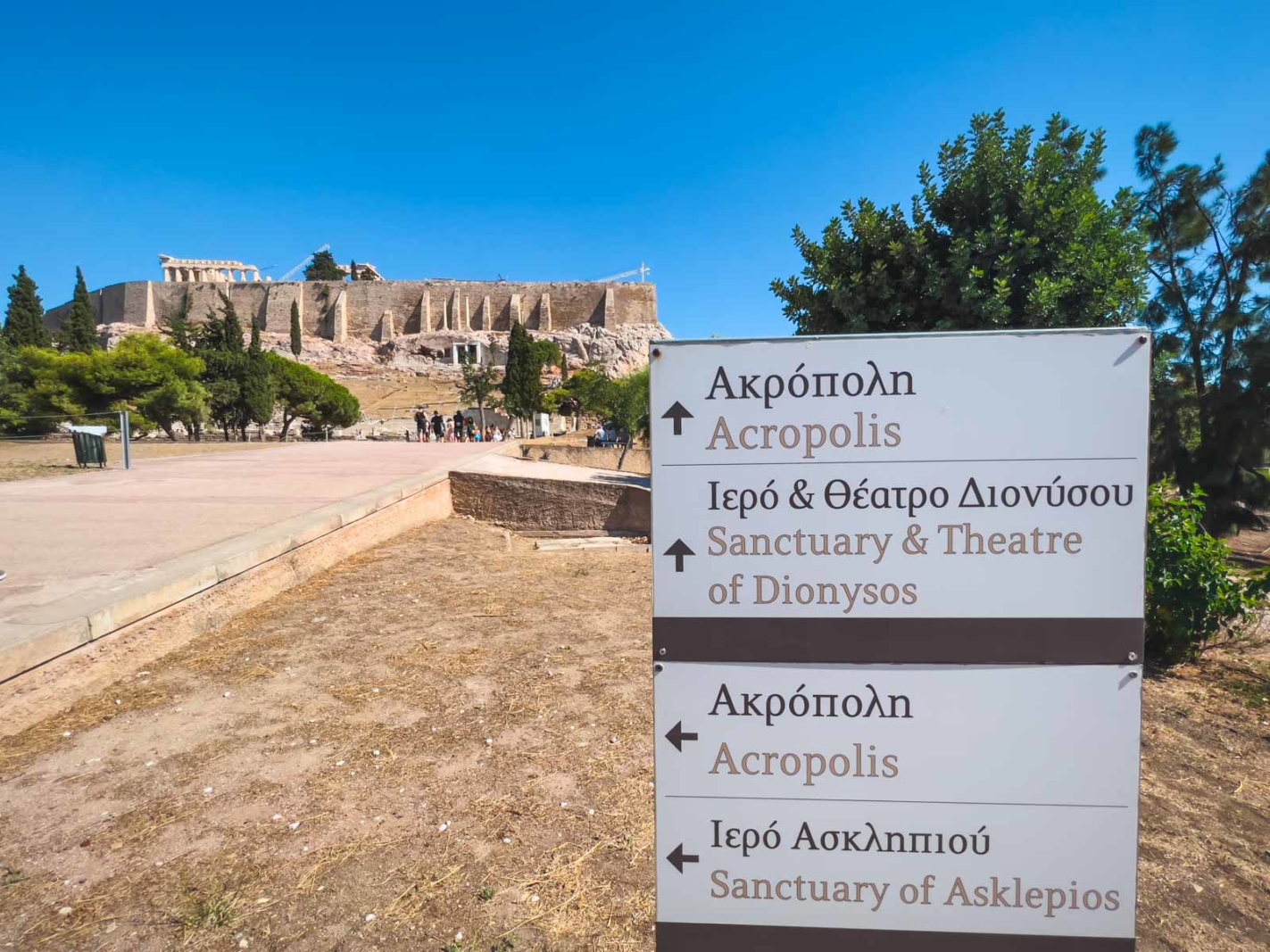
The Acropolis of Athens is a UNESCO World Heritage that stands as a beacon of the grandeur of ancient Greek civilization. Perched atop a 172 meter high rocky outcrop above the city of Athens, the Acropolis dates back to the 5th century BC, serving not only as a symbol of the power and culture of Athens but also as a pivotal monument in the development of Western civilization.
This historical site is home to several iconic structures, including the Parthenon, the Erechtheion, the Propylaea, and the Temple of Athena Nike. The Acropolis’s history is intertwined with the birth of democracy, philosophy, and the arts, making it a focal point for scholars and tourists alike to explore the origins of these fundamental concepts. An Acropolis visit offers a window into the ancient world and its enduring influence on modern culture and society.
Best Time to Visit Acropolis
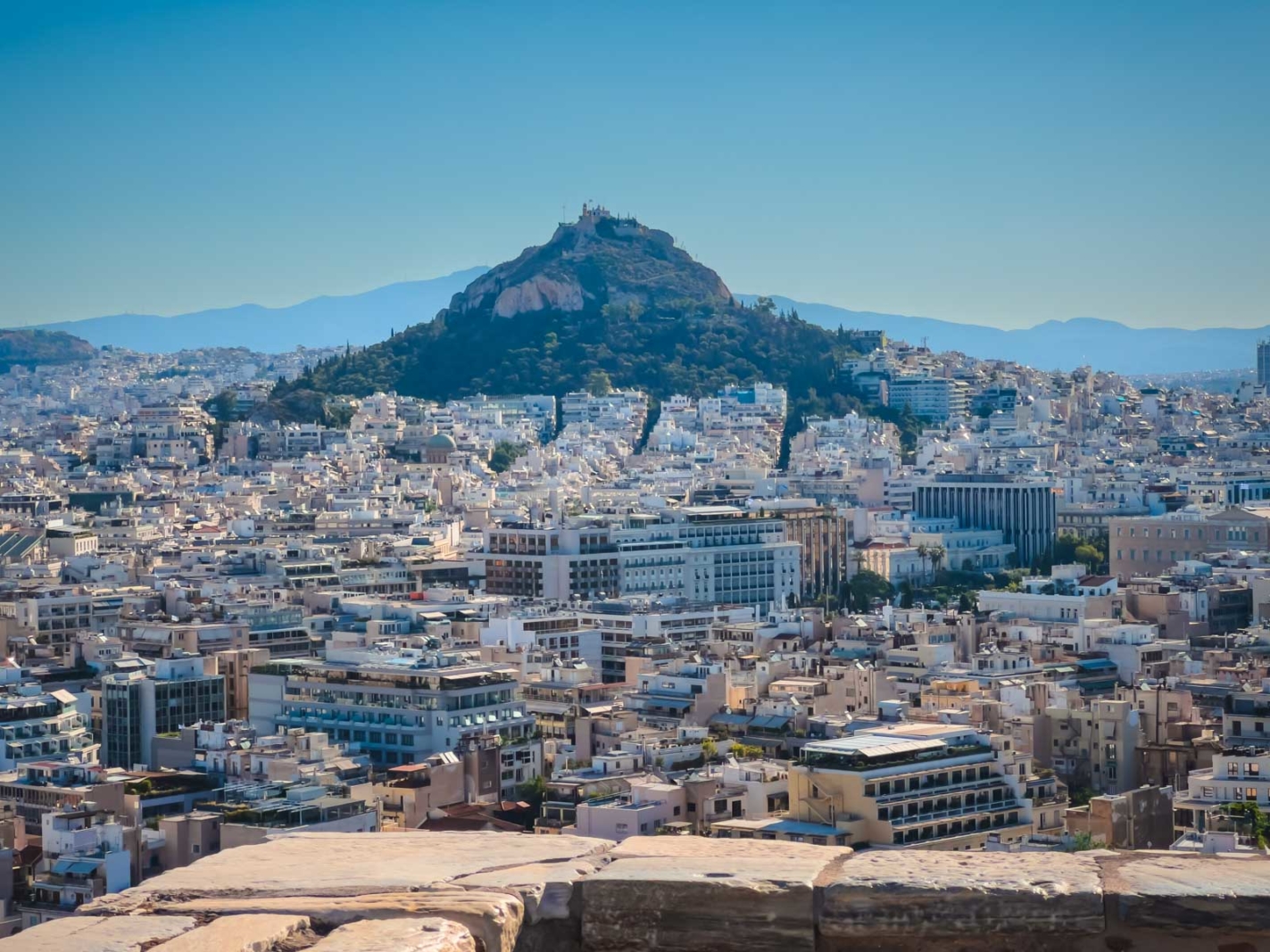
To avoid the throngs of tourists and the scorching sun, aim for an early morning or late afternoon visit. The Acropolis opens its gates at 8:00 AM, so getting there right at opening time can give you a cooler and somewhat more private experience. We walked from our hotel at sunrise to make it for the first slot at opening, as soon as the guards came down, we rushed ahead to the entrance to be first up without any crowds.
If you can’t make it for the first time slot, we suggest visiting an hour or two before closing allows you to enjoy the golden hues of sunset casting a magical glow over the ancient stones. Plus, all of the organized tours and tour buses will be gone by then.
Tickets and Timed Entry to the Acropolis
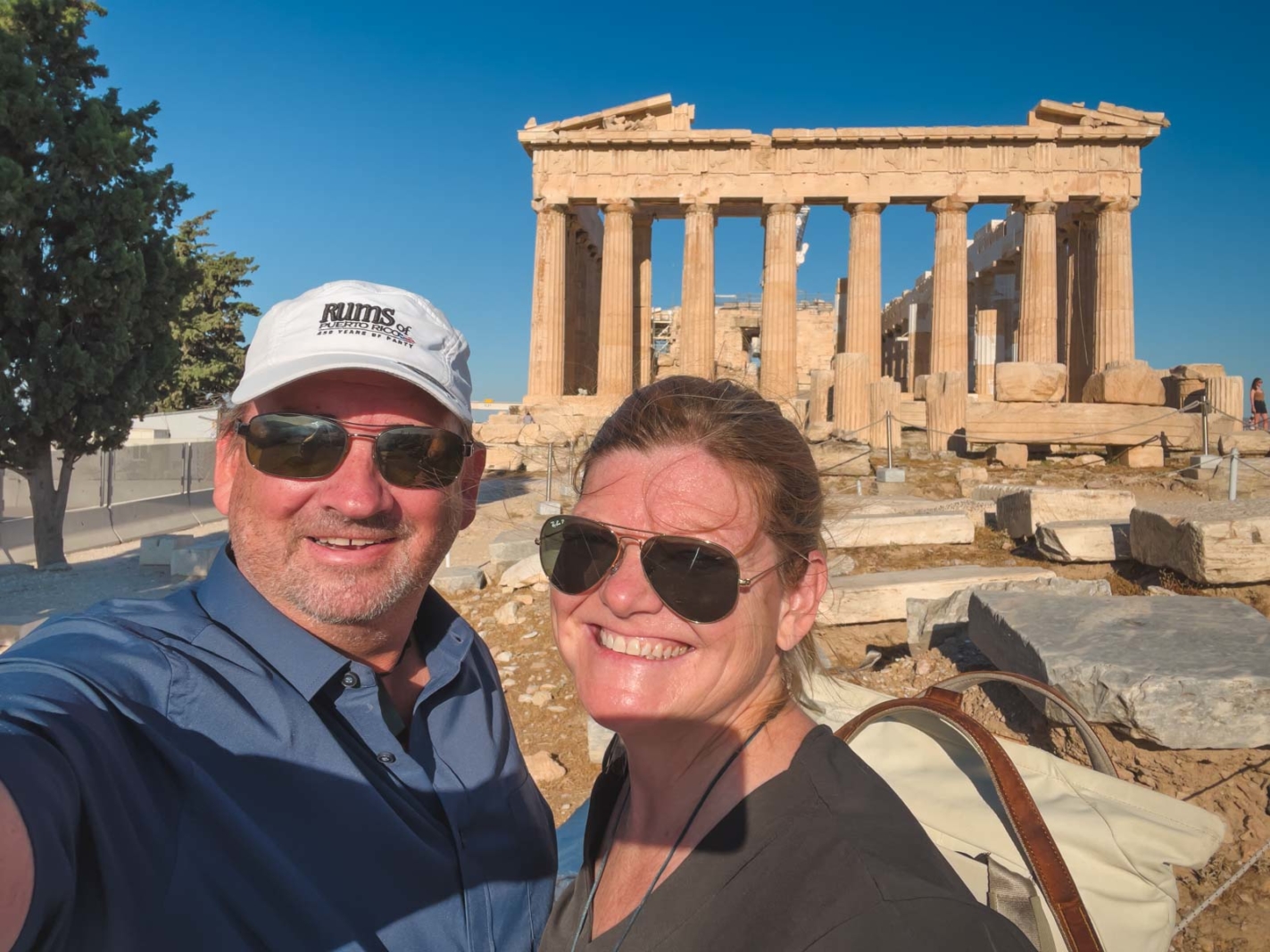
Since our last visit to the Acropolis, the city of Athens has made visitors slecect a mandatory timed entry. When booking tickets you can choose the time and date that you want to enter. And lucky you, you can enter the Acropolis 15 minutes before (or after) the time of your choice. We suggest booking as early as possible because, naturally, the crowds will be larger as the day goes on with people lingering on the Acropolis grounds long after their timed entrance.
You can book tickets in advance with Get Your Guide. We highly recommend booking 8 am to see the military march down after raising the flag and to be the first on the Acropolis grounds. We were first up the stairs and had the Acropolis all to ourselves!
Combo Tickets – Planning Your Visit to the Acropolis
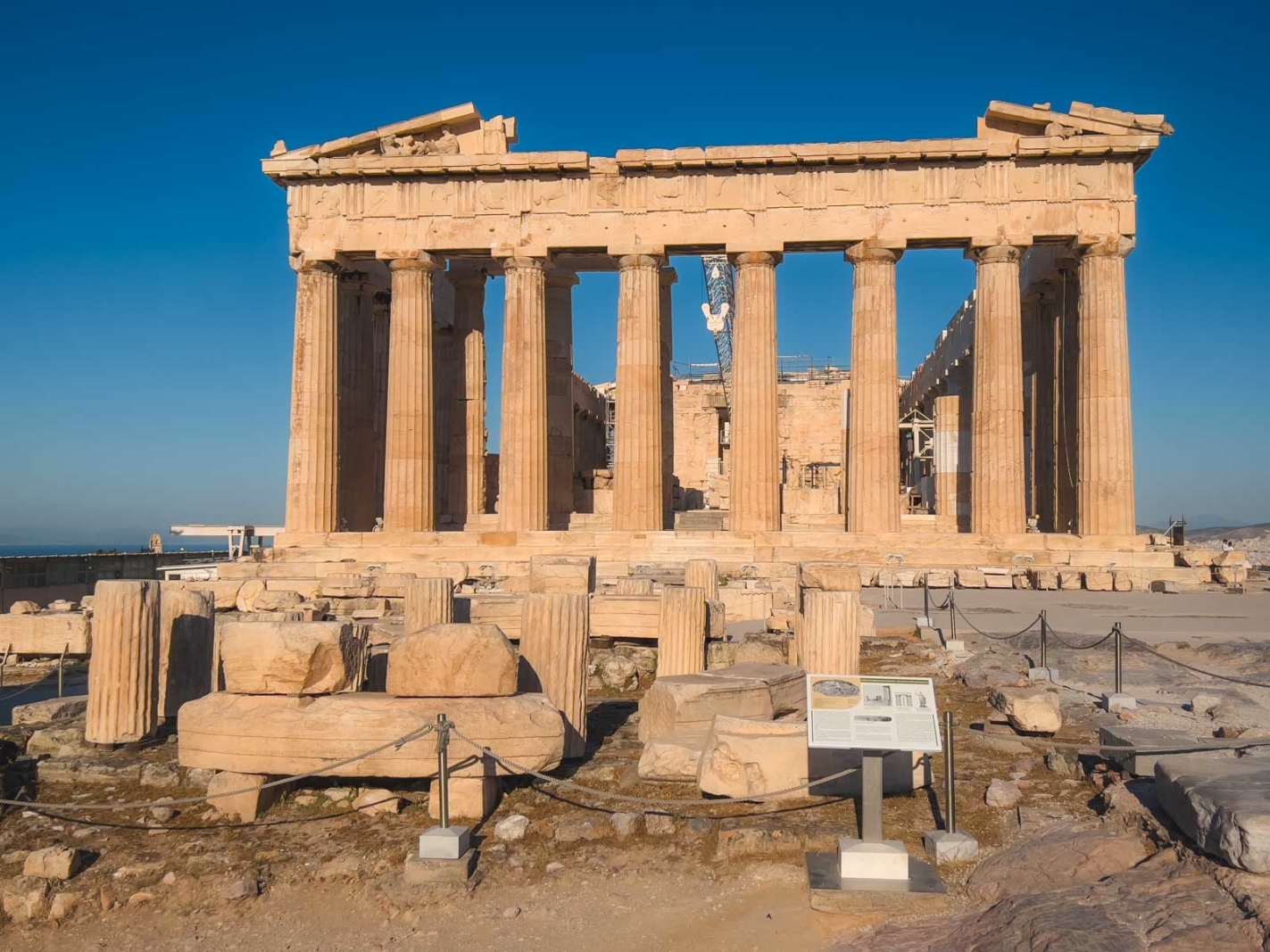
An Acropolis visit doesn’t have to break the bank, a standard entry ticket costs around €10, with reduced rates available for students and seniors. Prices can fluctuate, especially by season and combined tickets that include entry to other historical sites in Athens, so it’s worth checking the official website for the latest information. Purchasing tickets online in advance can save you time and spare you the hassle of long lines. You can book Acropolis tickets in advance here with an audio tour included.
We visited the Acropolis using the Acropolis plus Six Archeological Sites Combo . This is the best ticket for first-time visitors to Athens. It includes not only the Acropolis but also entry to the Roman Agora and Ancient Agora, as well as Aristotle’s School and the Keramikos Ancient Cemetery. Plus, access to Hadrian’s Library and the Temple of Olympian Zeus. Details here .
Opening Hours: Timing Your Adventure

The Acropolis is open daily from April to October from 8:00 AM to 8:00 PM, offering ample time to explore.
Winter hours shorten a bit, so plan accordingly. Remember, the last entry is usually an hour before closing, so give yourself plenty of time to wander and wonder.
Recommended Route and Where to Enter the Acropolis
We entered the Acropolis at the The Propylaea which is the most popular Acropolis entrance. If your timed entrance is first thing in the morning, we highly recommend this entrance as you will be first to see the Parthenon free from crowds.
If your entrance is later, start your visit at the Theatre of Dionysus, then move up to the Asclepieion and the Odeon of Herodes Atticus. Continue to the Propylaea, the monumental gateway that leads to the top of the Acropolis, where you can explore the Parthenon, the Erechtheion, and the Temple of Athena Nike. This route offers a logical progression through the site and ensures you don’t miss the highlights.
Highlights of Your Acropolis Visit
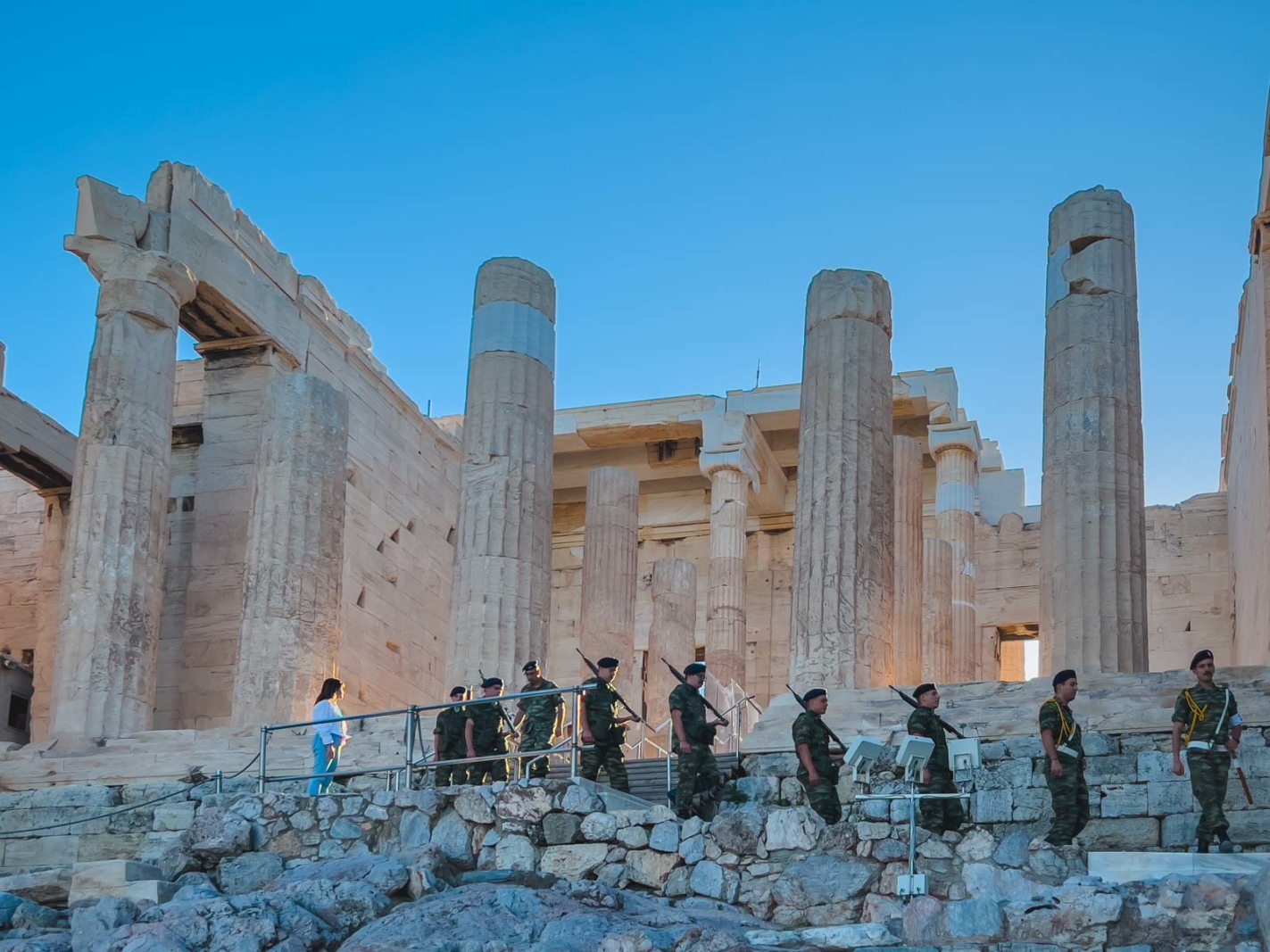
You cannot come to Greece without visiting the Acropolis. Athens is one of the world’s oldest cities, and the Acropolis has stood high above the city for more than 2,500 years. Many people think that the Parthenon is the Acropolis, but the Acropolis is actually an entire complex at the center of the citadel.
The Acropolis is considered one of the greatest architectural wonders in the world . There are many things to keep an eye out for during your visit, so let’s take a look at some highlights.
The Parthenon
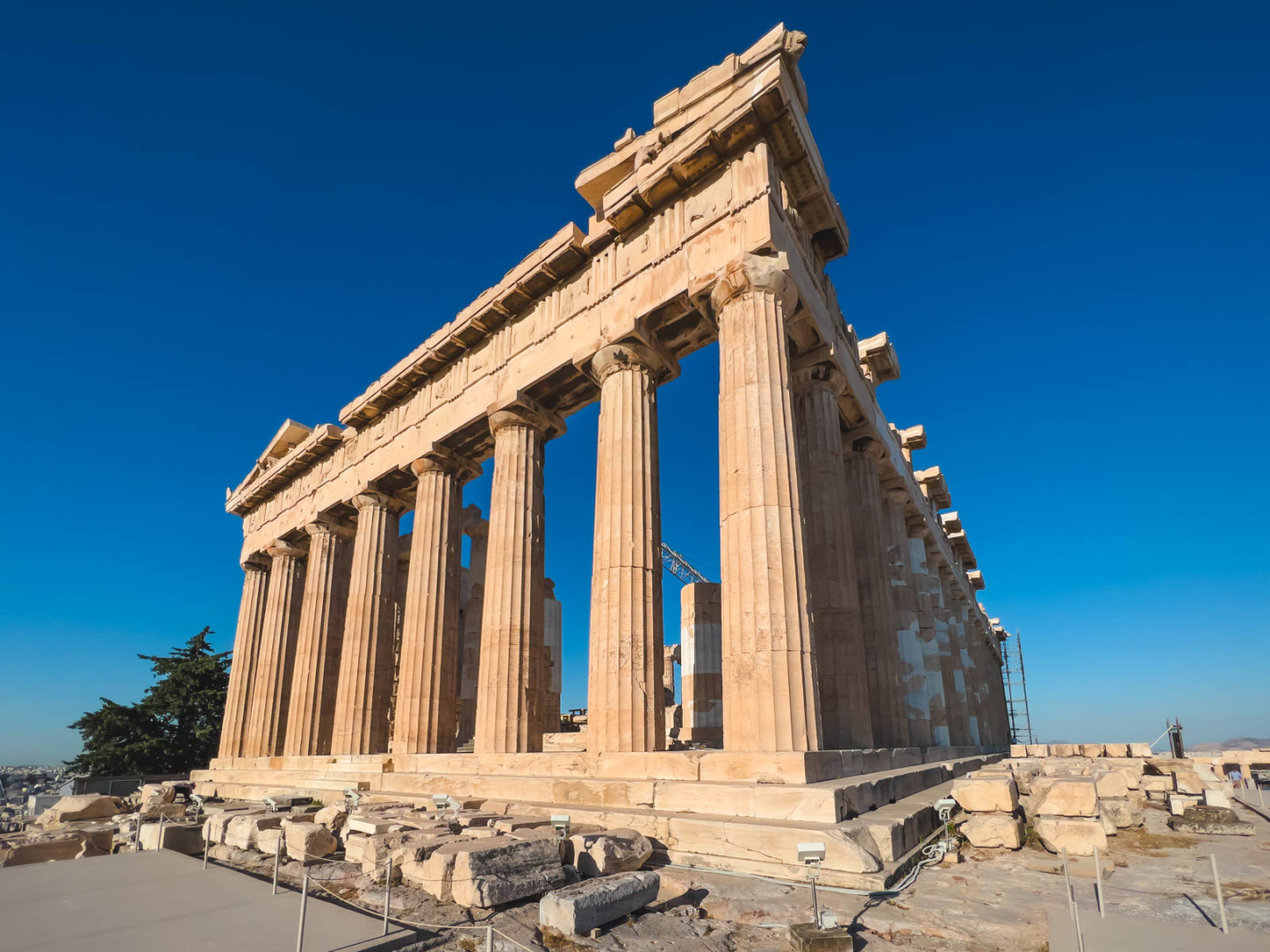
A “visit to the Parthenon” is non-negotiable. This temple, dedicated to Athena, the goddess of wisdom and war, is the epitome of Doric architecture and a symbol of the glory of ancient Athens. Its size, harmony, and the precision of its construction are a testament to the ingenuity of its creators.
The Parthenon is the most famous of the ancient ruins of Acropolis. It is the symbol of democracy dominating the hill of the Acropolis and dates back to the 5th century BC. But the Acropolis is filled with archeological wonders besides the Parthenon. On the grounds, you will also see The Temple of Athena Nike, and the Odeon of Herodes Atticus theatre.
Other temples to visit are the Propylea Temple of Nike, the Erechtheion Temple and you must see the Dionysus Theater. I learned of this theater while studying Greek Tragedies in theatre school, and it was amazing to see this famous theater. Also, don’t miss seeing the Odeon of Herodes Atticus and the sanctuary of Asclepius.
The Propylaea
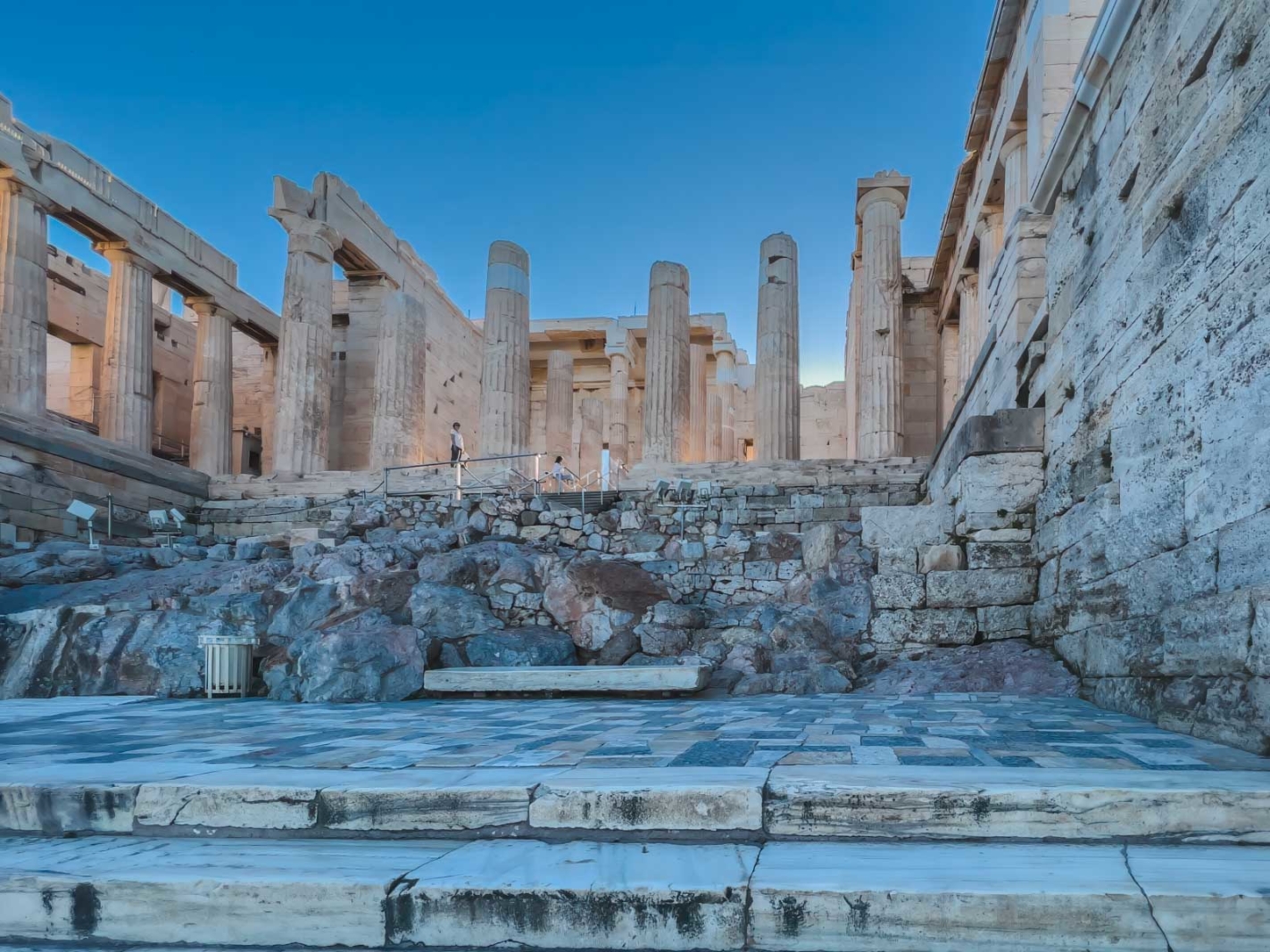
The grand entrance to the Acropolis sets the stage for what lies beyond. Walking through the Propylaea is like stepping back in time, with each step taking you closer to the heart of ancient civilization.
As you ascend the majestic pathways leading to the heart of the Acropolis, the Propylaea stands as a monumental gateway, inviting visitors into the ancient world’s most revered sanctuary.
Constructed between 437 and 432 BC under the guidance of the architect Mnesicles, the Propylaea was envisioned as a grand entrance, symbolizing the transition from the mortal world to the divine abode of the gods. Its architectural grandeur, with Doric columns and a meticulous design that balances aesthetics and function, captures the essence of Athenian democracy and artistic excellence.
Walking through this historic portal, one can almost hear the footsteps of ancient philosophers, statesmen, and pilgrims who entered the Acropolis with awe and reverence.
The Erechtheion
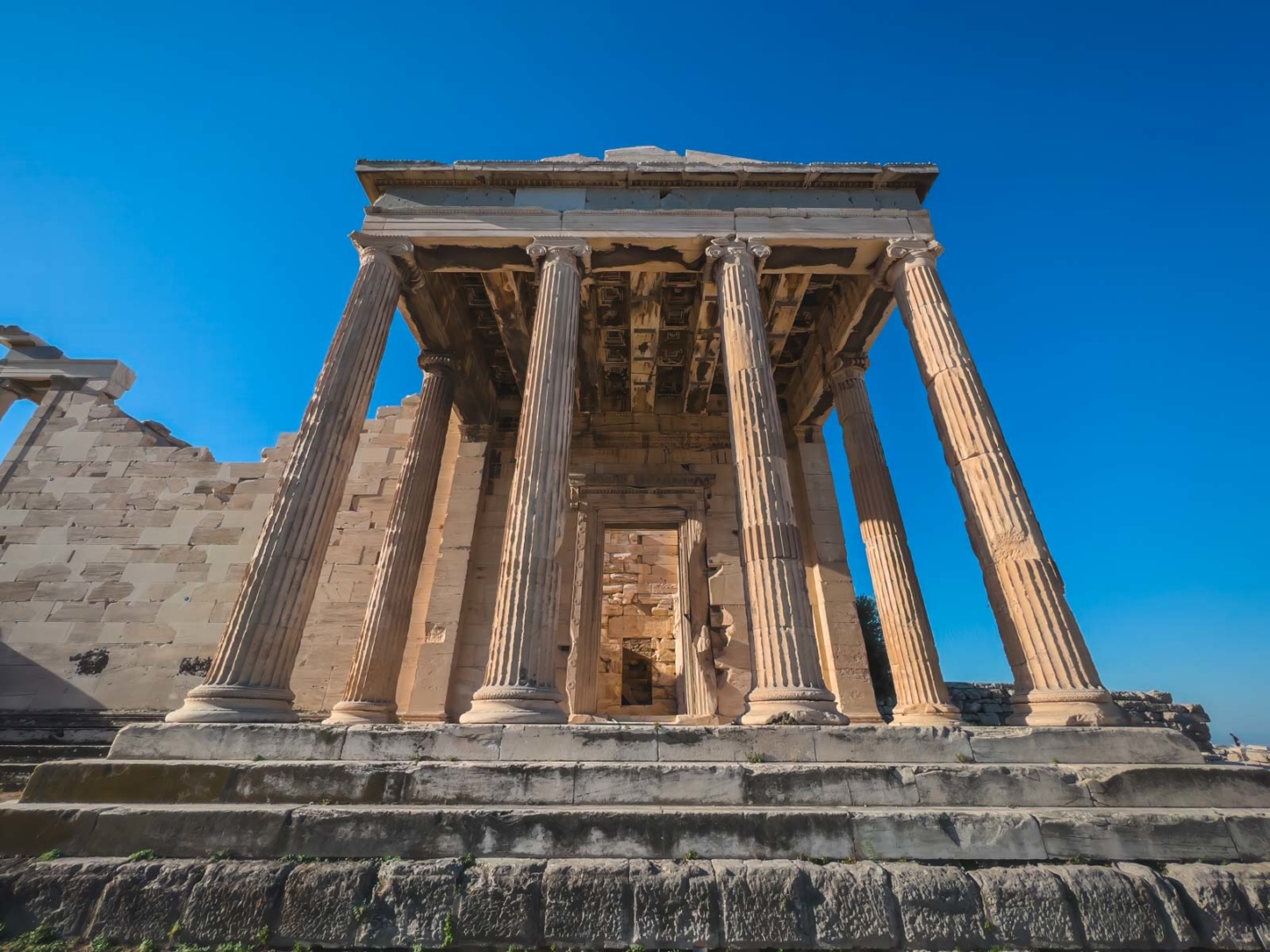
Located across the grounds from the Parthenon the Erechtheion is an exquisite temple, dating back to 421-406 BC. It stands out for its unique structure, the famous Porch of the Caryatids, where six gracefully carved female figures serve as architectural supports in place of traditional columns.
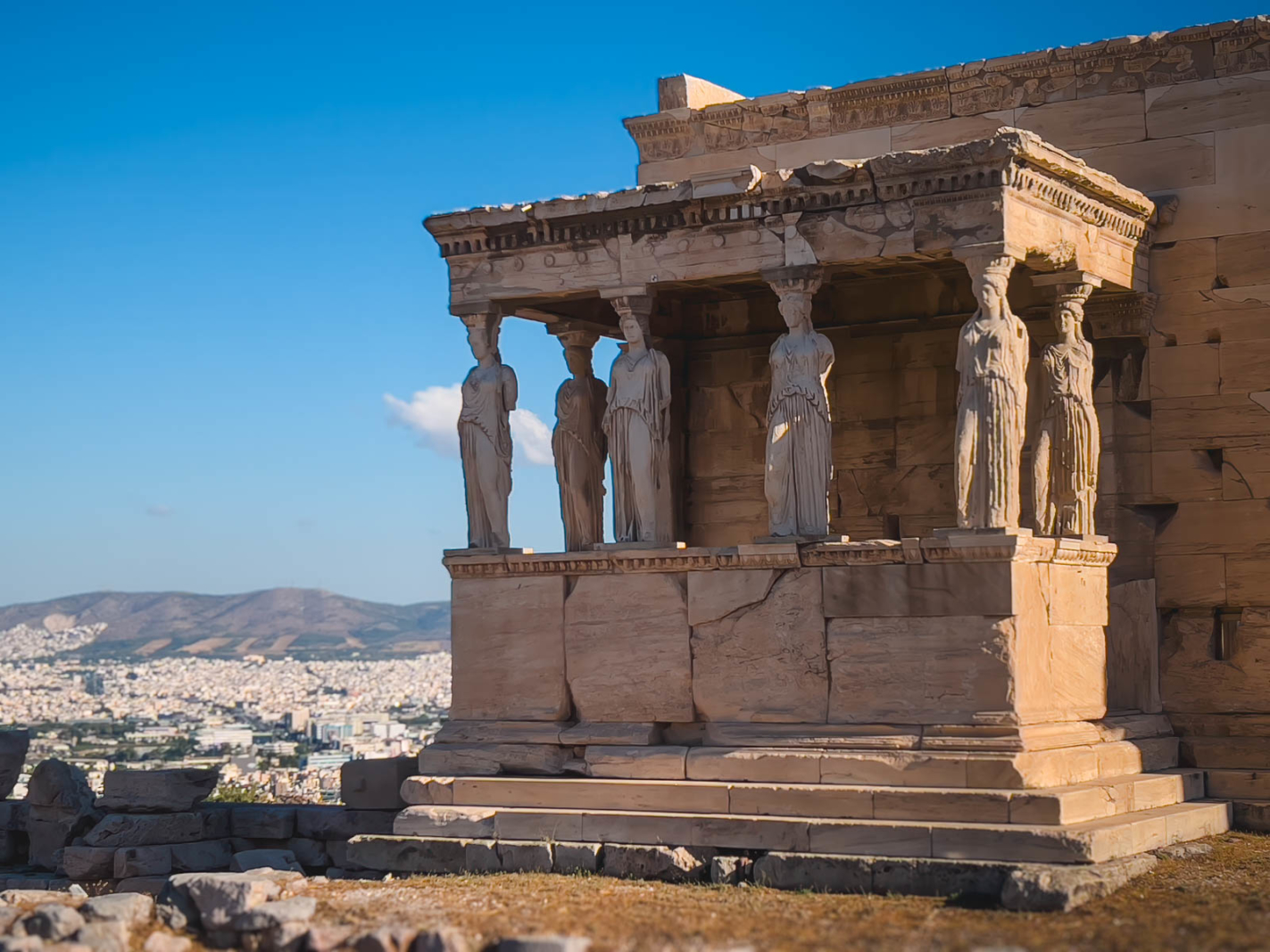
This temple, built to honor both Athena and Poseidon, hosted a sacred olive tree and a saltwater well that symbolized the contest between the two gods for the patronage of Athens. You will also want to visit Poseidon’s Temple when in Athens.
For those exploring the Acropolis, a visit to the Erechtheion is essential, offering insights into the complexities of Athenian worship and the architectural innovations that have influenced Western culture for centuries.
The Temple of Athena Nike
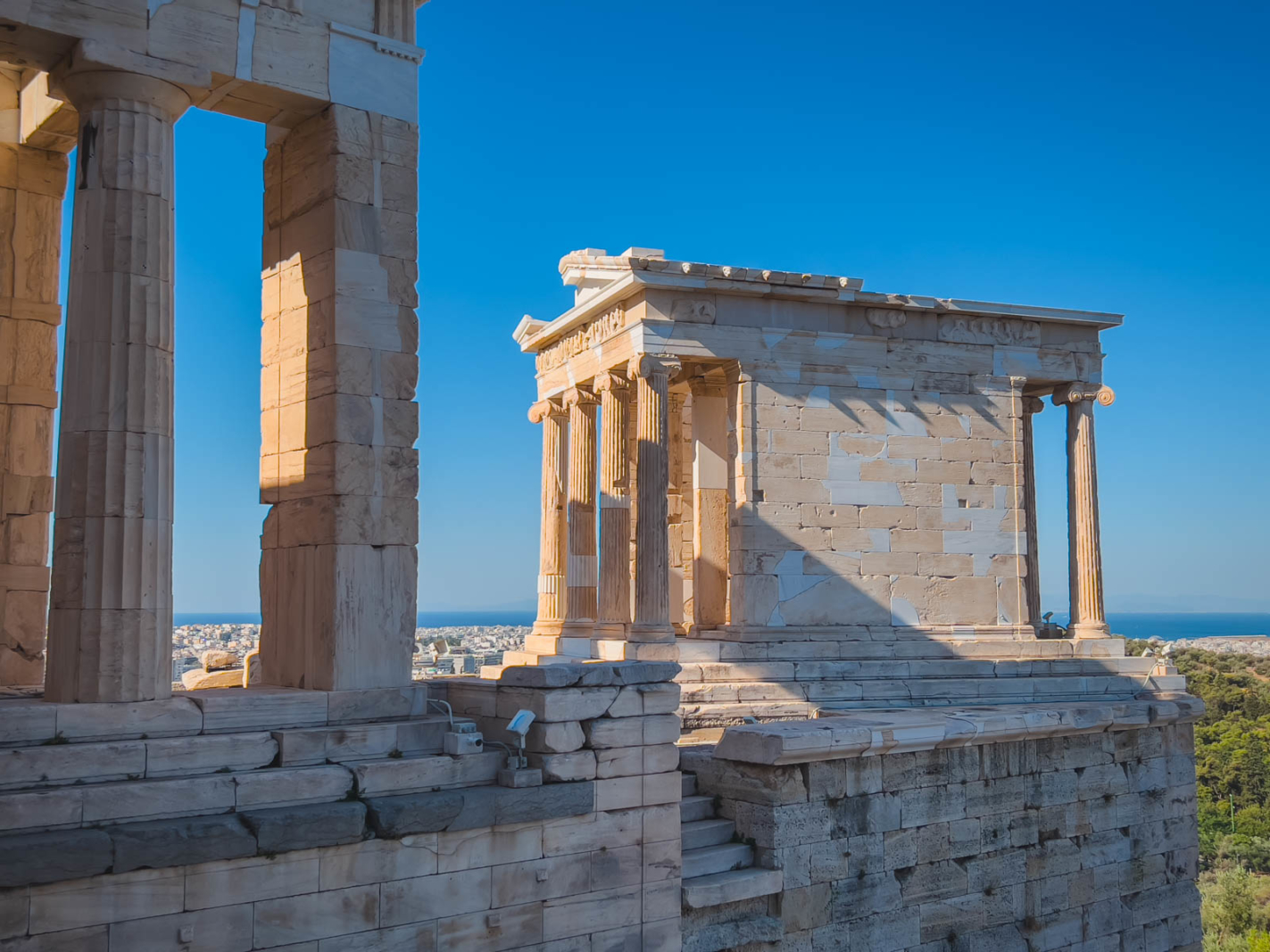
The Temple of Athena Nike is my personal favorite. It is a temple dedicated to the Goddess Athena and Nike Goddess. Athena Nike may be the smallest of the temples of the Acropolis, but I love its location standing on the edge of a high cliff.
This small yet significant temple is a beautiful example of Ionic architecture. Its delicate proportions and intricate details capture the eye and the imagination. Purchase skip the line tickets in advance to avoid queues.
Odeon of Herodes Atticus
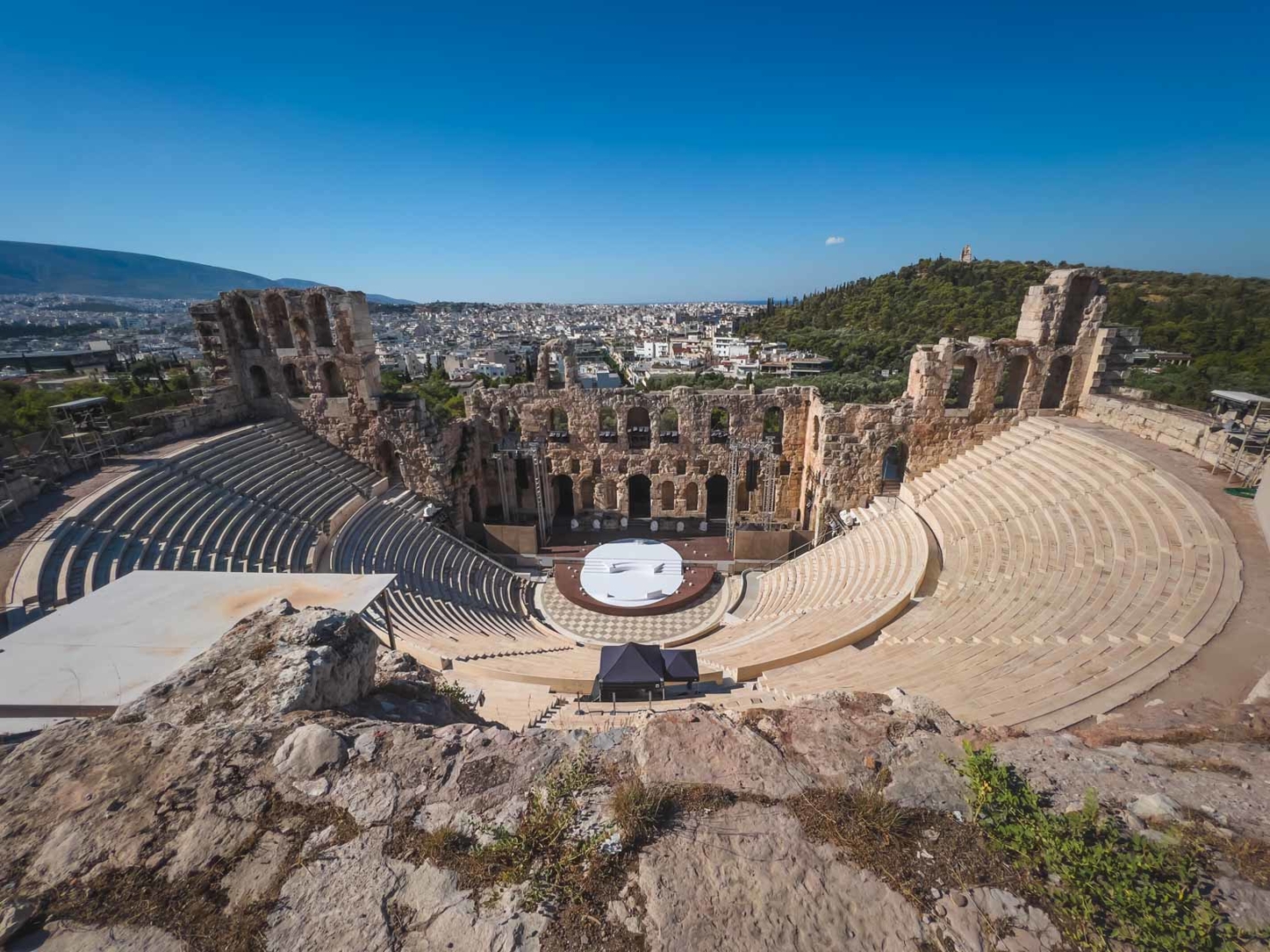
Odeon in ancient Greece was a building for singing and musical shows. In Athens, the Odeon of Herodes Atticus is the theatre that sits at the base of the Acropolis. To this day it hosts world-renowned artists, like the Foo Fighters in 2017 and Sting in 2018. See details of events at the Odeon here.
And did you know that it is still in operation? It is a once-in-a-lifetime experience to watch a concert in the oldest of venues among ancient ruins. The Odeon of Herodes Atticus is not only historic and intimate, but every seat offers great views of the stage. As part of the Epidaurus Festival every summer, the Odeon hosts dozens of concerts. Don’t be afraid to attend theatre events! Unless noted specifically, theater shows will have English subtitles.
Theater of Dionysus
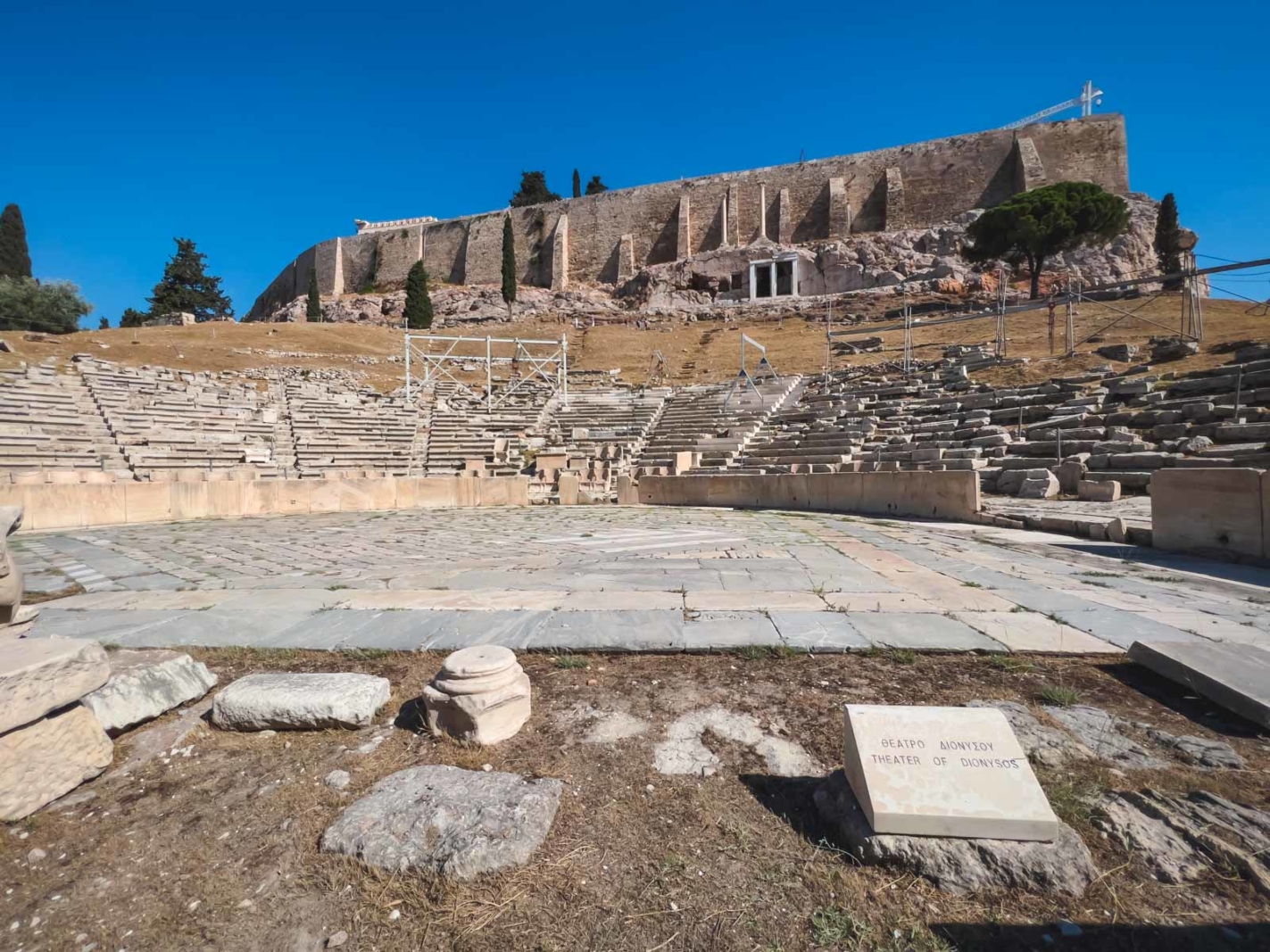
Nestled on the southern slopes of the Acropolis, you will pass the Theater of Dionysus on your way down. Make sure to stop and take a look, as you can get very close to its seats and on its stage.
As the birthplace of European theater, this historic site dates back to the 5th century BC and holds the distinguished title of being the world’s first theater.
It was here that iconic playwrights like Sophocles, Euripides, and Aristophanes debuted their timeless works to audiences of up to 17,000 people. The remnants of the theater, including its marble thrones and orchestra circle, whisper tales of a bygone era where art and democracy were in their nascent stages.
For those journeying through the Acropolis, pausing to immerse oneself in the atmosphere of the Theater of Dionysus is essential, offering a unique glimpse into the cultural heartbeat of ancient Athens. Stepping into the Theater of Dionysus, visitors are transported back to a time when drama and performance were not merely entertainment but a vital part of civic and religious life.
Tips for a Smooth Visit
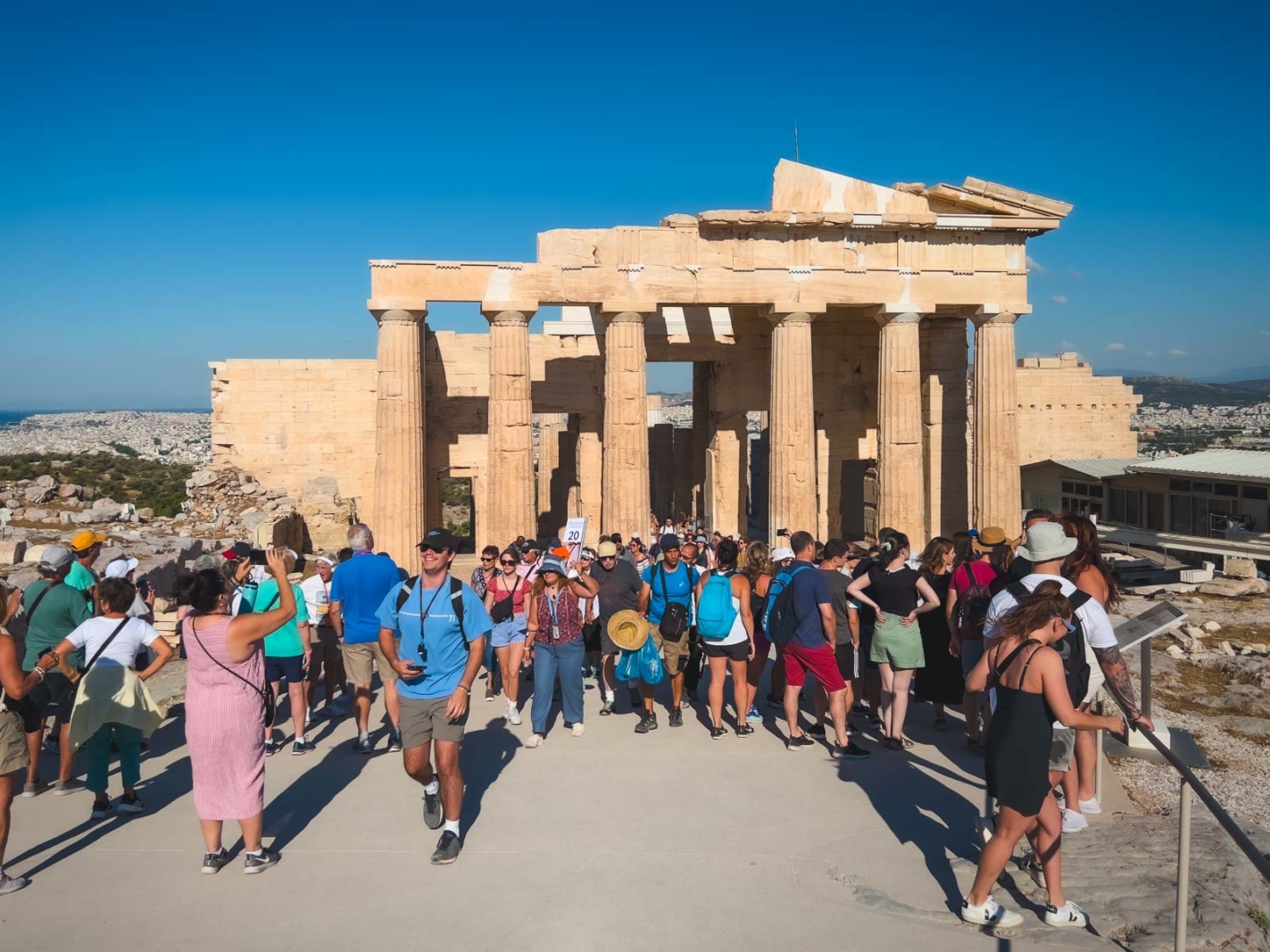
- Choose the Right Entrance : While most visitors use the main entrance on the west side, consider the lesser-known southeast entrance near the Acropolis Museum. This entrance typically has shorter lines and can save you time.
- Wear Comfortable Shoes : The paths around the Acropolis are uneven and can be slippery, especially the marble steps. Wear sturdy, comfortable shoes to navigate the terrain safely.
- Stay Hydrated : Athens can be hot, especially in the summer months. Bring a water bottle with you, as there are several refill stations around the site.
- Sun Protection Wear a hat and use sunscree : The heat can be intense, especially in summer, with limited shade available. I personally wear a portable neck fan.
- Follow the Recommended Route : Start your visit at the Theatre of Dionysus, then move up to the Asclepieion and the Odeon of Herodes Atticus. Continue to the Propylaea, the monumental gateway that leads to the top of the Acropolis, where you can explore the Parthenon, the Erechtheion, and the Temple of Athena Nike. This route offers a logical progression through the site and ensures you don’t miss the highlights.
- Many original statues and artifacts that were once part of the ancient buildings.
- Plan for the Sun : With limited shade available, wear sunscreen, a hat, and sunglasses to protect yourself from the sun.
- Capture the Best Views : For the best photos of the Acropolis, head to Areopagus Hill, located to the west of the Acropolis. This vantage point offers stunning views, especially at sunrise or sunset.
- Respect the Site : Remember that the Acropolis is not only a tourist attraction but also a significant cultural and historical site. Follow all posted signs and guidelines, and do not touch or climb on the ancient structures.
- Purchase Tickets in Advance : Buy your tickets online to avoid long lines at the ticket office. You can also consider purchasing a combination ticket, which includes entry to other historical sites in Athens.
- Hire a Guide or Use an Audio Guide: To fully appreciate the historical and cultural significance of what you’re seeing, consider a guided tour or an audio guide.
Beyond the Stones – Acropolis Museum
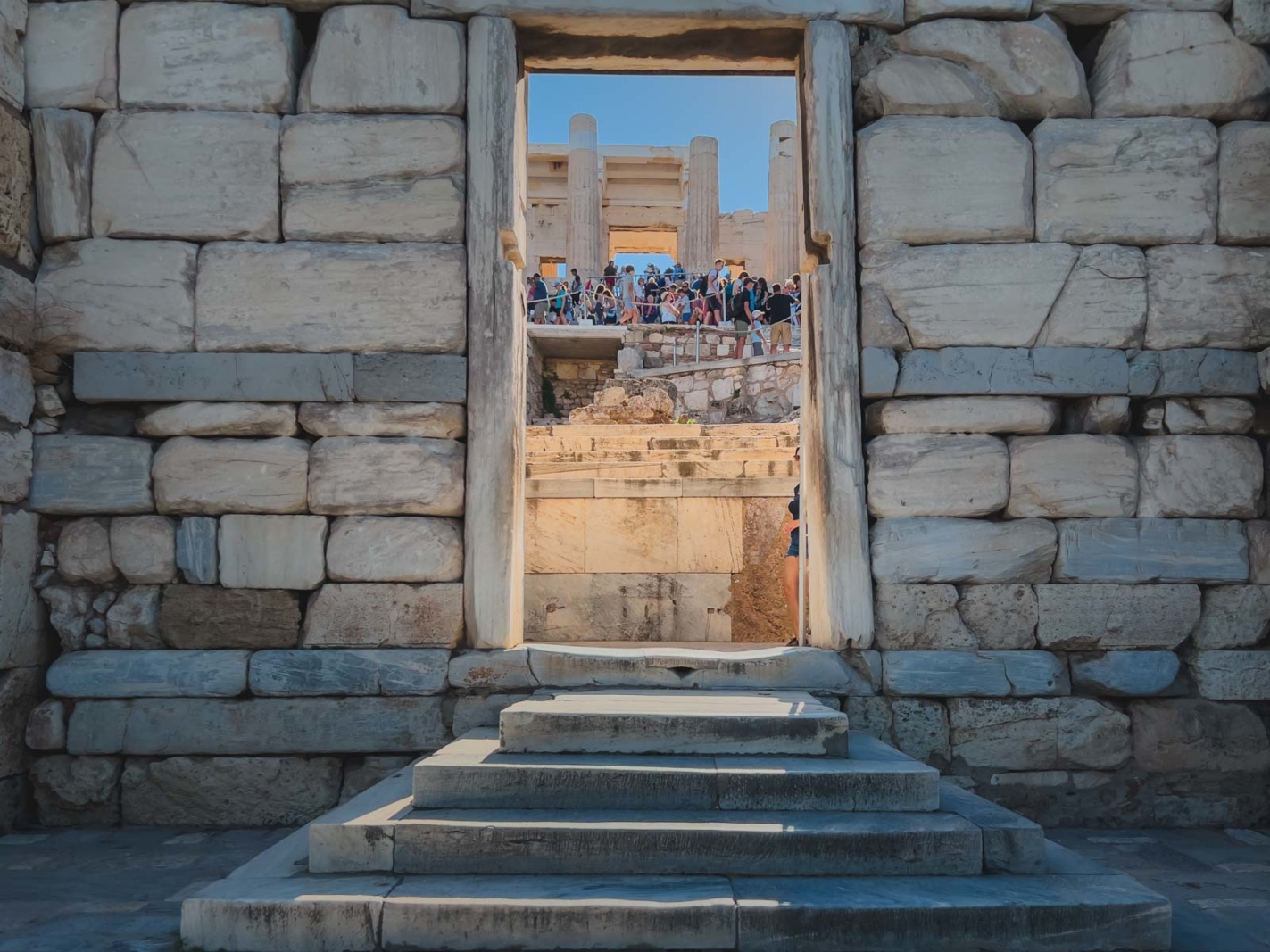
Visit the Acropolis Museum : To complement your visit and gain deeper insights into the history and significance of the structures you’ve seen, visit the Acropolis Museum. Located just a short walk from the Acropolis, the museum houses
How to Get to the Acropolis and Parthenon

The most efficient route is via the Athens Metro, with the Acropolis station on the Red Line (Line 2) serving as your direct gateway. Emerging from the station, you’re a mere stone’s throw from the archaeological marvel, with clear signage guiding you to the entrance.
For those who prefer to soak in the city’s ambiance, a leisurely walk through the historic Plaka district reveals the layers of Athens’ rich tapestry, leading you to the foot of the Acropolis hill. Along the way, charming cafes and shops offer a taste of modern Greek culture amidst the shadows of history. Whether you choose the speed of the metro or the allure of a walk through Athens, the journey to the Acropolis is an integral part of the experience, seamlessly blending the city’s ancient past with its vibrant present, ensuring that every visitor can reach this testament to human ingenuity with ease and enjoyment.
Visiting the Acropolis is more than a walk among ruins; it’s a journey through history, art, and mythology. As you stand on this ancient ground, looking out over Athens, you’re not just a tourist—you’re a part of the ongoing story of one of the world’s oldest cities. With these tips, your visit to the Acropolis and the Parthenon will be as enriching as it is awe-inspiring. Welcome to the cradle of Western civilization.
Check out these travel guides about Athens and Greece to plan your travels
- Where To Stay In Athens – A Guide To The Best Neighborhoods
- 23 Unique Things to Do in Crete
- Where to Stay in Santorini: Best Hotels and Towns
- 25 Best Things to do in Santorini, Greece
- The Ultimate Guide to Costa Navarino, Grece
- Things to do in Meteora Greece – MORE THAN MONASTERIES
- 25 Interesting and Fun Facts About Greece
- Ultimate Greek Food Guide – Traditional Dishes to Eat in Greece
- Pelion Greece – Visiting the Unknown Paradise of Greece
- Best Things to do in Halkidiki, Greece
- 16 Delightful Things to do in Skiathos, Greece
- Best Places to Visit in Greece
Travel Planning Resources
Looking to book your next trip? Why not use these resources that are tried and tested by yours truly.
Flights: Start planning your trip by finding the best flight deals on Skyscanner
Book your Hotel: Find the best prices on hotels with these two providers. If you are located in Europe use Booking.com and if you are anywhere else use TripAdvisor
Find Apartment Rentals: You will find the cheapest prices on apartment rentals with VRBO .
Travel Insurance: Don't leave home without it. Here is what we recommend:
- Allianz - Occasional Travelers.
- Medjet - Global air medical transport and travel security.
Need more help planning your trip? Make sure to check out our Resources Page where we highlight all the great companies that we trust when we are traveling.
You May Also Like

Where to Stay in Santorini: Our 2024 Guide to The Best Places

30 Best Things to Do In Greece in 2024

22 Best Things to do in Mykonos In 2024
About The Planet D
Dave Bouskill and Debra Corbeil are the owners and founders of The Planet D. After traveling to 115 countries, on all 7 continents over the past 13 years they have become one of the foremost experts in travel. Being recognized as top travel bloggers and influencers by the likes of Forbes Magazine , the Society of American Travel Writers and USA Today has allowed them to become leaders in their field.
Join thousands of others who get our monthly updates!
Leave a comment cancel reply.
Save my name, email, and website in this browser for the next time I comment.
2 thoughts on “The Ultimate Guide to Visiting the Acropolis and Parthenon in Athens (2024)”
Good tips to follow. Visiting Athens in two weeks.
Excellent guide, Thank you. We actually going to Athens in a month time so this will come in hand. thanks

Are You In?
Join our mailing list and receive the latest news and travel offers from our team. don’t worry, we hate spam as much as you do.
Discovering Athens’ Crown Jewel: The Ultimate Visitor’s Guide to the Acropolis Museum
- Last Updated on: Jan 25, 2024
- Read Time 13 mins
- Published: Feb 1, 2022
We Need Your Support!
We want to remind you that Athens by Locals is reader-supported. By booking tours, hotels, tickets, and other travel services through the links on our website, you can help us continue providing valuable content and information. Note that we receive a small commission only if you make a booking using our links at the time of your visit. So, if you're not quite ready to book yet, you can save this post and the links and return to make your booking when the time is right. We genuinely appreciate your support and are thrilled to have you in our travel community. Please don't hesitate to reach out if you have any questions or need assistance. Happy travels!
The Acropolis Museum is undoubtedly one of the best modern museums in the world. Located just a stone’s throw away from Acropolis Hill and the Parthenon, it stands imposingly over the famous pedestrian street called Dionysiou Aeropagitou and the neighborhood of Koukaki.
We won’t tell you that a visit to one of the best museums in Athens is almost mandatory for any visitor to the city – you already know that. Instead, we’ll provide an extensive guide with all the museum highlights, information on the opening hours and tickets, insider tips, and everything you need to make your visit as smooth as possible.
Your ultimate guide on how to visit the Acropolis Museum starts here.
A First Glance at the Acropolis Museum
Surrounded by olive trees and perched on concrete columns that support the magnificent glass panes of the upper floors, the building that houses the Acropolis Museum has become an attraction in its own right.
It was designed by New York-based architect Bernard Tschumi in collaboration with local Greek architect Michael Photiadis and opened its doors in 2009, instantly becoming one of the most popular attractions of the city .
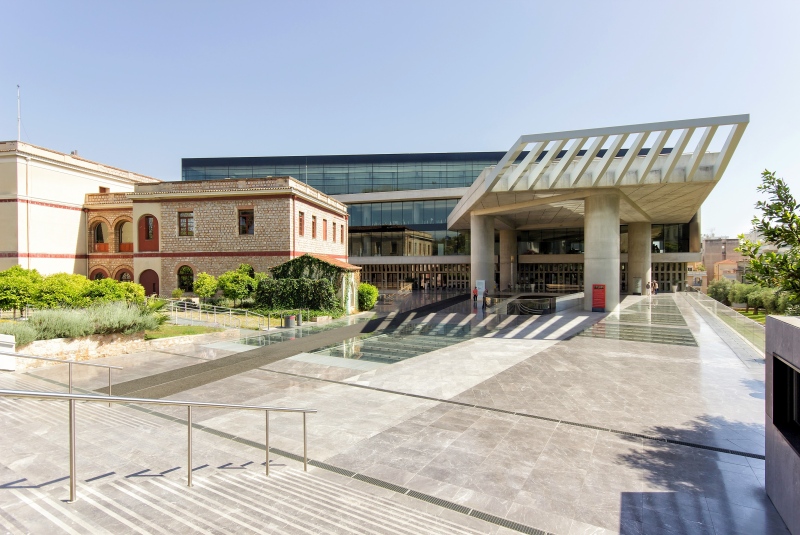
The Acropolis Museum is mainly devoted to exhibiting artifacts that were found in or around Acropolis Hill and the Parthenon, yet its collection also includes historical objects from other sites in Attica like the Temple of Artemis.
Book your skip the line ticket to the Acropolis Museum now
The impressive museum occupies an area of 14.000 square meters and boasts a vast collection of more than 4.000 exhibits spread over four different levels.
Below, we’ll go over the highlights of each level separately.
Tip : Before visiting the Acropolis Museum, download the museum map for free here .
Heads Up : If you are planning to visit the must-see archaeological sites in Athens, plus the Acropolis Museum, buy the Athens Pass and save some money.
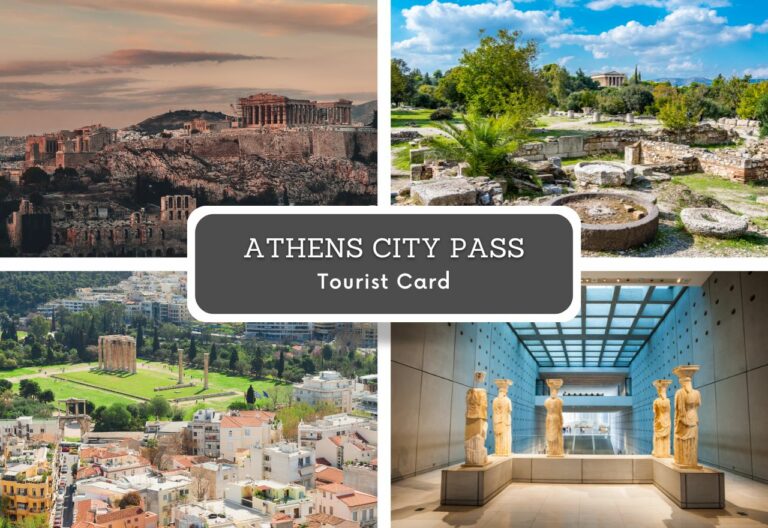
Athens Pass Tourist Card: Skip-the-Line Tickets for All the Must-See Attractions in Athens
What to see: highlights of the acropolis museum.
The Acropolis Museum is housed in a 4-floor building with exhibits arranged in chronological order so that moving up the floors feels like a journey through time, narrating stories from thousands of years ago.
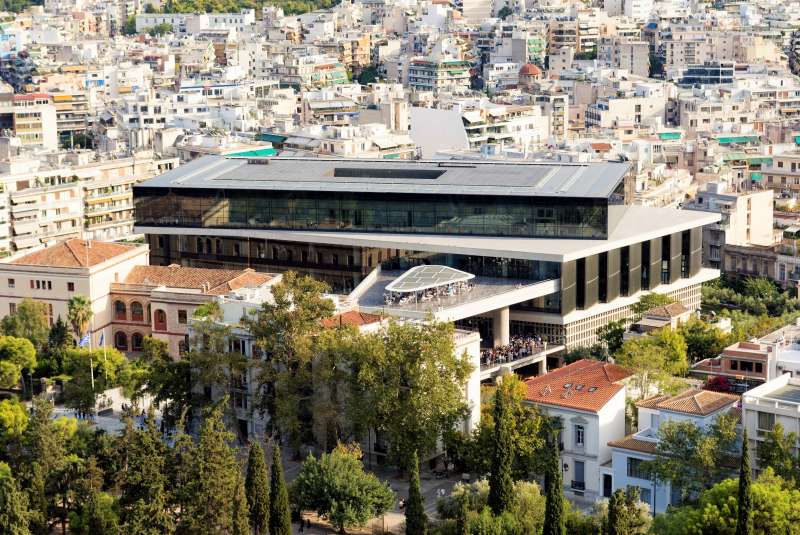
Before starting your own journey through the museum, visit the foyer and check out the miniature replicas of the Acropolis that represent different moments in time.
That will certainly help you put everything you will see in a timeframe.
Tip: If, for whatever reason, you don’t have time to go through all the floors, start your tour from the top floor of the museum so that you don’t skip the museum’s absolute highlight – the majestic views of the Parthenon and the ruins of Acropolis Hill.
Basement Level: Archaeological Excavation
The museum’s basement level is actually a real excavation site that uncovered an entire ancient Athenian neighborhood that is as large as the building itself.
The remains can also be seen through glass panes on the upper floors, but visiting the site up close is a whole different experience.
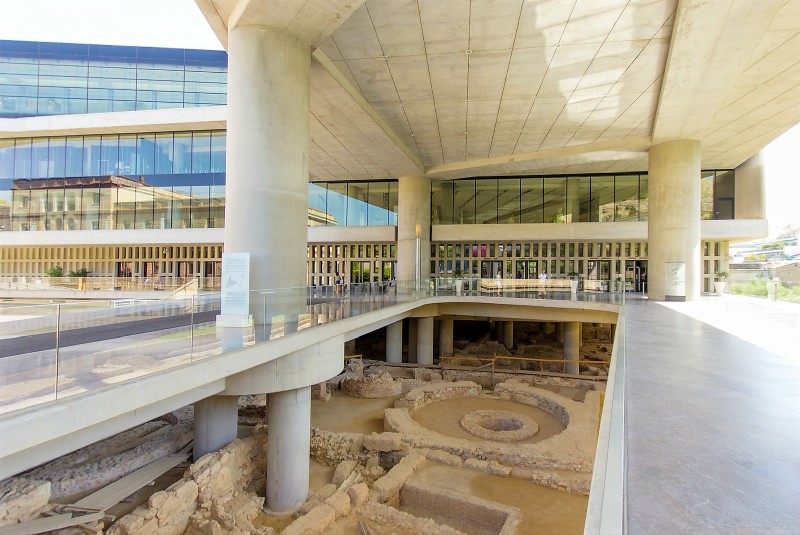
The ancient settlement features visible villas, bathhouses, workshops, tombs, mosaics, and even a drainage system.
You won’t find a more insightful way to perceive ancient Athens’s life from the Classical era to the Byzantine period.
Keep in mind that the opening hours of the excavation site are slightly different than those of the rest of the museum. You can find all opening hours at the end of the guide.
Don’t miss: The circular tower hall in Building E
Ground floor: Slopes of the Acropolis
The next floor is no less spectacular. The Gallery of the Slopes of the Acropolis is housed in an angled rectangular hall that symbolizes the ascent to the Sacred Hill of the Acropolis.

Here you’ll get the chance to marvel at ancient ruins, artwork depicting scenes of everyday life in ancient Athens as well as artifacts such as jewelry, vases, and bottles dating back to the Neolithic period.
Don’t miss: The sculpture of Papposilenos and the pillar with the dedication to Asklepios
First floor: Archaic Acropolis
The first thing you’ll see in the Archaic Acropolis Gallery is impressive sculptures and marble statues of the Archaic Period (7th – 5th century BC), many of which were gifts to the city’s patron goddess, Athena.
Moving on, you’ll find even more spectacular exhibits like the remains of the Hekatompedon, the temple that stood on Acropolis Hill before the Parthenon.
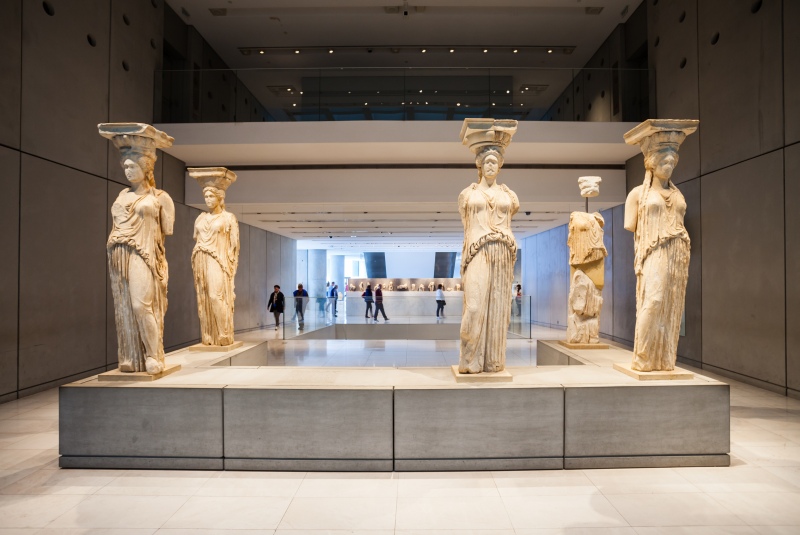
Next up, the famous female-figure statues called Caryatids (notice the purposefully vacant spot – the sixth Caryatid currently belongs to the British Museum) that used to hold the Erechtheion.
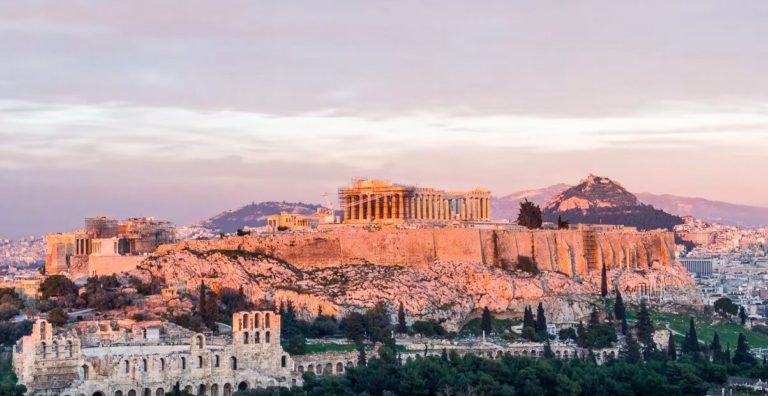
Exploring the Heart of Ancient Greece: A Visit to the Acropolis of Athens
Finally, make sure to spend some time enjoying the votives and statues found around the Acropolis that depict famous men, Gods, and heroes from later periods.
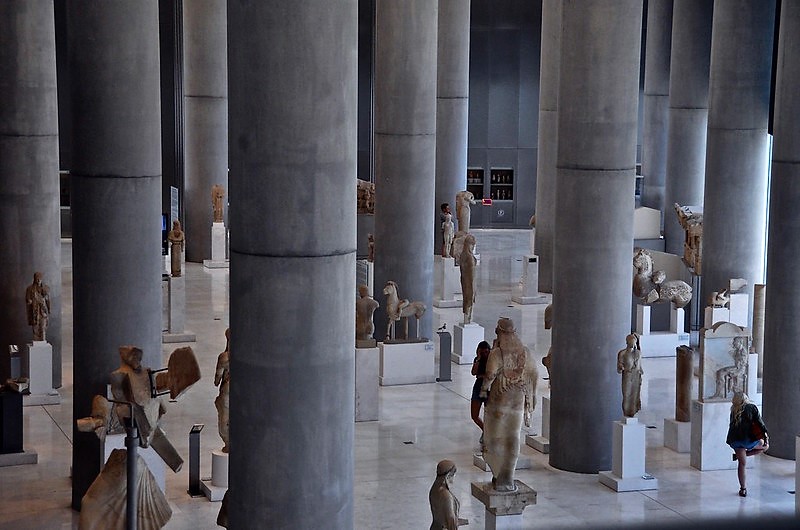
Don’t miss : the Pediment of the Hekatompedon, the Caryatids, the sculpture of the winged goddess Nike, the portrait of Alexander the Great
Top floor: The Parthenon Gallery
The top floor of the museum is undoubtedly its most spectacular feature. The whole floor is dedicated to the city’s crown jewel: the Parthenon.
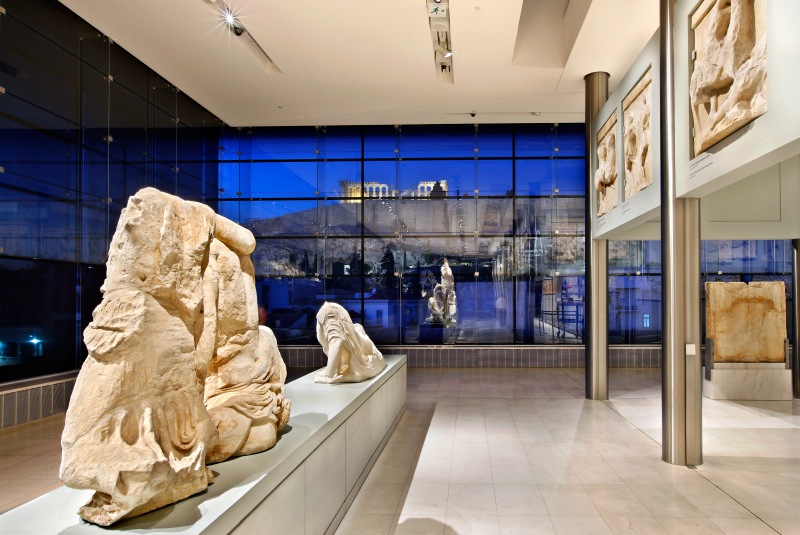
Here, you can see three of the most fundamental architectural components of the ancient temple: the metopes, the pediments, and the frieze, while having a magnificent view of the Parthenon itself right in front of you.
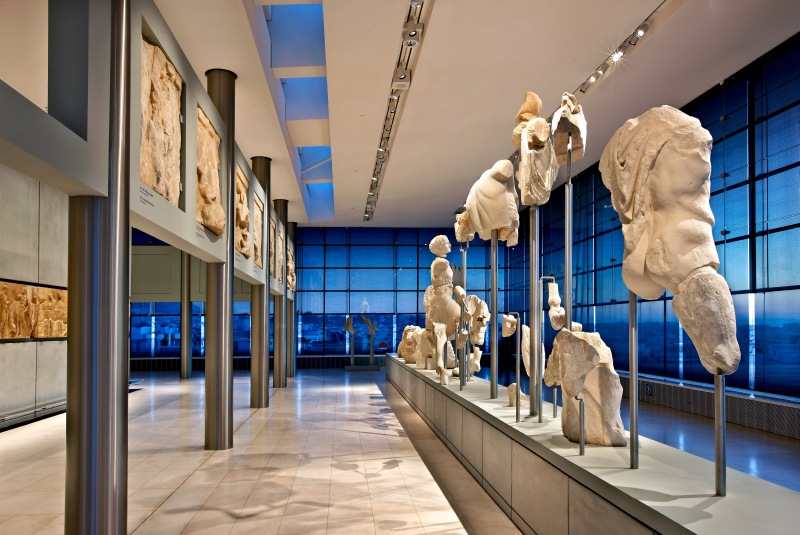
The structures are complete with masterfully crafted replicas of the missing parts that will give you a new perspective on what the Parthenon actually looked like in ancient times.

At the top level of the Acropolis Museum, the Parthenon Gallery is more than awesome. Try to spend most of your visiting time there. You’ll be amazed.
Don’t miss : Anything!
The Cafe and Restaurant of the Acropolis Museum
The museum’s cafe is located on the ground floor, featuring a spectacular terrace that overlooks the archaeological excavation site below.
It serves breakfast, hot and cold beverages as well as traditional Greek hot dishes, refreshing beverages, and delicious desserts.
The cafe follows the opening hours of the museum, with the last orders accepted 30 minutes prior to the museum’s closing time.
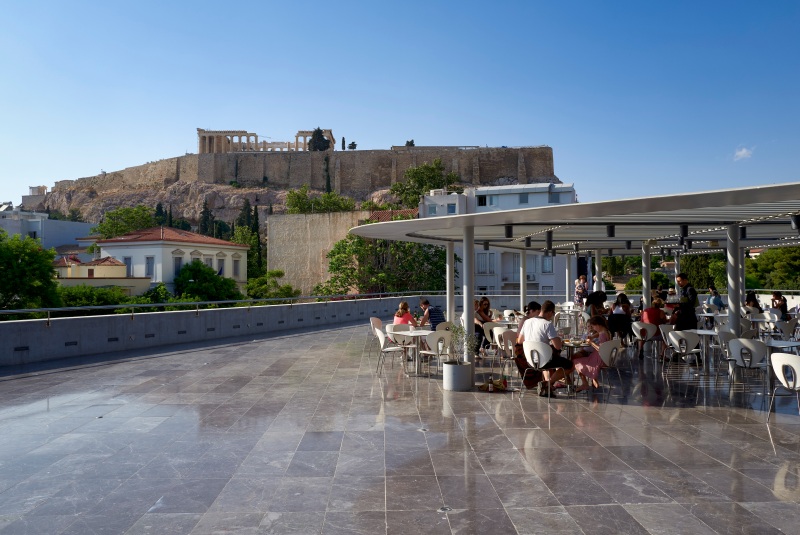
The museum’s restaurant occupies most of the second floor with a magnificent dining area that offers unobstructed views of the Acropolis.
It serves traditional Greek dishes and eclectic wine. Contrary to the cafe, the restaurant remains open until midnight on Fridays and Saturdays to offer a special menu with dishes based on seasonal local products.
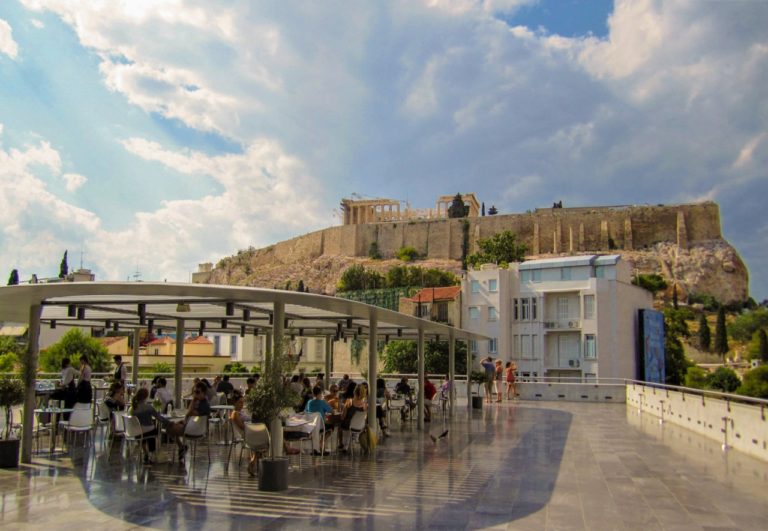
Splendid Museum Restaurants and Cafés in Athens
Activities and events at the acropolis museum.
Apart from all the magnificent exhibits, the Acropolis Museum is known for hosting many exciting activities, events, presentations, archaeological walks, and gallery talks in Greek and English.
As a visitor, you are allowed to attend such an event, without any extra cost, simply by paying the normal admission fee to the museum.
Keep in mind, however, that there is a limit of 20-30 visitors per activity.
In order to join, you’ll have to register at the front desk.
The average duration for any activity organized by the museum is one hour.
You can find out what activities you can join during your visit here and here .
Visiting the Acropolis Museum With Kids
You might think that visiting a museum with kids could be a bad idea since younger visitors tend to get bored a bit more easily, but in this case, you would be wrong.
The Acropolis Museum offers all kinds of programs, festivities, and events specially designed for children. You can find them all here .
Also, to make your visit even easier, you can ask for a family audioguide, a “family backpack” filled with toys, maps, educational puzzles, and other goodies, or even print out your own “family trail”, an exploration booklet that will guide and help children appreciate the exhibits.
All of these are free of charge.
Finally, make sure to pay a visit to the LEGO model of the Acropolis – a miniature built with 120.000 bricks.
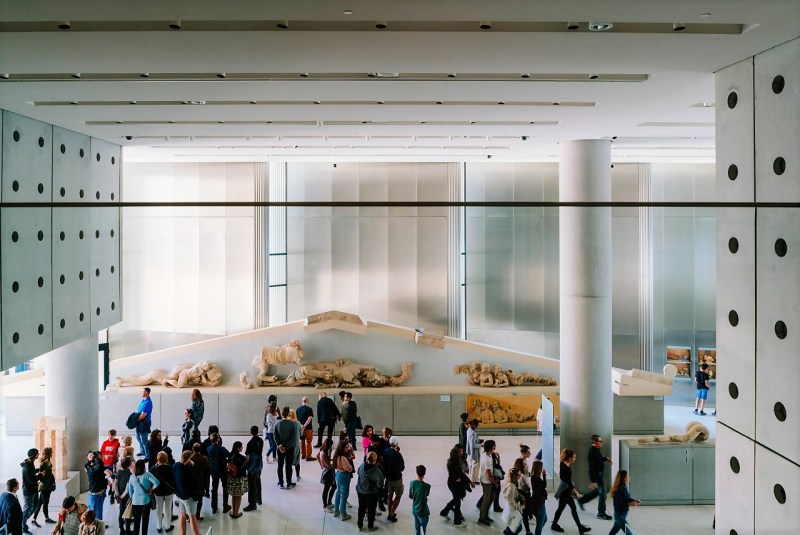
Shops in the Acropolis Museum
The museum has two shops: a gift shop and a bookstore. The former is located on the ground floor while the latter is found on the second floor.
Make sure to pay each a short visit to discover various books, interesting gifts, and memorabilia to take back home.
You’ll also find exact cast replicas of some exhibits that are crafted in the museum’s conservation lab that will make for awesome souvenirs. Both shops close 15 minutes prior to the museum’s closing time.
Visiting the Acropolis Museum with a Guided Tour
The Acropolis Museum is one of the most visited attractions of the city.
Naturally, countless tours list it in their itinerary. And one of the most frequent questions we receive very often here at Athens by Locals is this:
“Is it worth it to visit the Acropolis Museum with a guide?”
The answer is always a resounding yes .
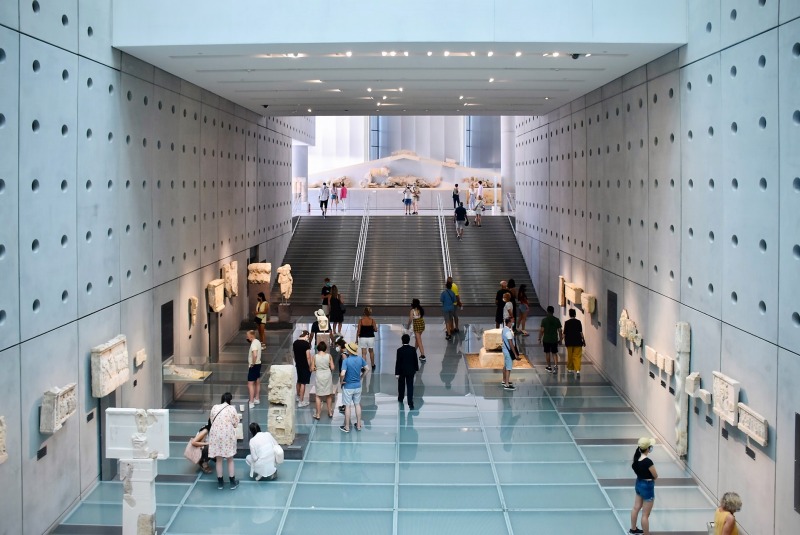
This way, not only you’ll be able to skip the lines and not waste your time waiting in queues but you’ll also get the chance to get a better understanding of the museum’s exhibits and learn about the city’s history. As for the best-guided tour out there, don’t fret.
We have already screened all the tours and we’ve got a few excellent recommendations. Just click the links below, check their reviews, and book your tour on Get Your Guide.
Combine a visit to the Acropolis and the Acropolis Museum
How to Get To the Acropolis Museum
Due to its central location, getting to the Acropolis Museum from any place downtown is going to be a breeze. You have plenty of options:
- On foot: You can easily walk to the museum from most central neighborhoods of Athens like Syntagma, Monastiraki, Thisseion, and Koukaki.
- By metro, get off at Acropolis station (red line). The entrance of the museum is only a couple of minutes away.
- By bus: The stop closest to the museum is called Makrigianni. To get there, you can get numerous bus lines (24, 40, 57, 103, 106, 108, 111, 126, 134, 135, 136, 137, 155, 206, 208, 227, 230, 237, 790, 856, Α2, Α3, Α4, Β2, Β3, Β4, Ε2, Ε22)
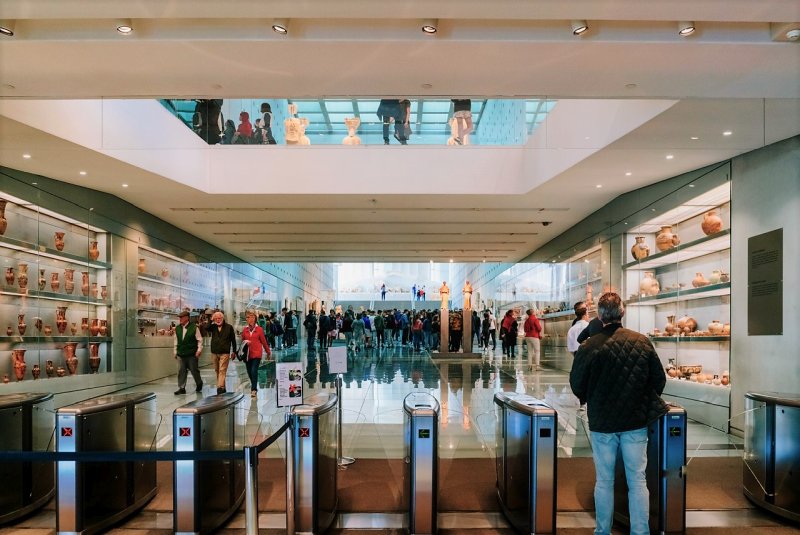
Accessibility
The Acropolis Museum is accessible to wheelchair users and people with mobility impairments. There are wheelchair ramps at every entrance, elevators, and accessible WCs on every floor. In addition, wheelchairs can be borrowed at the front desk, and guide dogs are allowed in the museum.
Opening Hours and Tickets
Winter season (1 November – 31 March)
- Monday to Thursday: 09:00 – 17:00
- Friday: 09:00 – 22:00
- Saturday & Sunday: 09:00 – 20:00
Archaeological excavation site:
- Monday to Sunday: 09:00 – 17:00
- General admission: 5 euros
- Reduced admission: 3 euros
Summer season (1 April – 31 October)
- Monday: 08:00 – 16:00
- Tuesday to Sunday: 08:00 – 20:00
- Friday: 08:00 – 22:00
- General admission: 10 euros
- Reduced admission: 5 euros
1 January, Easter Sunday, 1 May, 25 December, 26 December
Limited hours:
Christmas Eve & New Year’s Eve 09:00 – 15:00, Orthodox Good Friday 12:00 – 18:00, Orthodox Holy Saturday 08:00 – 15:00
Extended closing time until midnight:
The evening of August full moon, European Night of Museums
Free admission days:
6 March, 25 March, 18 May, 28 October
Frequently Asked Questions About the Acropolis Museum
Is the acropolis museum worth it.
Definitely yes . The Acropolis Museum is one of the most intriguing attractions in Athens and one of the most important museums in Europe.
Why is the Acropolis museum famous?
Apart from the astonishing architecture of its building, the Acropolis Museum is famous for holding some of the most important surviving artifacts from ancient Greece.
Is the Acropolis Museum the same as the Acropolis?
No . This is a common mistake among international travelers. Acropolis is the name of the hill on which the Parthenon stands. The Acropolis Museum is located a few minutes away from the Hill.
Does the Acropolis ticket include an entrance to the museum?
No . No ticket to the Acropolis Hill will also grant you access to the Acropolis Museum.
Can you use a credit card to buy a ticket?
Yes , you can either pay for admission in cash or with any credit card.
Should I buy Acropolis tickets in advance?
Yes . We strongly recommend that you book your tickets in advance , especially if you are visiting during peak season (May-September) to avoid having to wait in long queues.
How long does it take to visit the Acropolis Museum?
On average, visitors spend around 1,5 hours in the museum. We recommend that you have at least 2 hours to spend in the museum to go over the exhibits at a leisurely pace.
Does the Acropolis Museum have a cloakroom?
Yes, the Museum has two different cloakrooms, both on the ground floor.
Are photos allowed in the Acropolis Museum?
Photography and filming are allowed in all areas except the Archaic Acropolis Gallery on the first floor. The use of flash, however, is strictly prohibited.
To sum it all up, the Acropolis Museum is an attraction you cannot afford to miss on your visit to Athens.
Apart from a magnificent spot to enjoy the view of the Parthenon from a vantage point, the marvelous exhibits and the astonishing excavation site below will give you a perspective of ancient Athens like no other spot in the city.
A Quick Reminder:
Remember that Athens By Locals is here to guide you with planning the perfect trip to Athens and help you every step along the way. If you didn’t found what you’re looking for, or need any recommendations about your trip to Athens, feel free to contact us and we will do our best to help you. Please be as more detailed as possible regarding your subject so as to help you better.
If you like what you read please scroll down at the end of this page and subscribe to Athens By Locals so next time to receive more articles like this straight forward to your email. Join us on Facebook for comments, photos, and other fun stuff. If you enjoy this article please share it with your friends on Facebook.
Athens By Locals
THIS ARTICLE WAS WRITTEN/EDITED BY A TEAM MEMBER OF ATHENS BY LOCALS
Related Posts

Discover the Wonders of Art: A Visit to the National Gallery of Athens

A Glance of the Past: The National Archaeological Museum of Athens

Exploring the Cultural Treasures of Athens: A Comprehensive Guide to the Museums of Athens
Copyright © 2024 Athens By Locals © All rights reserved. No part of this site may be reproduced without our written permission. Images owned by Athens By Locals. Image Banks or Companies promoted.

- Attractions
- For Children
- Piraeus Cruise Port
- Public Transport
- Athens Airport
- Ferries & Ferry Ports
- Greek Culture
- Restaurants
- Greek Cuisine
- Central Located
- Port Hotels
- Conference Hotels
- Plaka District
- Hotels with a Pool
- Group Travel
- Tickets & Tours
Guide to the Acropolis Museum: Exhibition, Tickets, Hours

The Acropolis Museum, down the slope of the Acropolis, is one of the most important and most visited museums in Athens .
In this complete guide to the Acropolis Museum in Athens, you'll l earn all about the exhibition , history , and helpful information about how to get there , tickets, and tours .
Other Recommended Articles:
- Top 10 Things to Do in Athens
- Best Recommended Hotels in Athens
- Exceptional Attractions in Athens
- Best Restaurants in Athens
- Shopping in Athens
- Public Transport in Athens
- Learn about the 11 Most Popular Museums in Athens and book your tickets here.
What Can I Do in the Acropolis Museum?

The Acropolis Museum exclusively presents archaeological finds from the area around the Acropolis on an exhibition area of around 14,000 m² . The exhibits cover a period from the archaic age to late antiquity.
You can discover the numerous treasures of the important temple complex spread over three floors and thus gain an insight into Ancient Greece. See here some highlights:
1. G allery of the slopes of the Acropolis
On the ground floor the gallery of the slopes of the Acropolis awaits you . On display are a number of everyday objects that come from the settlements at the foot of the Acropolis, as well as finds from the sanctuaries built on the slopes of the Acropolis. A special feature is that the floor is partly made of glass, giving a view of the archaeological excavation site.
2. Archaic Gallery
The first floor, with the Archaic Gallery , is dedicated to the magnificent sculptures of the first major temples on the Acropolis, as well a s votive offerings such as statues, figurines, marble reliefs and smaller bronze and clay objects. The highlight here are the "koren", ancient marble figures of girls, which once decorated the southern porch of the Erechteion on the Acropolis hill. Also on this floor is a gallery dedicated to the Propylaea, the Temple of Nike and the Erechtheum.
3. Parthenon Hall & Parthenon Frieze
The heart and absolute crowd puller of the Acropolis Museum is the Parthenon Hall with the world-famous Parthenon Frieze. You will find it on the 3rd floor of the museum, which, like the Parthenon temple itself, was designed as a glass cube just 300 meters from its place of origin.
The temple frieze illustrating the procession of the Panathenaea is presented in its original order in the center of the room. You can get an idea of the full splendor and grandeur of the 160-meter-long frieze that once adorned the Acropolis's Parthenon temple.
Around half of the marble pieces are the originals from the Parthenon temple in the Acropolis. The precious temple frieze was specially designed with concrete casts to replace the missing marble slabs, much of which is on display in the British Museum.
You can also take a look at the metopes . They are relief panels of the outer entablature with mythological depictions, as well as the sculptures of the gables.
Thanks to the glass walls, the exhibition rooms ar e always flooded with sunlight . A special impression is created when the Parthenon frieze is reflected by the black glass walls and is thus visually reunited with the real Acropolis.
4. Excavation Site Under the Museum
There is also an excavation site under the Acropolis Museum. Visitors can discover an ancient Athenian neighborhood by strolling through the excavation site. In this way it is possible to understand how life and activities from the 4th millennium B.C. to the 12th century AD.
5. Temporary Exhibition
The museum offer is regularly enriched by temporary exhibitions. A current overview and preview can be found here .
6. Museum Restaurant & Café
You can take a breather in the museum's café and enjoy the view of the archaeological site through the transparent glass floor. The café is on the ground floor and can also be visited without an entrance ticket.
In addition to its culinary offerings, the restaurant on the 2nd floor also offers a panoramic view of the Acropolis.
7. Museum Gift Shop
There are two museum shops in the museum, which offer a wide range of books, postcards, stationery, jewelry, useful everyday objects and various souvenirs for sale.

Admission, Tickets, Guided Tours & Hours
- Admission: Children under the age of 5, EU citizens under the age of 18 and visitors with disabilities are admitted free. The site is also free for holders of this Athens Pass.
- Tickets: Admission prices for the Acropolis Museum vary depending on the season. The ticket for the permanent exhibition grants access to the exhibition areas in the museum and to the archaeological excavation under the museum.
- Skip-the -Line Ticket: A skip-the -line ticket is available for the Acropolis Museum . With this ticket you can skip the line and save valuable time.
- Guided Tours: A number of different providers organize guided tours of the Acropolis Museum. Book this popular Acropolis, Parthenon, & Acropolis Museum Guided Tour here!
- Tip: Every year on March 6 (In memory of Melina Mercouri), March 25 (Greek National Day), May 18 (International Museum Day) and October 28 (Greek National Day) admission to the Acropolis Museum is free.
- Opening Hours: In summer (1 April – 31 October) the museum is open Tuesday to Sunday from 9 a.m. to 8 p.m., Monday from 9 a.m. to 5 p.m. and Friday from 9 a.m. to 10 p.m. During the winter season (November 1 – March 31), the Acropolis Museum is open Monday through Thursday from 9:00 a.m. to 5:00 p.m., Friday from 9:00 a.m. to 10:00 p.m. and weekends from 9:00 a.m. to 8:00 p.m open.

How Do I Get to the Acropolis Museum?
The Acropolis Museum is located in the central district of Makrijannis, about 300 meters south of the Acropolis. The easiest way to get to the museum is to take the Metro 2 to the “Acropolis” station or the Hop on Hop off bus tour to the A3 “Acropolis Museum” station.
Trolleybuses 1, 5 and 15 and several regular buses also go near the Acropolis Museum (stop: “Makriyianni”).
Visitors arriving from the Piraeus cruise port can go to the nearby Piraeus Metro Station and board the M1 line. A single ticket is sufficient for the journey to “Monastiraki” station. From there it is a 14-minute walk to the Acropolis Museum. It is even easier with the hop-on hop-off bus tour, which has stops directly at passenger terminals A (P1) and B (P2), and goes to station P5 “Acropolis Museum”.
The main entrance is at the beginning of the Dionysou Areopagitou pedestrian street.

FAQ (Frequently Asked Questions)
Where is the Acropolis Museum located?
The Acropolis Museum is located 300 meters south of the Acropolis in the central Makrijannis district. The main entrance to the museum is at the beginning of the Dionysou Areopagitou pedestrian street. The full address is: Acropolis Museum, Dionysiou Areopagitou 15, 11742 Athens
Where can I buy a ticket for the Acropolis Museum?
Tickets for the Acropolis Museum can be purchased on site at the ticket office and online at our ticket shop. The skip-the- line ticket is particularly popular .
How do I get to the Acropolis Museum?
You can easily reach the Acropolis Museum by public transport. The easiest way is to take subway 2 to station “Acropolis” or take the hop-on hop-off bus tour to station A3 “Acropolis Museum”.
Alternatively, you can take trolleybuses 1, 5 and 15 as well as several regular buses (bus stop: “Makriyianni”).
Visitors arriving from the Piraeus cruise port can go to the nearby Piraeus Metro Station and board the M1 line. A single ticket is sufficient for the journey to “Monastiraki” station. From there it is a 14-minute walk to the Acropolis Museum. It's even easier with the hop-on hop-off bus tour, which has stops right at Passenger Terminal A (P1) and B (P2), and goes to stop P5 “Acropolis Museum”.
What are the opening hours of the Acropolis Museum?
The regular opening hours of the Acropolis Museum differ depending on the season.
In summer (1 April – 31 October) the museum is open Tuesday to Sunday from 9 a.m. to 8 p.m., Monday from 9 a.m. to 5 p.m. and Friday from 9 a.m. to 10 p.m.
During the winter season (November 1 – March 31), the Acropolis Museum is open Monday through Thursday from 9:00 a.m. to 5:00 p.m., Friday from 9:00 a.m. to 10:00 p.m. and weekends from 9:00 a.m. to 8:00 p.m open.
The current opening hours of the Acropolis Museum can be found on the museum's official website .

History of the Acropolis Museum
The Acropolis Museum is just 300 meters from the source of his finds.
The beginnings of the museum date back to 1863, when it was first decided to build an Acropolis Museum south-east of the Parthenon.
Two years later, construction work began on an 800 m² museum, which, however, quickly proved insufficient to exhibit the numerous finds.
The second museum was built in 1937 in a hollow on the rock of the Acropolis. As the number of visitors grew steadily over the following decades, the small museum could no longer cope with the masses of visitors.
For this reason there were increasing calls in the 1970s to build a new museum. After several competitions, the decision fell on the modern design by Bernard Tschumi. Construction began in 2002. After 7 years of construction, the "new Acropolis Museum", as it is still called today, was opened on June 20, 2009 at the foot of the Acropolis.
Today, with around 5 million visitors a year, the museum is not only one of the top 10 sights in Athens , but also one of the most important museums in the world.
- Address: Acropolis Museum, Dionysiou Areopagitou 15, 11742 Athens
- Opening Times: The current opening times can be found on the official website of the museum.
- Public Transport: Metro 2 to "Acropolis"
- Website: https://www.theacropolismuseum.gr/en/organosi-periehomenoy-germanika

By loading the map, you agree to Google's privacy policy. Learn more
Always unblock Google Maps
Related Articles
August 14, 2023
Guide to the Acropolis: Things to Do, Tickets, Insider Tips
August 3, 2023
Acropolis Research Center: Exhibition, Admission, History
August 10, 2023
15 Things To Do On A Rainy Day In Athens [with Tickets & Map]
August 24, 2023
11 Must-Visit Museums in Athens: A Guide to the Best of the Best [with Tickets]
- Work with us
- Privacy Policy
- Meet the Team
VISITING THE ACROPOLIS AND THE ACROPOLIS MUSEUM – UPDATED FOR 2024

No visit to Athens is complete without visiting The Acropolis, the ancient citadel perched defiantly above the city that has fascinating people for thousands of years. There are new processes and protocols in 2024 and some of it is quite confusing, so if you’re overwhelmed by the information to plan your visit to the Acropolis this guide will make it easy for you. We’ve covered everything from the meaning and history of The Acropolis, how to avoid the crowds and even what to wear!
Further reading: Top Things to do in Athens
PLANNING A TRIP TO GREECE?
Whether you’ve been before or it’s your first time it can be hard to process all the information out there. Be sure to check out our complete Planning Guide as well as our FREE 13-page downloadable itinerary.
If you are feeling really overwhelmed you might like a Trip Consultation perhaps!?
And come join our private Facebook Group where you can ask questions and get advice from real travellers!
Note: This article may contain affiliate links.

What is the Acropolis?
The Greek words for “highest point” and “city” are Akron and Polis so the Acropolis is, or was, a city high above modern-day Athens. It sits on a huge flat rock 150m above sea level, in the middle of the city and is the primary monument of Athens, and one of the most recognisable in the world.
The ancient citadel comprised many structures including several temples such as the famous Parthenon, two sanctuaries, several theaters, and innumerable statues, altars and meeting places.
At various times it has been damaged, rebuilt, added to and occupied by foreign invaders including the Romans who built the Herodes Odean Theater and the Ottomans who constructed a mosque. At one point it was even the headquarters of the Ottoman army and its harem.
Today it is regarded as one of the most fascinating and beautiful structures on the planet and is a must-do for all visitors to Athens.
Further reading : Greek Mythology places to visit
Note: New protocols and ticketing for the Acropolis started on April1, 2024.
Like visiting many famous attractions, it is now important to understand the new rules and plan ahead, especially for summer.
What changed?
- Visitors numbers are now capped at 20,000 per day ( don’t worry, most of the year there are a lot less visitors than that)
- Time slots have been introduced
- Prices increased although some new discounts were also introduced
- Private after-hours tours were introduced
When is the best time to visit the Acropolis?
The Acropolis is incredible to visit at any time of year, although spring and autumn have the best weather conditions.
Summer is great due to lack of rain but it can get very hot, not just due to the ambient temperature but also because of the reflection off all the pale surfaces, something you will find across Athens and many of the islands too.
In May 2023 over 14,000 people visited The Acropolis which is a 70% more than the same time in 2022. There were also days in July where visitor numbers exceeded 23,000, so some new protocols are now in place and it is a good idea to plan your visit wisely, especially for summer.
I recommend people visit the Acropolis either very early – around 15 minutes before opening time, so 7:45 am, or just before closing time around 6-7pm ( or 3-4 in winter). This way you will avoid both the sun and the crowds which are especially big when the cruise ship tours start arriving late in the morning. ( tip: the late afternoon is also excellent for photos especially at dusk)

How to get to the Acropolis
The Acropolis is the major landmark of Athens and it is impossible to miss commanding center stage in the middle of the city and shining down on the suburbs surrounding it.
If you are staying in the center of Athens it is likely you will be able to walk to The Acropolis or it will be a short taxi ride. There are public buses too and the Hop On Hop Off Bus stops near the south gate.
The Acropolis has its own metro stop, Acropoli, which is very handy for the main Acropolis entrance to the west. However, both Thissio and Monastiraki stations are also close to the side Acropolis entrance as well, in the southeast. The main entrance, unsurprisingly, is the busiest and is also where big tour groups enter. We use the other one!

How to get tickets to the Acropolis
Queues at the ticket offices, especially in Summer, can be significant, so it pays to be organised. With the new times slots it is possible you will still a ticket for your preffered time at the gate if it is winter, but for the rest of the year we strongly recommend you pre-book.
It is possible to buy the tickets directly from the official ticketing website – which is not Government owned contrary to popular belief but a private company, or through a trusted platform like Get Your Guide or Viator .
Multi-pass Tickets for the Acropolis and five other sites is highly recommended if you intend to see at least 4 ( they are all close together and can easily be done in a single day). If you see 3 or less it is the same price to buy individual tickets at each site.

South Slope Gate (in July)
Acropolis Entrance Fees
- Regular-price ticket: 20€
- 10€ non-EU aged 6-25
- 10€ EU seniors over 65
- Free – EU up to 25
- Free – non-EU up to 5
Acropolis multi-ticket ( includes other sites)*
The other sites are :
- Ancient Agora
- Hadrian’s Library
- Aristotle’s School [Lyceum],
- Olympieion,
- Roman Agora
If you have booked a discounted ticket you will need to show valid ID – a student card or passport for example, to the gate attendant at each site.
Acropolis Opening Hours
The Acropolis is open nearly every day of the year, with only a few exceptions . They are:
January 1st March 25 May 1 (Labor Day) Easter Sunday ( this is the Eastern Orthodoxy dates and are NOT the same as the typical Christian dates) Christmas Day (Dec 25) Boxing Day (Dec 26)
Opening hours vary depending on the time of year. At the time of publication they are;
November 1 to March 31 – 8 am to 5 pm (last entrance at 4.30pm) April 1 to October 31 – 8 am to 8 pm
Note that the last entry to the Acropolis is half an hour before closing time.
Free days for visiting the Acropolis
There are several days per year where it is free for everyone to visit the Acropolis. It can be crowded on these days, however, that’s a big discount! The free days for the Acropolis are:
6 March 18 April 18 May Last weekend of September 28 October Every first Sunday from November 1st to March 31st

The Elevator at The Acropolis
A lot of people wonder if The Acropolis is wheelchair friendly or indeed if anyone with a disability, limited mobility or even just the elderly can visit the Acropolis.
Thankfully in 2020 a generous donation from The Onassis Foundation meant significant work was done on the elevator at the Acropolis that now means it is fully operational with new, flat pathways around the Acropolis that are suitable for wheelchairs. It can also be used by a parent attending with two or more infants on their own.
The elevator arrives on the Acropolis plateau, to the area north of the Erechtheion. Visitors can follow the route towards the Propylaea or the route between the Parthenon and the Erechtheion. At the end of that route there is also a restroom.
It is a good idea to ring ahead and ensure the lift is operating on the day you plan to arrive. C ontact +30 210 3214172.
Note: Entry to the Acropolis for people with disabilities is free.
Points of interest
Dionysus Sanctuary and the Dionysus Theater which is considered the most significant theater in Europe as it is where the very first theatrical performance was ever held.
The Parthenon is considered by many engineers and architects as the most perfect structure every built. If viewed from the sky the Parthenon forms a perfect equilateral triangle with the Temple of Aphaea , on the island of Aegina , and the Temple of Poseidon, at Cape Sounion.
The Temple of Athena Nike was built around 420BC and is dedicated to the goddess Athena Nike, for whom Athens is named. It has a prominent position in the south west corner of the property.
The Erectheion a temple on the north side that was dedicated to Athena and Poseidon. It is particularly famous for its Porch of Caryatids ( or Porch of Maidens) , six columns made from statues of female figures. Some of the originals of these can be found in the Acropolis Museum.
The Propylea is the main gate to the Acropolis and was commissioned by Pericles after the Persian Wars. It consists of a colonnade and a number of structures leading up to the entry, but was sadly never completed.
The Odeon of Herodes Atticus theater that was built between 160AD – 174AD and is still in use today. During the summer, there are a number of performances and events available – see the event schedule . We have enjoyed a wonderful night under the stars, seeing the Luxembourg Philharmonic Orchestra and Piano Virtuoso Yuja Wang. What an incredible and very special experience it was!

You may also like
Athens santorini mykonos itinerary, transfers in greece – book your airport or port pick up, things to do near athens airport.

Welcome to Greece Travel Secrets! I’m Sandy, a tragic Grecophile married to a Greek, hoping to help you have the best possible trip to Greece. We want you to experience the famous Greek ‘Filotimo’ before you even get there.

FERRY TICKETS

RECENT ARTICLES

Your Guide To Visiting The Acropolis In Athens, Greece
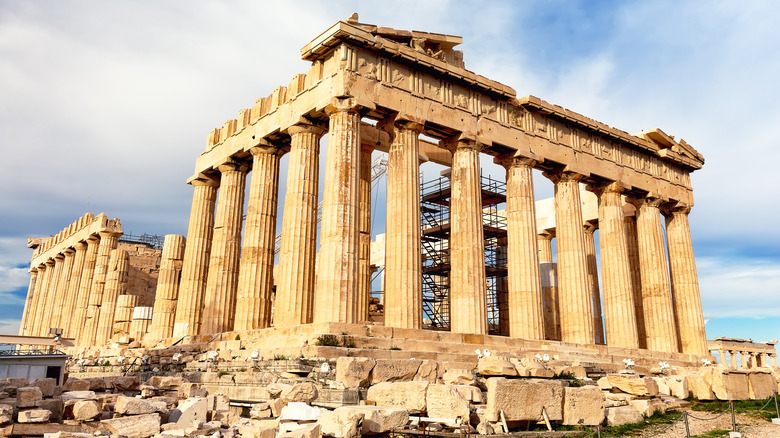
When visiting Greece, one of the must-see locations for travelers is definitely the Acropolis. What first-time visitors might not know is that the site itself is actually the Acropolis while the other buildings have their own names, like the Parthenon, Propylaia, Erechtheion, and more. The UNESCO World Heritage site is certainly a well-photographed piece of Athenian history with plenty to teach us about ancient Greeks.
According to UNESCO , the Acropolis is the grandest and most complete complex of ancient Greek architecture that survived to today. The first walls around the site were put up during the 13th century BC and the monuments dotting the property have survived countless hazards in their 2500 years, per the site. The Acropolis site itself is truly a marvel to behold and while it isn't one of the wonders of the world, it's definitely a wonder in itself.
The Greek name "Acropolis" translates into a few variations: "High City," "City on the Extremity," and "City on the Air," according to Ganymedes . All three phrases are fitting as the site looms large over Athens as if the ancients themselves are watching over present-day Grecians. Although many artifacts were taken to the British Museum (and the Greek government continues fighting to have them returned), there are many pieces of ancient art to gaze at within the Acropolis. While this is a top destination for tourists, there are still rookie mistakes that can dampen your experience. Let's go through some tips and tricks to make your visit to the Acropolis the best it can be.
Get tickets beforehand
Going to the Acropolis is at the top of a lot of travelers' lists when visiting Greece. That said, if you don't buy your entry tickets in advance, you will be stuck behind a lot of those travelers. Purchasing tickets ahead of time saves you so much time! When buying ahead of time you can also purchase a skip-the-line ticket which will save you even more time at the entry gate. It's important to note that advanced tickets are not automatically skip-the-line tickets, so pay attention to what you're purchasing (via Travel Infused Life ).
Besides getting tickets ahead of time, be sure you're also not planning on visiting when it's a free day unless you feel like waiting around for a long time. Free access days are when you'll encounter the most tourists and locals alike, so pay attention to those dates (via Headout ). Purchasing skip-the-line tickets won't save you money, but it will keep you from waiting around in line for a few hours just to get into the site. If you've ever had to stand in one spot in the grueling Grecian heat in the middle of summer, you will understand the appeal of skipping the line.
Timing is everything
At this site, when you go will determine so much about your experience. Going to the Acropolis very early in the day or late means it will be significantly less crowded. Not only that but you will be saved from the torture of the sun at high noon. Don't forget that you're on top of a large hill, so it gets pretty toasty at midday, especially if you visit in the hot months. Your best bet for small crowds early in the day is to go to the site before 9 a.m., according to Greek Travel Tellers . Why? Because 9 a.m. brings the cruise ship crowds and a flood of tourists.
If you're not a morning person (we get it), going to the Acropolis in the evening is also a treat. Make sure you give yourself at least two hours before the site closes for the day to really enjoy it. But the evening brings cooler weather, fewer crowds, and the potential to see a stunning sunset from the top of the hill.
Per Acropolis Tickets , 11 a.m. to 1 p.m. is the busiest time at the site, particularly during the heaviest visiting season of April to October. So whether you are an early bird or not, try to time your visit so you get the most out of the excursion.
Dress for the elements
Being on the hill that overlooks Athens comes with some incredible views — and extreme sun exposure. Seriously, there are very few (if any) shady spots once you get up the hill. Be prepared to be in full sun unless you luck out on a cloudy day. Particularly if you're visiting Greece in the summer, be more aware of the heat. You'll want lots of sunscreen, UV-protective clothing, sunglasses, and comfortable shoes.
You don't have to worry about a dress code here like some of the other sites around like the Greek Monasteries, so just be comfortable (via Travel the Greekway ). Consider wearing clothes that are breathable and cooling so you don't feel so sticky in the heat, per You Could Travel . It can be windy at the top of the hill, so keep that in mind if you plan on wearing a hat or a dress/skirt on the excursion.
Wear good shoes
Trekking to the Parthenon at the top of the Acropolis isn't a particularly difficult hike. Without stopping, it takes about 20 minutes. However, many of the stone stairs have been worn down from use so they are very slippery, especially if it's been raining. Parts of the walk can be steep and uneven, though there is an elevator that can be utilized for folks with walking difficulties or wheelchairs. There are times when the elevator is out of order, so contact the site ahead of time before you go if you need to use it, via Wonderful Wanderings .
Don't feel rushed to just get to the top of the hill as soon as you can. Take your time and enjoy the monuments along the way. Places to rest or even the rare shady spots dot the path for moments of contemplation. Even the trek up the hill itself is figuratively breathtaking just in the sheer magnitude of the sites you are approaching. Walking steadily toward iconic architecture like the Parthenon is magnificent.
The path leading up to the Parthenon has so many signs, artifacts, and things to see that make the hike so much more interesting. So wear good shoes with grip to avoid slipping and just enjoy the hike. The top will still be there even if you don't go running up the hill (cue that Kate Bush song).
Check out the museum
Surprisingly, visitors can visit the Acropolis and think that's all there is to the archaeological discovery. However, the Acropolis Museum nearby is an expansive array of ruins, explanations, and depictions of how the high city once looked. You can even see archaeological dig sites as they were when scientists excavated them, which is quite a unique experience.
One of the most unique elements of the museum is the top floor Parthenon Gallery, which showcases the sculptures of the architecture as they might have been when the Parthenon was built. Discover Greece recommends dedicating two to three hours to this 14,000-square-foot behemoth of a museum.
Since it opened in 2009, the Acropolis Museum has become one of the highlights for visitors to Athens, according to Athens by Locals . What is also incredible about this museum is the basement level, which shows excavation sites of an ancient Athenian neighborhood that you can see up close from a walkway or from above through glass floors. It is likely that the Acropolis Museum will be unlike any museum you've toured before.
Obey the signage
Signs that say "do not touch" or anything equivalent at an ancient site like the Acropolis are not just making a suggestion. Absolutely do not touch, stand on or sit on the ruins. There are areas where you can rest that aren't made of ancient marble. You'll probably notice the guards standing around the site, particularly up by the Parthenon. You'll hear them, too, if someone touches something they aren't supposed to touch. A shout or a whistle will alert you right away if someone literally goes over the line. Don't leave even a water bottle on a marble slab either, that counts (per Little Owl Tours ).
Be mindful of where you're walking (or climbing) at all times, especially up the hill at the Acropolis. Not only can you get in trouble for climbing where you aren't supposed to be, but it's also dangerous to do so. That's why there are so many roped-off areas.
Additionally, you are more than welcome to take photographs, but keep in mind that the Acropolis is an ancient space. Certain poses are considered inappropriate depending on who is around you that day. Don't be lewd around the statues or pose provocatively on the grounds, it's not allowed. Flags, mascots, and other such objects are also not permitted to be photographed with monuments behind them.
Operating hours at the Acropolis are no joke. If you arrive with just enough time to get to the top of the hill and snap a picture, you will be hounded to exit when the site closes. When the site is closed, it is closed . So, unless you want to rush out of the property at the end of your visit in a sea of hurried tourists, give yourself enough time to enjoy the Acropolis.
The time of year that you visit the Acropolis will dictate the hours of operation, though the final entry is always a half hour prior to closing, according to Greece Travel Secrets . Remember that it will take roughly 20 minutes to get to the top of the hill if you don't stop to look at monuments along the way. And absolutely don't save your photos for the very end of the visit because you will be scolded by the guards for stopping when you should be exiting.
Use the second entrance
Digital maps will automatically take you to the main entrance of the Acropolis, but that is where you'll find the longest entry lines. If you go in via the secondary entrance you will get more time at the site itself. The secondary entrance is located on the southeast side of the grounds and is known as the Dionysius Theater entrance because it's near the Theatre of Dionysus ruin, per Athens Walking Tours . You may encounter a line at this other entrance, though it is unlikely to be even a fraction as long as the main entry point.
Headout notes that the wait to enter the Acropolis from the main entrance ranges from 20-30 minutes for folks with advanced tickets but up to several hours for those who buy tickets at the gate. It should be noted that parking near the Acropolis site is relegated to the main entrance side of the grounds so, if you opt to park, the side entrance will be a little bit of a walk from your vehicle. A short walk is definitely worth missing a long line though, for sure.
Bring some water
Once you enter the Acropolis site, there is no place to purchase water. There is a water fountain area on the top of the hill near the bathrooms, but otherwise, you're out of luck if you get thirsty. Bringing water along means that you can spend more time enjoying the ruins rather than rushing through them to quench your thirst.
Water is the only food or beverage item guests are allowed to bring onto the premises, so be sure to finish your freddo (a Greek iced espresso drink) before you head in. Pinay Flying High mentions that there is an area near the ticketing booth where you can buy beverages, but that doesn't include water. They only sell just juices or sodas, which are not allowed on the site. When traveling, it's always a good idea to bring a reusable water bottle anyway, especially if you're visiting a place like Greece which can be sweltering for a good portion of the year. Don't get to the top of the hill without a water bottle, it will impact how much fun you have visiting the site — we would know.
Don't ignore the other archaeological sites
The Parthenon is the main attraction at the Acropolis, there's no doubt about that. However, there are a lot of other sites, statues, and ruins to see while you're visiting the ancient city. From Odeon of Herodes Atticus (an ancient theater still used today), to the Temple of Athena Nike, and the Erechtheion, it's part of the experience to see all the ruins you can while visiting. The Erechtheoin is actually considered the most sacred building on the premises, so you definitely don't want to miss that one (via Greek Travel Tellers ).
Down the southwestern slope of the hill is where ancient Athenians would have had a lot of public events and spaces, according to Athens by Locals . The ruins of other temples, places of worship, performance, and gathering spaces are scattered around the side of the hill. While many of the spots like the Temple of Tharsyllus have just a few remaining pieces of architecture, it's still incredible to see how these monuments have survived thousands of years.
You'll also see nondescript ruins of buildings or sites that don't have any real information to provide you of their whereabouts. While you might not learn anything about those, walking in the footsteps of ancient Athenians is a sensation all its own.
Buy a combo ticket
Buying tickets in advance gives you the ability to also get a combination ticket. Combining your Acropolis visit with something else like the Acropolis Museum or elsewhere in the country like the Ancient Agora is a huge budget saver. Greece is full of ancient places to see, so it's easy to spend a lot of money on entrance fees. Road Affair suggests the Acropolis site and museum combo ticket because these are not only money-savers but time-savers too since they include skip-the-line features at both locations.
Another great way to see several ancient areas at once, including the Acropolis, is to join a group tour. Group tour settings aren't for everyone, especially if you like to go at your own pace, though it is an excellent way to get more information out of your visits. The descriptions at each of the Acropolis are informative, but a live tour guide will give you more to learn about. That's especially helpful when you're looking at the two remaining columns of the Temple of Tharsyllus trying to envision what it would've looked like.
Watch for tortoises (seriously!)
The most surprising thing about the Acropolis might just be that there are tortoises wandering around. Don't be concerned when you see one waddling through the grounds, as these sturdy critters fit right in with the architecture. Though do be careful on the stairs leading up the hill, sometimes they sunbathe in the way of pedestrians. Market Manila noticed that the tortoises were numbered, indicating someone is keeping track of the shelled residents.
Wild cats and dogs are not uncommon sights around Greece, so spotting either of them at the Acropolis won't be a surprise. Tortoises on the other hand? That threw us for a loop. It makes sense though since the site has very little tree cover and there are lots of places for these slow-moving reptiles to bask.
Evidently, the tortoises also love to wander around by the Acropolis Museum too, so if you don't spot one at the Acropolis itself maybe you'll get lucky (via Acropolis Museum Kids ). It seems the tortoises are most seen during the warmer months, which makes them the most loveable tourists of the high season.
- Visitors Guide
- Convention & Visitors Bureau
- Athens with a local
Photo: Orestis Seferoglou
- See & Do
- Museums & Antiquities
- Antiquities
The Acropolis
- Copied to clipboard
Here’s what you need to know about Athens’ most iconic historical site.
TravelAsker
Visiting the Acropolis in Athens: The Essential Guide
February 3, 2024
By Mackenzie Roche
When visiting Athens, no trip is complete without a visit to the Acropolis. This iconic ancient citadel, perched high above the city, is home to some of the most important and well-preserved ancient Greek ruins in the world.
Walking through the gates of the Acropolis is like stepping back in time. You can’t help but be in awe of the breathtaking architecture and the rich history that surrounds you. The Parthenon, dedicated to the goddess Athena, is the most famous and impressive structure on the Acropolis, but there are many other temples and monuments to explore as well.
It’s important to come prepared for your visit to make the most of your time at the Acropolis. Wear comfortable shoes as there is a fair amount of walking and climbing involved. Don’t forget your camera to capture the incredible views of Athens from the top of the Acropolis.
If you’re interested in learning more about the history and significance of the Acropolis, consider hiring a guide or joining a group tour. They can provide valuable insights and bring the ruins to life with their knowledge and storytelling.
Be prepared for crowds, especially during peak tourist season. To avoid the biggest crowds, consider visiting early in the morning or later in the afternoon. Remember to be respectful of the site and its history by not touching the ancient structures and following any rules or regulations in place.
A visit to the Acropolis is a must-do when in Athens. Whether you’re a history buff, an architecture lover, or simply looking to immerse yourself in the ancient world, the Acropolis will not disappoint. Don’t miss the chance to experience this incredible UNESCO World Heritage site firsthand.
Planning Your Visit to the Acropolis
Visiting the Acropolis in Athens is a must-do for any history lover or cultural enthusiast. The ancient citadel that is home to the Parthenon and other iconic structures offers a fascinating glimpse into the past, and planning your visit in advance can help ensure a smooth and enjoyable experience.
Here are some tips to help you make the most of your trip to the Acropolis:
By planning ahead and following these tips, you can ensure a memorable and enjoyable visit to the Acropolis in Athens. Take your time to explore the ancient wonders and soak in the rich history and culture of this iconic landmark.
Acropolis Tickets and Opening Hours
When planning your visit to the Acropolis in Athens, it’s important to be aware of the ticket options and the opening hours of the site. The Acropolis is open throughout the year, but the opening hours may vary depending on the season.
There are different types of tickets available for the Acropolis, depending on your preferences and interests. The standard ticket costs €20 for adults and €10 for students, and it includes access to the Acropolis and all its major attractions, including the Parthenon, the Erechtheion, and the Temple of Athena Nike. There is also a reduced ticket price of €10 for children under 18 years old and senior citizens over 65 years old.
If you are planning to visit other archaeological sites in Athens, you can purchase a combination ticket which includes access to the Acropolis as well as other sites like the Ancient Agora, the Roman Agora, and the Temple of Olympian Zeus. This combination ticket costs €30 for adults and €15 for students.
It’s important to note that the Acropolis can get crowded, especially during peak tourist season. To avoid long queues and ensure a smooth visit, it is recommended to purchase your tickets online in advance. Online ticket purchases also give you the advantage of skipping the line at the entrance and going directly to the security check.
The opening hours of the Acropolis vary depending on the time of year. From April 1st to October 31st, the site is open from 8 am to 8 pm. From November 1st to March 31st, the site is open from 8:30 am to 3 pm. It’s advisable to arrive early in the morning or in the late afternoon to avoid the midday heat and the busiest hours.
Remember to bring comfortable shoes, sunscreen, and a hat, as there is a considerable amount of walking and the sun can be intense, especially during the summer months. Also, be mindful of the site’s rules and regulations, such as not touching the ancient ruins and respecting the designated paths.
By being informed about the ticket options and opening hours, you can make the most of your visit to the Acropolis and fully experience the rich history and architectural wonders of ancient Athens.
How to Get to the Acropolis
Visiting the Acropolis in Athens is a must for anyone traveling to Greece. To ensure a smooth and convenient visit, it’s important to know how to get to the Acropolis. Here are some options:
Public Transportation: The easiest and most affordable way to reach the Acropolis is by using public transportation. Athens has an extensive and efficient public transportation system, including buses, metro, and trams. The Acropolis is conveniently located near the Acropolis metro station, which is on Line 2 (Red Line). From there, it is a short walk to the entrance of the archaeological site.
Taxi: Taxis are widely available in Athens and can be a convenient option, especially if you’re traveling in a group or with heavy luggage. However, keep in mind that traffic in Athens can be heavy, especially during peak hours, so the journey to the Acropolis may take longer than expected. Make sure to choose a licensed taxi and ask the driver to use the meter to avoid any scams.
Walking: If you’re staying in the city center, walking to the Acropolis can be a pleasant option. The Acropolis is located on a hill, so be prepared for a bit of uphill walking. However, the walk is picturesque and offers stunning views of the city along the way.
Tourist Bus: Another popular option is taking a tourist bus. These buses usually have multiple stops at major attractions in Athens, including the Acropolis. They offer the benefit of hop-on-hop-off service, allowing you to explore the city at your own pace. Keep in mind that these buses can get crowded during peak tourist season, so plan accordingly.
Car Rental: If you prefer the flexibility of having your own transportation, you can rent a car and drive to the Acropolis. However, keep in mind that parking in Athens can be challenging, especially near popular attractions like the Acropolis. It’s advisable to park in designated parking areas and avoid parking illegally to avoid fines.
Regardless of how you choose to get to the Acropolis, make sure to plan your visit in advance, especially during peak tourist season. The Acropolis is a popular attraction and can get crowded, so arriving early or purchasing tickets online can help you avoid long queues and ensure a more enjoyable experience.

Exploring the Acropolis
When visiting Athens, a trip to the Acropolis is an absolute must. This ancient citadel perched high above the city offers breathtaking views and a glimpse into the wonders of ancient Greece. Exploring the Acropolis is a truly unforgettable experience.
As you ascend the steep pathway leading up to the Acropolis, you will immediately be struck by the grandeur of the iconic Parthenon. This magnificent temple, dedicated to the goddess Athena, stands as a testament to the incredible architectural achievements of the ancient Greeks.
Walking along the ancient pathways, you will encounter other significant structures such as the Erechtheion and the Propylaea. Each of these structures holds its own unique story and purpose, adding to the rich history of this remarkable site.
Be sure to take your time as you explore the various ruins and buildings that make up the Acropolis. Admire the intricate details carved into the marble columns, marvel at the perfectly symmetrical proportions of the temples, and imagine the bustling city that once thrived within these walls.
For an even more immersive experience, consider hiring a knowledgeable guide who can provide you with fascinating insights and historical anecdotes about the Acropolis. They can help bring the ancient ruins to life and deepen your understanding of this iconic site.
Finally, don’t forget to take a moment to soak in the stunning panoramic views from the top of the Acropolis. From this vantage point, you can see the sprawling city of Athens below, as well as the surrounding mountains and the sparkling Aegean Sea in the distance.
Exploring the Acropolis is more than just a visit to a historic site – it’s a journey back in time that will leave you with a newfound appreciation for the enduring legacy of ancient Greece.
Must-See Sights on the Acropolis
When visiting the Acropolis in Athens, there are several must-see sights that should be at the top of your list. These ancient structures are not only impressive in their beauty, but they also offer a glimpse into the rich history of ancient Greece.
The Parthenon: Undoubtedly the most famous sight on the Acropolis, the Parthenon is an iconic ancient Greek temple dedicated to the goddess Athena. Its massive columns, intricate friezes, and stunning architectural details make it a true marvel of ancient engineering.
The Erechtheion: This temple is known for its unique design and its famous porch of the Caryatids, which features six statues of women serving as columns. The Erechtheion is dedicated to both Athena and Poseidon, and its mix of architectural styles makes it a fascinating sight to explore.
The Propylaea: This monumental gateway is the entrance to the Acropolis and is an impressive structure in its own right. With its grand staircase and ornate marble columns, the Propylaea provides a striking introduction to the wonders that await inside the Acropolis.
The Temple of Athena Nike: Perched on a bastion overlooking the city of Athens, the Temple of Athena Nike is dedicated to the goddess of victory. Its elegant design and intricate friezes make it a must-see sight for any visitor to the Acropolis.
The Theater of Dionysus: Located on the southern slope of the Acropolis, the Theater of Dionysus is the oldest theater in Greece. It was used for performances of ancient Greek plays, and its ruins are a testament to the enduring legacy of Greek theater.
These must-see sights on the Acropolis offer a fascinating journey back in time to the golden age of ancient Greece. Exploring these ancient structures will leave you in awe of the incredible artistry and architectural achievements of the ancient Greeks.
Note: It is recommended to wear comfortable shoes and bring plenty of water when visiting the Acropolis, as there is a fair amount of walking and it can get quite hot during the summer months.
The Parthenon: An Architectural Marvel
The Parthenon, located on the Acropolis in Athens, is one of the most iconic and admired structures in the world. Built in the 5th century BC, it is a masterpiece of ancient Greek architecture and a symbol of Athenian democracy.
Designed by the architects Iktinos and Kallikrates, the Parthenon was dedicated to the goddess Athena, the patron deity of Athens. The temple’s design is based on classical Greek architectural principles, with its proportions and harmony being key features.
One of the most remarkable aspects of the Parthenon is its use of the Doric order, a style characterized by its simplicity and solidity. The temple is made entirely of white marble, giving it a stunning appearance and adding to its visual impact.
The Parthenon is known for its meticulously carved friezes, which depict various mythological and historical scenes. These sculptures are a testament to the skill and artistry of ancient Greek sculptors and provide valuable insights into the culture and beliefs of the time.
Despite being centuries old, the Parthenon continues to inspire awe and wonder. Its timeless beauty and architectural perfection make it a must-see for visitors to Athens, and a testament to the enduring legacy of ancient Greece.
The Erechtheion: A Historic Temple
The Erechtheion is a historic temple located on the Acropolis in Athens, Greece. It was built in the 5th century BC and is dedicated to both Athena and Poseidon. This temple is known for its unique design and rich history.
One of the most distinctive features of the Erechtheion is its porch, known as the “Porch of the Caryatids.” This porch is supported by six female statues, which are known as caryatids. These caryatids are carved to represent women wearing flowy garments and supporting the weight of the porch on their heads.
This temple is also famous for the “Pandroseion,” which is a small shrine located on the northern side. It is dedicated to Pandrosos, the daughter of Cecrops, the mythical king of Athens. The interior of the Erechtheion houses the sacred olive tree, which is said to have been planted by the goddess Athena herself.
The Erechtheion has witnessed many significant events throughout history. It served as a place of worship, a treasury, and even a burial site for prominent Athenians. It was damaged and altered numerous times, including during the Roman Empire and Byzantine period. Despite the damage, the Erechtheion remains a symbol of ancient Greek architecture and a testament to the cultural and religious significance of the Acropolis.
Today, visitors can explore the Erechtheion and admire its intricate carvings and architectural details. It offers a unique perspective on the history and mythology of ancient Greece. The Erechtheion is a must-see attraction for anyone visiting the Acropolis in Athens.
The Propylaea: The Grand Entrance
The Propylaea, also known as the grand entrance, is the massive gateway that visitors must pass through to enter the Acropolis. It was built in the 5th century BCE and is considered one of the most magnificent architectural achievements of ancient Greece. The Propylaea was designed by the famous architect Mnesicles and took several years to complete.
The Propylaea consists of a central building and two wings that extend outwards. The central building features an impressive marble staircase, which leads up to the entrance. The staircase is adorned with intricate carvings and statues, depicting scenes from Greek mythology.
Once inside the Propylaea, visitors can admire the grandeur of the structure and take in the breathtaking views of Athens. From the top of the staircase, one can see the majestic Parthenon, the Erechtheion, and other ancient ruins scattered across the Acropolis.
Aside from its architectural beauty, the Propylaea also served a practical purpose. It acted as a control point, allowing only authorized personnel and religious processions to enter the sacred grounds of the Acropolis. The Propylaea was equipped with large wooden doors that could be closed to restrict access when necessary.
Today, the Propylaea stands as a testament to the ingenuity and craftsmanship of the ancient Greeks. It is a must-see attraction for anyone visiting the Acropolis, offering a glimpse into the rich history of Athens and its iconic landmarks.
The Temple of Athena Nike: A Symbol of Victory
The Temple of Athena Nike, located on the Acropolis in Athens, is a small but significant temple dedicated to the goddess of victory, Athena Nike. Built in the 5th century BC, it is one of the earliest Ionic temples in Greece and continues to be an iconic symbol of victory and achievement.
The temple was built by the Athenians to commemorate their victories in the Persian Wars, particularly the Battle of Marathon. It was believed that Athena Nike had brought them success in battle, and so the temple was constructed as an offering to her. The name “Nike” means “victory” in Greek, and the temple serves as a reminder of the importance of overcoming obstacles and achieving greatness.
The Temple of Athena Nike is known for its elegant and graceful design, featuring six marble columns on the front and back, and four on each side. The frieze of the temple depicts various scenes from mythology, including the birth of Athena and the battle between the gods and giants. These artistic details showcase the skill and creativity of the ancient Greeks, and provide visitors with a glimpse into their rich mythology and culture.
Despite its small size, the Temple of Athena Nike holds great significance in Greek history and remains an important cultural landmark to this day. It serves as a reminder of the enduring spirit of the Greek people and their ability to overcome challenges and achieve victory.
The Theater of Dionysus: Ancient Greek Drama
The Theater of Dionysus is an ancient Greek theater located on the southern slope of the Acropolis in Athens. It is considered to be the birthplace of Western theater and is dedicated to Dionysus, the Greek god of wine and fertility. Built in the 5th century BC, it was the main venue for the performance of ancient Greek dramas.
The theater could seat around 17,000 spectators and consisted of three main parts: the orchestra, the skene, and the audience seating area. The orchestra, which means “dancing place” in ancient Greek, was a circular area where the chorus would perform. The skene, or stage building, served as the backdrop for the performances and had a central door for the actors to enter and exit. The audience seating area consisted of stone steps carved into the hillside, providing a panoramic view of the stage.
Ancient Greek drama played a significant role in the cultural and social life of Athens. It was a form of entertainment and a way to explore philosophical and moral questions. The plays were performed during religious festivals in honor of Dionysus, and they often dealt with themes such as the power of gods, the nature of humans, and the consequences of hubris.
The most famous playwrights of ancient Greece, including Aeschylus, Sophocles, and Euripides, had their works performed at the Theater of Dionysus. These playwrights wrote tragedies, which were serious plays that explored the human condition and often ended in death and suffering. Tragic heroes like Oedipus and Antigone became iconic characters in ancient Greek drama.
In addition to tragedies, the Theater of Dionysus also showcased comedies. Comedies were humorous plays that poked fun at society and politics. The most famous playwright of ancient Greek comedy was Aristophanes, who wrote plays such as “Lysistrata” and “The Frogs”. These comedies provided a lighthearted contrast to the serious tragedies performed at the theater.
Today, the Theater of Dionysus is a popular tourist attraction and a reminder of the rich cultural heritage of ancient Greece. Visitors can explore the ruins of the theater and imagine the grandeur and spectacle of the performances that once took place there. It serves as a testament to the enduring legacy of ancient Greek drama and its impact on theater and literature throughout history.
The Odeon of Herodes Atticus: A Spectacular Venue
Nestled within the ancient site of the Acropolis in Athens, the Odeon of Herodes Atticus stands as a magnificent testament to the rich history and culture of this ancient city. Built in 161 AD by Herodes Atticus, a wealthy Roman senator, this amphitheater has become one of the most iconic and popular attractions for visitors and locals alike.
The Odeon of Herodes Atticus was originally used as a venue for musical performances, including plays, concerts, and other cultural events. Today, it continues to serve as a performance space, hosting a range of events, from music concerts to theatrical productions. The stunning acoustics of the amphitheater make it an ideal venue for performances, captivating audiences with its unparalleled sound quality.
With a seating capacity of approximately 5,000, the Odeon of Herodes Atticus offers a truly immersive experience for spectators. The seating area is divided into tiers, providing excellent views of the stage from every angle. The intricate stonework and design of the amphitheater add to its grandeur, creating a sense of awe and wonder for those who visit.
One of the most breathtaking features of the Odeon of Herodes Atticus is its backdrop. Situated against the backdrop of the Acropolis, with its majestic Parthenon, the amphitheater offers unparalleled views of this iconic landmark. As spectators revel in the performances, they are also treated to the spectacular sight of the Acropolis, creating a truly magical and unforgettable atmosphere.
Whether you are a history enthusiast, a lover of the arts, or simply a curious traveler, a visit to the Odeon of Herodes Atticus is an absolute must. Immerse yourself in the rich history and cultural heritage of Athens as you witness a performance in this spectacular venue. Experience the magic of the Odeon of Herodes Atticus, where ancient and modern worlds collide in a captivating display of beauty and artistry.
The Acropolis Museum: Unveiling Ancient Artifacts
If you’re fascinated by ancient history and love discovering the secrets of the past, then a visit to the Acropolis Museum is a must. Located just a short distance from the world-famous Acropolis itself, the museum is home to an impressive collection of artifacts that offer a glimpse into the world of ancient Greece.
Designed by renowned architect Bernard Tschumi, the Acropolis Museum opened its doors to the public in 2009. Since then, it has become a popular destination for both locals and tourists alike. The museum’s modern and sleek design provides the perfect backdrop for the ancient treasures it houses.
As you explore the museum, you’ll come face to face with some of the most important artifacts from the Acropolis site. From intricate statues and figurines to fragments of architectural masterpieces, each artifact tells a unique story about ancient Greek culture and society.
One of the highlights of the museum is the Parthenon Gallery, which showcases the original frieze of the Parthenon temple. The gallery uses natural light to illuminate the ancient reliefs, allowing visitors to fully appreciate the craftsmanship and detail of these incredible sculptures.
In addition to the Parthenon Gallery, the museum also houses several other galleries devoted to different aspects of ancient Greek history. From the Archaic Period to the Roman Era, each gallery offers a comprehensive view of a specific time period in Greek history.
While the Acropolis itself is a must-visit, the Acropolis Museum is the perfect complement to your exploration of this ancient site. With its state-of-the-art facilities and carefully curated exhibits, the museum provides a unique opportunity to immerse yourself in the rich history and culture of ancient Greece.
So, next time you find yourself in Athens, be sure to carve out some time to visit the Acropolis Museum. Prepare to be amazed as you uncover the secrets of the ancient world and gain a deeper understanding of the legacy left behind by the ancient Greeks.
Tips for Visiting the Acropolis
Visiting the Acropolis in Athens is a must-do experience for any traveler, but it can also be overwhelming. Here are some tips to help you make the most of your visit:
1. Come early or late in the day: The Acropolis gets crowded, so try to arrive early in the morning or late in the afternoon to avoid the crowds. This will also give you a chance to see the site in different lighting conditions, which can make for better photos.
2. Wear comfortable shoes: The Acropolis is a large site with uneven terrain, so make sure to wear comfortable shoes. There is also a lot of walking involved, so be prepared for that.
3. Bring water and sunscreen: Athens can get hot, especially in the summer, so make sure to bring plenty of water and wear sunscreen to protect yourself from the sun.
4. Hire a guide: Consider hiring a guide to get the most out of your visit. A guide can provide you with valuable information about the history and significance of the site, and can help you navigate the crowds.
5. Be respectful: The Acropolis is a UNESCO World Heritage Site and a symbol of Greek history and culture. As such, it is important to be respectful during your visit. Follow the rules and regulations, don’t climb on any structures, and be mindful of others who are also visiting.
6. Take your time: The Acropolis is a complex site with many different structures and areas to explore. Take your time to truly appreciate the history and beauty of the site. Don’t rush through it or try to see everything in one go.
7. Be prepared for the weather: Athens can have unpredictable weather, so be prepared for changes in temperature and have appropriate clothing with you. It’s always a good idea to check the weather forecast before your visit.
8. Plan your visit: Before you go, plan your visit and decide which areas of the Acropolis you want to see. This will help you make the most of your time there and avoid feeling overwhelmed by the size and complexity of the site.
By following these tips, you can have a more enjoyable and fulfilling experience when visiting the Acropolis in Athens.
How can I visit the Acropolis in Athens?
To visit the Acropolis in Athens, you can take a guided tour or explore it on your own. The site is open to the public and you can purchase tickets at the entrance. There are also audio guides available for rent, which provide detailed information about the historical significance of each monument on the Acropolis.
What are the opening hours of the Acropolis in Athens?
The Acropolis in Athens is open to visitors from 8 am to 8 pm from April to October, and from 8:30 am to 5 pm from November to March. It is recommended to arrive early in the morning or late in the afternoon to avoid the crowds and the heat.
Are there any restrictions or rules for visiting the Acropolis in Athens?
Yes, there are some restrictions and rules for visiting the Acropolis in Athens. Visitors are not allowed to touch or climb on the ancient monuments, and smoking is prohibited on the site. It is also recommended to wear comfortable shoes and appropriate clothing, as there is a lot of walking and climbing involved.
What are some must-see monuments on the Acropolis in Athens?
Some of the must-see monuments on the Acropolis in Athens include the Parthenon, the Erechtheion, the Temple of Athena Nike, and the Propylaea. These ancient structures are not only architecturally stunning, but also hold great historical and cultural significance.
The Acropolis of Athens Explained with Reconstructions

Mackenzie Roche
Leave a comment cancel reply.
- Destinations
- Travel Guides

Visiting the Acropolis in Athens
)
Jo Williams
- Visiting the Acropolis
Perched on a limestone hill overlooking the sprawling city of Athens , the Acropolis is an ancient site that needs little introduction.
These iconic landmarks of Athens like the mighty Parthenon, Temple of Athena Nike, Erechtheion, and Propylaea have been on the UNESCO World Heritage List since 1987. It’s the number one place to learn about Greek history and culture, containing the single largest collection of Classical Greek art and architecture in the world.
Of course, with all of these accolades, it’s no wonder that the Acropolis is the most visited archaeological site in Greece . The site can see over 16,000 visitors per day in an area of just over 3 hectares, so it can get a little crowded at times.
Here's what you need to know to make the most of your time here, plus tips on how to avoid the queues and the heat.
)
Is the Acropolis worth visiting?
There are few places in the world that are steeped in so much history and culture as Athens’ Acropolis. Yes, it’s busy in the summer and the crowds can take away some of the ancient sites' ambience, but it is still one of those places you just have to see for yourself.
The name “Acropolis” means “high city” ( akron meaning “highest” and polis meaning “city”), and it was built to honour Athena, the Greek goddess of wisdom, war, and crafts. She was also the patron of Athens, which takes its name from her.
Tips for visiting the Acropolis
Choose your entrance wisely.
It’s important to know that the Acropolis has two visitor entrances, choosing wisely could save you a lot of time in queuing and the climb up is about the same either way.
The ticket office at Dionysiou Areopagitou (near the Acropolis Museum) is the quieter of the two. It’s located on the south slope of the Acropolis of Athens, and is also the entrance that small group tours and skip-the-line tours use.
Rovertou Galli is the main entrance to the Acropolis, it can see very long lines in the summer. It’s nearer to the parking and often gets busy with large tour groups.
Start with the Parthenon
It’s best to head straight to the Parthenon before the crowds and tour groups arrive. It will mean a brisk uphill walk past Dionysus’ Theater, ignoring the beautiful view over the Odeon of Herodes Atticus, and heading straight to the Propylaea.
You can always come back for photos and more exploring later, but this way you will sail past many of the other visitors.
Allow enough time to see the site and Acropolis Museum
Most visitors will find two to three hours enough time to see everything at the site, make sure to allow a couple of extra hours to visit the Acropolis Museum (located near the south slope of the Acropolis).
Plan out your visit
Bear in mind that the Acropolis is located on an exposed hill, the steps are slippery (especially when wet) and there is little shade in hot weather. Carefully planning when to visit the Acropolis can make the experience a lot more enjoyable.
)
What to see at the Acropolis
The ‘gateway to the Acropolis’, this grand entrance was built after the Persian Wars by Pericles. It features both Doric and Ionic architectural styles and is made almost entirely of Pentelic marble. Its design has inspired many other famous structures around the world such as the Brandenburg Gate in Berlin.
The Parthenon
The most grand and notable site of the Acropolis is undoubtedly the Parthenon, a temple dedicated to the goddess Athena Parthenos in the Golden Age of Pericles. Surrounded by a vast colonnade of Doric columns, the Parthenon was the largest and most lavishly decorated temple in mainland Greece when it was completed in 438 BC.
It once housed an 11.5 metre high statue of Athena made of gold and ivory, that has unfortunately since been lost to time. Even though it is under renovation today, the scale and grandeur of the Parthenon is awe-inspiring and a true testament to the power of the ancient Greek civilization.
Since its construction in the 5th century BC, the Parthenon has also served as a Christian church and as an Islamic mosque surviving nearly 2,500 years of wars, natural disasters, and looting.
The Temple of Athena Nike
This small temple stands on a 6-metre high stone platform and is dedicated to Athena Nike - the goddess of victory in Greek mythology. Famous as the first Ionic structure at the site, the Temple of Athena Nike was built between 427 and 421 BC.
)
Erechtheion, Pandroseion, and the Old Temple of Athena
These three separate buildings look like they are one, situated at the sacred spot where an olive tree still grows. It’s said to have sprouted when Athena hit the ground with a rock during a battle with Poseidon.
The most striking building is the Erechtheion, a temple dedicated to Athena and Poseidon. You will notice six female figures or “korai” holding up the marble porch, known as the “Porch of the Caryatids”. These are replicas, but you can see five of the originals in the Acropolis museum - the sixth is housed in the British Museum after controversially being looted by Lord Elgin in the early 19th century.
Theatre of Dionysus
Dionysus was the Greek god of theatre, religious ecstasy, wine, and fertility. The 25,000 seat theatre dedicated to the god was built around the same time as the temples and hosted the “City Dionysia” festival that included dramatic tragedies and comedies.
Odeon of Herodes Atticus
This ‘modern’ Roman theatre was built in 161 AD and is still used for performances today. It offers fantastic views over the city from the southern slopes near the Propylaea and can seat around 5,000 visitors in an open-air theatre.
From May to October every year the Athens & Epidaurus Festival sees the city come alive with music, theatre and dance performances. If visiting at this time of year make sure to check in advance what events are being held - it’s an unforgettable experience that adds a whole new perspective to the Acropolis.
)
Tickets and tours of the Acropolis
A single ticket for the Acropolis costs €20 in the summer (April 1 to October 31) and €10 in the winter (November 1 to March 31).
There is a 50% discount for seniors and non-EU students and free entry for EU students, children under 18, and for people with disabilities.
Since September 2023 you will need to pre-book a timeslot when booking your Acropolis tickets online . Make sure to be at the entrance 30 minutes before your chosen time slot.
Note that any reduced or free entry tickets (ie. for children) will still need to be picked up from the main ticket office with an emailed voucher and proof of entitlement.
The best ways to save money and avoid the queues are to get a combo ticket, a skip-the-line entry, or go on a small guided tour.
A multi-site or combo ticket costs €30 and is valid for five days, allowing you to skip the line at all included attractions.
The combo ticket gives you one visit each to the Acropolis, the Ancient Agora, Roman Agora, Hadrian’s Library, Temple of Olympian Zeus, Kerameikos, and Aristotle’s School.
Entry to the Acropolis Museum is not covered by the Athens multi-site ticket, but you can buy skip the line tickets from the official website (€10). Reduced-admission or free-admission tickets are only available at the Museum's ticket desk (an ID may be required as proof of entitlement).
A skip-the-line Acropolis ticket will also offer a timeslot, so you don’t need to queue for an entry time. These have the advantage of being refundable until the day before the booking. Other skip-the-line Acropolis tours mean that you can enter with a group, and you will have a guided tour included.
Is it worth getting a tour guide at the Acropolis?
A licensed local guide makes a visit to the Acropolis all the more enjoyable. They know the best photo stops, the most interesting facts, and how to avoid the long queues.
Try to book a small group tour with the entrance tickets included to avoid having to deal with the official Acropolis website - it can be confusing and there are no options for refunds/cancellation.
This 2 hour guided walking tour of the Acropolis in Athens starts from € 35 per person. Choose between a morning or an afternoon guided tour of the Athens Acropolis, and learn all about the fascinating history of the classical world with an archaeologist guide.
)
How to get to the Acropolis
The Acropolis is located right in the centre of Athens so it’s easy to walk to. The 15-minute walk from Syntagma Square will take you via Vasilissis Amalias Avenue.
On this walk you will see the National Gardens, Hadrian’s Arch and the Temple of Olympian Zeus. Turn on Dionysiou Areopagitou to head to the south slopes and towards the quieter entrance to the Acropolis.
Getting to the Acropolis by Metro
The closest subway station to the Acropolis is ‘Acropoli’. You can access it by using the red metro line called #M2. From Acropoli Station it’s just a 10-minute walk to the Acropolis.
Other convenient metro stations depending on where you are travelling from are ‘Monastiraki’ a 12-minute walk away, and ‘Thissio’ a 14 minute walk from the Acropolis.
Taking the bus to the Acropolis
The bus stop ‘Akropolē’ is an 8-minute walk to the Acropolis, this can be reached by the 230 bus. There’s also bus number 035 to ‘Monastiraki’ or bus 106 to ‘Makryianni’.
All public transport tickets cost €1.20 for 90 minutes, you can also purchase 24-hour and 5-day tickets priced at €4.10 and €8.20 - just make sure to always validate them.
From the airport to the Acropolis
If you’re coming straight from the airport just head into the city centre. You can take the direct bus numbered X95 to Syntagma Station and walk to the Acropolis from there.
Accessibility
There are some accessible options for visiting the Acropolis. About 350 metres from the main entrance you can find an elevator, people who struggle with steps or use wheelchairs are welcome to use it to access the hill but will need to arrange it ahead of time.
Golf carts are also available for getting around the site more easily, but some parts remain inaccessible due to steps/uneven ground.
)
When to visit the Acropolis
As the most visited attraction in Greece, the Acropolis is very busy all summer. High season runs from June to September.
During these months, it’s best to arrive before it opens and be one of the first inside - this is also a good way to avoid the stifling city heat of Athens in summertime. The Acropolis is at its busiest between 11 AM to 1 PM, so a later afternoon visit is another option if the weather isn’t too hot.
In winter, all ancient sites in Athens are half-price, including the Acropolis, plus the queues are much shorter. There is also free entry on certain days throughout the year, but these can get extremely busy with tourists and local school groups etc. so are best avoided if possible.
The Athens Acropolis is open daily from 8 AM to 8 PM, with the last entry being at 7:30 PM during the summer months (April to October).
During the winter months (November to March), the sites close by 5 PM, with the last entry at 4:30 PM.
The Athens Acropolis is closed completely on certain days of the year: 1 January, 25 March, 1 May, Easter Sunday, 25 and 26 December.
Where to stay near the Acropolis
There are countless places to stay in Athens. Good areas for tourists to stay in include Plaka with its cobblestoned streets and charming buildings near the Acropolis, central Syntagma, luxury Kolonaki, and the foodie district of Thissio.
Read our full guide on where to stay in Athens , as well as our other guides on spending three days in Athens and things to know before visiting .
)
- Where to next
Make sure not to miss the other historical sites that surround the Acropolis, like the Ancient Agora, the Roman Agora, Hadrian’s Library, and the Temple of Olympian Zeus. There are also many museums to deepen your knowledge of ancient Greek culture.
If you have more time, there’s also Kerameikos and the Lyceum of Aristotle. Another must-see in Athens is the grand marble horseshoe-shaped Panathenaic Stadium, famous as the site of the first modern Olympic Games in 1896.
Athens is the starting point for many Greek adventures, whether you are going Greek Island hopping on one of the nearby islands of Aegina, Poros, Hydra, or Spetses, or travelling further afield to Cycladic gems like Mykonos, Paros, or Santorini.
If you are travelling around Greece in winter, or simply want to avoid the crowds in summer, a road trip around the Greek mainland is another great option. Travel to the gravity-defying rock monasteries of Meteora , alternative cities like Thessaloniki , or the ancient sanctuary of Delphi .
For more inspiration and travel tips read our complete Greek travel guide.
- Introduction
- Is it worth visiting?
- What to see
- Tickets and tours
- Getting there
- When to visit
- Where to stay
Share this article
)
Author - Jo Williams
Jo Williams is a freelance writer with 10 years' experience working in travel and tourism. A Brit who got fed up with the 9 to 5 corporate life, she sold everything to become a full-time wanderer.
Jo has travelled to over 70 countries and worked throughout Europe for a major tour operator. She hopes to inspire you to work less and travel more.
Last Updated 16 December 2023


VISIT THE ACROPOLIS IN ATHENS [FULL GUIDE: PRICES, TICKETS, TIPS, ETC.]
How to Visit the Acropolis & Parthenon in Athens? What You Need to Know Before Visiting the Acropolis?
Are you going to Greece? Don’t miss out on visiting the Acropolis of Athens: here is our full guide!
The Acropolis appears in all the photos of trips to Athens, we see it whenever Greece is mentioned: the Acropolis of Athens immediately evokes the ruins of the Parthenon, proudly enthroned above the districts of the modern Greek capital.
This place is one of the most visited sites in the world, listed as a UNESCO world heritage site!
But the Acropolis of Athens is much more than a pile of ruins from ancient times: it is a rocky plateau raised to an altitude of 156 meters, extended over 300 meters in length and 85 meters in width, over a total area of 3 hectares.
In a Nutshell:
– The Acropolis in Athens is open every day, from 8 a.m. to 5 p.m. The monument closes at 3 p.m. on certain public holidays. – It takes at least 2 hours to complete the visit – It is preferable to buy tickets online in order to skip the long queue. – To get to the Acropolis, you can access it on foot, it’s a 15-minute walk from Syntagma Square. By metro, stop at the “Acropoli” station. By bus, with lines 1, 5, 15, 040, 230.
- VISIT THE PANATHENAIC STADIUM IN ATHENS
- 10+ AWESOME THINGS TO DO IN MYKONOS
- 15 BEST THINGS TO DO IN PAROS
- 25 BEST THINGS TO DO IN SANTORINI
1. The Acropolis of Athens: presentation and history
The Acropolis in Athens takes us back to the 5th century BC. Following the Persian Wars against the Persian Empire, the Athenians were forced to abandon their city, and the Persian army took the opportunity to sack the city during their exile.
The Acropolis, at the beginning of the 5th century BC
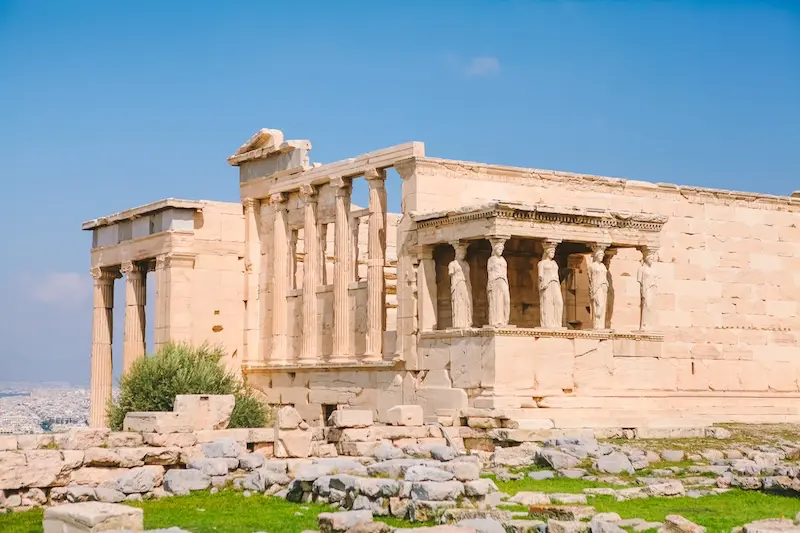
The Acropolis, at the beginning of the 5th century BC, consists of an old temple – dedicated to the city’s protective goddess, Athena -, at the foot of which the Greeks organized ritual processions called “Great Panathenaia”. “.
Following the sacking of the fortifications by the Persian king Xerxes I (-519;-475), the Athenians undertook to rebuild the Old Temple. The Greek cities, still threatened by the Persian Empire, joined forces to create the League of Delos , within which Athens enriched itself by imposing a tax to ensure the protection of neighboring cities, including Sparta.
The symbol of democracy
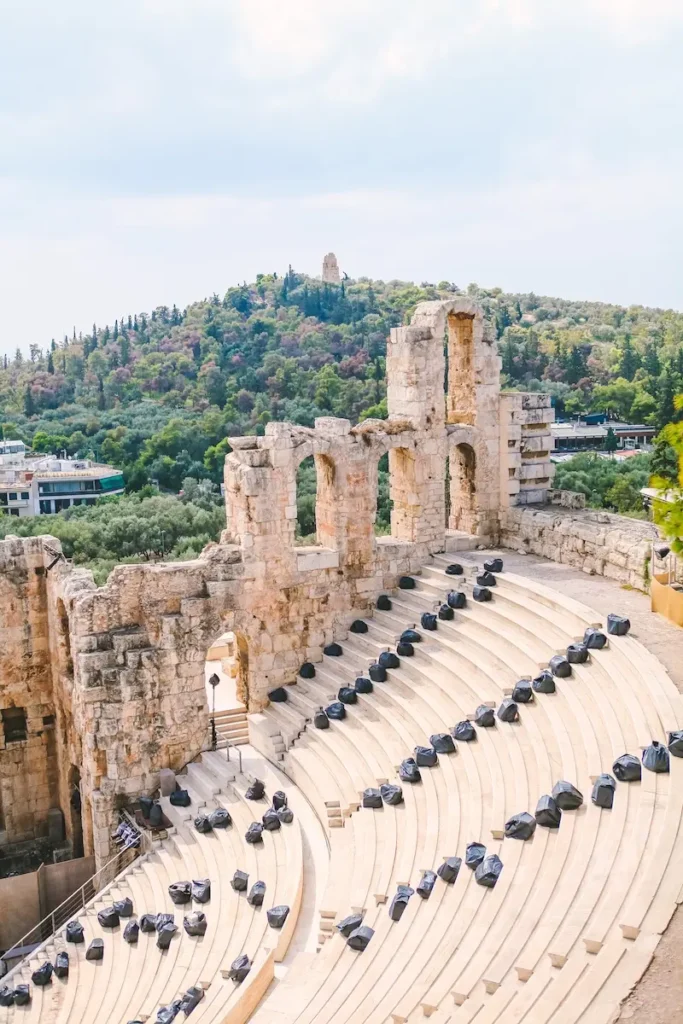
The war against the Persians ended in -449, that against Sparta in -446: it was the golden age of Athens when peace allowed it to dominate ancient Greece in the field of arts, architecture, culture and philosophy. Socrates, Plato, Thucydides, Sophocles and even Euripides lived in this sumptuous era. The Acropolis became symbol of democracy, where citizens came to the Acropolis to debate and vote, with the exception of women, metics, the poor, traders, artisans and slaves.
The Parthenon became the symbol of Athenian power

The Parthenon became the symbol of Athenian power, under the leadership of Pericles (-494;-429). Over the centuries, the monuments of the Acropolis of Athens suffered the curses of successive empires (Alexander the Great, Roman Empire, Christianity, Byzantine Empire, Ottoman Empire, Venetians): in 1687, Venetian troops massively bombarded the Parthenon.
The Parthenon became a church (6th century), a mosque (15th century) before becoming an archaeological and tourist site in the 20th century, after more than 2000 years of pillaging.
2. What to see and do at the Acropolis of Athens?

Visiting the Acropolis in Athens allows you to see many historical monuments:
- The Propylaea, the “entrance door” to the sanctuary
- The Erechtheion
- The Parthenon
- The Theater of Dionysus
Visiting the Acropolis of Athens also allows you to see certain ruins:
- The Odeon of Herodes Atticus
- The sanctuary of Asclepius
- The Odeon of Pericles
- Themistocles’ wall
- The temple of Rome and Augustus
- The statue of Athena Promachos

When visiting the Acropolis, you will start with the Propylaea, the entrance to the site via the steep slope and stairs (restoration in progress). Continue to the Parthenon, built between 447 and 432 BC. J-C (the oldest monument on the site).
Then, move on to the Temple of Athena, and finish with the Erechtheion, with its statues of the Caryatids. Spend a moment of meditation on the Agora, to imagine yourself in a toga debating the laws.
Don’t miss the Hephaestus, a temple dedicated to Hephaestus, the best preserved ancient monument in the city. On the southeastern slope of the Acropolis in Athens, the Theater of Dionysus, the cradle of Greek tragedy, is worth seeing. At the foot of the plateau, visit the Acropolis Museum. The Philopappos Hill allows you to immortalize in photos a superb view of the Acropolis.
3. How to visit the Acropolis of Athens?

Visiting the Acropolis, requires careful preparation for your visit, in particular by reviewing the main information concerning the site. We have therefore listed some important points for you:
- Your visit will last at least 2 hours, especially if you want to take full advantage of the place!
- The best time to visit the Acropolis of Athens is to go early in the morning (you will avoid not only the crowds but also the high temperatures during the summer months) or to arrive late in the afternoon, shortly before closing.
- Concerning accessibility, there are toilets for people with reduced mobility, an elevator, and a lift (max 160kgs).
- Pets are not accepted on the site
- Visitors will only be allowed to enter the archaeological site with small backpacks and handbags.
To visit the Acropolis in Athens, we recommend taking a guide in order to know everything about the site, the context in which the monuments were built, the history of Athens, Greek mythology, and developments over time.
Check out these guided tours:
You will discover, for example, that the Doric columns of the Parthenon are not straight and rectilinear, but convex. Also, its lines which intersect at right angles are not straight, but curved: this testifies to the civil genius of the Greek architects, who understood the laws of optics and geometry, as well as the interpretation capacities of the brain human.
You will also discover how the Greeks were able to assemble the immense and heavy blocks of marble to form columns and drums which would remain standing or almost for nearly 2500 years.
4. How to get to the Acropolis in Athens?
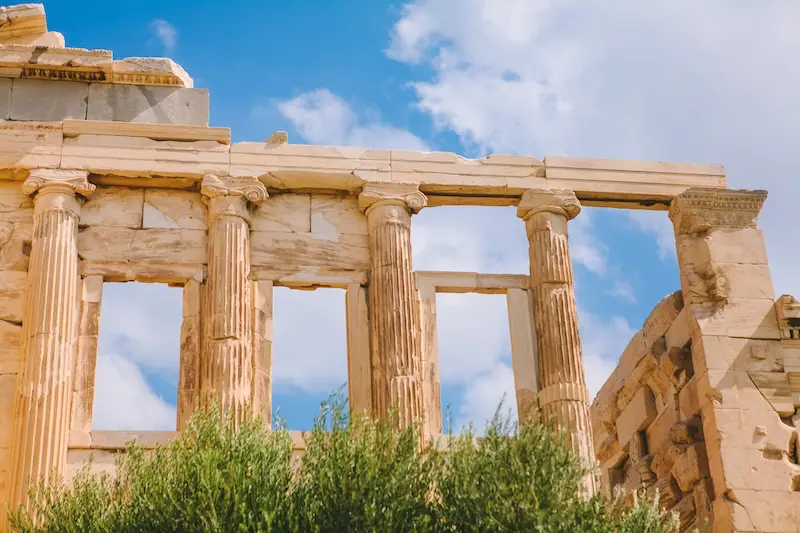
- On foot: If you are staying in Athens, you can easily get to the rock: the Acropolis in Athens is a 15-minute walk from Syntagma Square.
- By metro: By metro, you have to stop at the “Acropoli” station of line 2, the red line. Head down Dionysiou Areopagitou Street to find the main entrance to the site. But this entrance promises to be crowded at any time of the day. Please note that there is a way to enter the site, through the Theater of Dionysus, a much less frequented entrance.
- By bus: With lines 1, 5, 15, 040, 230
5. How much is the entrance to the Acropolis?
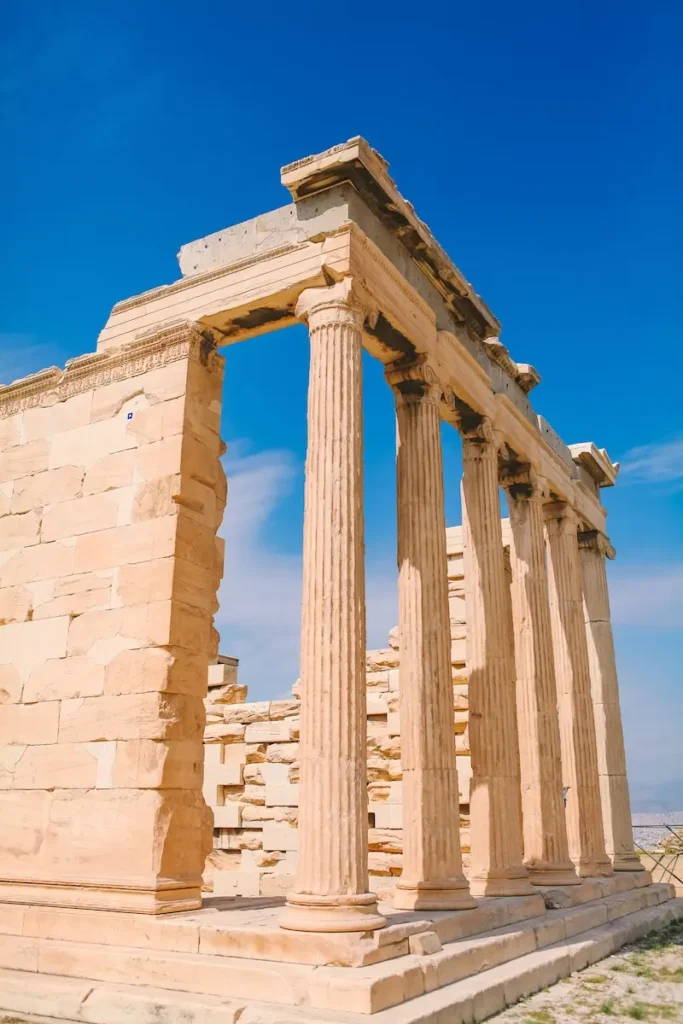
There are two options for purchasing a ticket: on site, at the ticket office (but watch out for the queue!), or online by reserving a skip-the-line ticket.
The prices are:
- Full price single ticket: €22 in summer (from April 1 to October 31) and €10 in winter (from November 1 to March 31)
- Reduced single ticket: €10
- Full price combined ticket (entries to the Acropolis, the Ancient Agora, Keiramikos, Hadrian’s Bookstore, the Roman Agora, Olympion and Aristotle’s Bookstore): €30
- Reduced combined ticket: €15
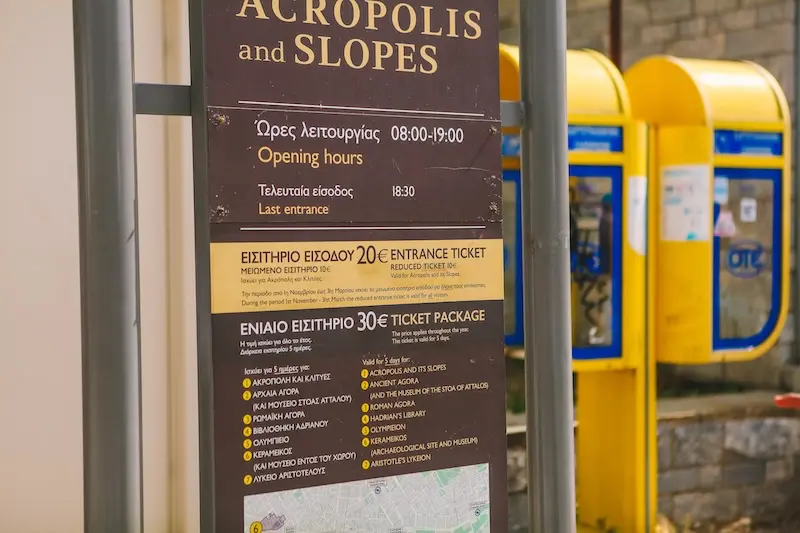
Buy Your Tickets Online:
Good to know :
When you buy your tickets to the Acropolis, you need to select a specific time when to enter. You can only enter when it’s your time, as indicated on your ticket. As we arrived early, we tried to scan our tickets but it didn’t work!
6. The Acropolis Museum

If you only have time for 1 Museum in Athens, then opt for the fabulous Acropolis Museum. It is located at the foot of the Acropolis. It is a glass case inaugurated in 2009 which houses the treasures of the Acropolis.
The scenography is particularly successful and the museum is spacious allowing you to move freely between the artworks. It is a museum that can be visited with children.
On the first floor, you will discover the five caryatids, these statues of women that support the Erechtaion (the sanctuary built on the most sacred part of the Acropolis). These are the original statues that are on display (those that we see on the Acropolis are reproductions).
Don’t miss the exceptional view from the top floor: a transparent panorama facing the Acropolis. This top floor, the Parthenon Gallery, is ingeniously designed to replicate the temple’s magnificent frieze, using cast copies of the sections currently housed in the British Museum (80 meters), the block which is in the Louvre and other scattered fragments in other collections.
Entrance to the museum is €10 in high season and €5 during low season. Tickets can be purchased at the museum entrance, on the Acropolis Museum website and on GetYourGuide .
7. Don’t miss the Areopagus Hill!
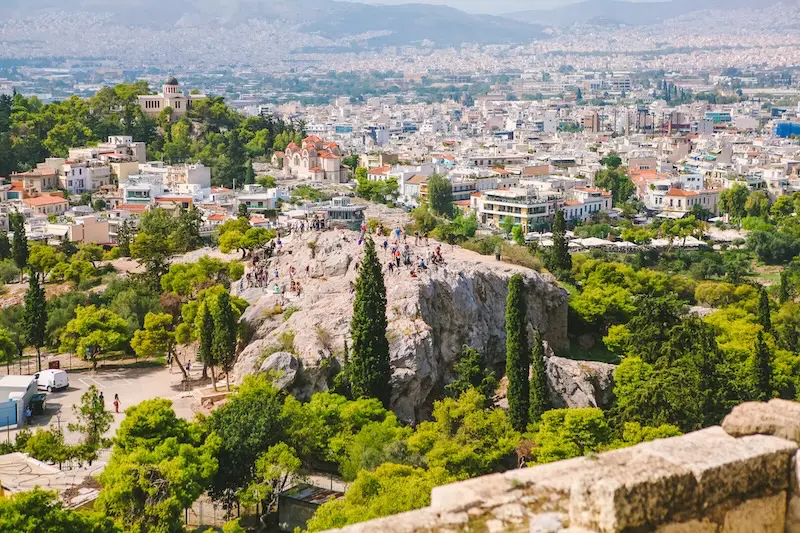
Before entering the Acropolis of Athens, we highly recommend a small stop at the Areopagus Hill, for one of the most beautiful panoramic view of the city, including the Acropolis and the Agora. This hill is a symbol of the city’s rich historical and cultural past. It encapsulates stories of mythology, law, philosophy, and early Christian history (and it’s free).
Areopagus Hill, also known as Mars Hill, is a prominent rock located right by the entrance of the Acropolis. The name Areopagus itself means “Ares’ Rock” in Greek, stemming from the myth that Ares (the god of war, known as Mars to the Romans) was tried here by the gods for the murder of Poseidon’s son Alirrothios.
In ancient times, the Areopagus was the site of the council of elders of the city, similar to the Roman Senate. This council, known as the Areopagus council, was responsible for lawmaking. It played a crucial role in the city’s administration, overseeing matters of law, morality, and justice, particularly in murder cases.
8. Our Final Thoughts

Visiting the Acropolis of Athens was for us one of the main highlights during our travels in Greece .
As you stand on the sacred rock, you’re not just visiting a collection of ancient buildings; you’re stepping into a nexus of history where democracy, philosophy, art, and religion intersected in ways that shaped Western civilization.
A visit to the Acropolis is also a journey into the heart of mythology, where gods and heroes walked the earth. It’s an opportunity to reflect on the ideals of beauty, harmony, and democracy that emerged from this very spot and continue to influence us today.
We are Hammer and Guillaume, a fun couple traveling the world. We will take you to some of the most amazing places on earth. Hammer is a yoga instructor and Guillaume a true water baby, enjoying all kinds of water sports. Follow-us to get the latest update about our travels.
Similar Posts

7 FUN AND EASY WALKING HOLIDAYS IN THE UK FOR COUPLES
The United Kingdom offers a diverse range of landscapes and walking trails that are perfect for couples looking to embark on a great journey

EXPLORE TEJEDA, A CHARMING VILLAGE IN GRAN CANARIA
Tejeda is a pretty village located in the center of the island of Gran Canaria. From there you can contemplate the famous Roque Nublo

25 BEST THINGS TO DO IN FUERTEVENTURA
Visit Fuerteventura: what are the best things to do and see in Fuerteventura? Here is your full guide to visit this amazing island.
![acropolis visit hours HIKE FROM FIRA TO OIA IN SANTORINI [FULL GUIDE]](https://afuncouple.com/wp-content/uploads/2023/09/Best-things-to-do-in-Santorini_Greece-14-768x512.webp)
HIKE FROM FIRA TO OIA IN SANTORINI [FULL GUIDE]
The Fira to Oia hike is one of the best free experiences in Santorini. Check out his full guide to prepare for you hike between Fira to Oia.

20 WORLD’S BEST SURF DESTINATIONS
Where are the world’s best surf destinations? Bali, Hawaii, Australia, Portugal, Brazil, California, and so many more in this post!
![acropolis visit hours WHAT TO SEE IN SEIXAL [MADEIRA GUIDE]](https://afuncouple.com/wp-content/uploads/2022/07/What-to-see-in-Seixal_10-768x512.jpg)
WHAT TO SEE IN SEIXAL [MADEIRA GUIDE]
Seixal is a small village on the edge of the ocean, near Porto Moniz. We strongly recommend a visit to Seixal during your visit of Madeira.
Leave a Reply Cancel reply
Your email address will not be published. Required fields are marked *
Acropolis of Athens Hours
The Acropolis of Athens opens daily at 8 am. However, it follows seasonal hours, catering to visitor comfort and daylight variations.
In the summer season (April to October), the Acropolis opens its doors early at 8 am and welcomes visitors until 7.30 pm.
This extended time allows you to explore the sprawling complex leisurely, especially during the longer daylight hours.
During winter (November to March), the Acropolis maintains its 8 am opening time but closes slightly earlier at 5 pm due to shorter daylight hours.
It’s crucial to remember that the last entry to the Acropolis is 30 minutes before closing time.
Keep in mind a slight variation during September and October. Due to the shortening of daylight hours, the closing time progressively decreases every two weeks by 30 minutes in October.
Refer to the table below for specific dates:
Check out the best tickets for visiting the Acropolis now!
Acropolis Hours At Glance
For a quick reference, here’s a summary of the operating hours of the Acropolis:
Days the Acropolis Remains Closed

While the Acropolis welcomes visitors year-round, there are a few specific days when it is closed. Be sure to plan your trip accordingly:
- New Year’s Day – 1 January
- Greek Independence Day – 25 March
- May Day – 1May
- Easter Sunday
- Christmas – 25 & 26 December
Reduced Hours
The Acropolis also observes reduced opening hours on certain occasions:
- Christmas Eve (24 December): Open from 9 am to 3 pm.
- New Year’s Eve (31 December): Open from 9 am to 3 pm.
- Orthodox Good Friday: Open from noon to 6 pm.
- Orthodox Holy Saturday: Open from 8 am to 3 pm.
Free Entry Days

While the Acropolis offers a captivating experience year-round, there are specific days when you can explore its majesty without paying an entrance fee.
Here’s a breakdown of these free entry opportunities:
Acropolis Museum Hours

The Acropolis Museum offers flexible opening hours to accommodate visitors of all schedules, whether you prefer an early morning visit or an evening exploration.
Here’s everything you need to know about the museum’s operating hours:
Summer Hours (April to October)
Winter Hours (November to March)
Important Note:
- The gallery clearance begins 15 minutes before closing time, so plan your visit accordingly to make the most of your time exploring the exhibits.
- During the August full moon and the European Night of Museums, the Acropolis Museum extends its hours until midnight, providing a unique opportunity to experience the museum and enjoy the moonlit Acropolis at night.
Archaeological Excavation Hours
During the summer season, the Archaeological Excavation beneath the Acropolis Museum welcomes visitors from 9 am to 5 pm on Mondays, with the last entry permitted at 4.30 pm.
From Tuesday to Sunday, the excavation site remains open until 8 pm, allowing visitors to explore until 7.30 pm.
As for the winter months, the excavation hours remain consistent throughout the week, from Monday to Sunday, operating from 9 am to 5 pm, with the last entry also at 4.30 pm.
Whether you’re visiting in the warmer or cooler months, these excavation hours offer ample opportunity to delve into the rich history beneath the Acropolis Museum.
How Long Does it Take to Visit Acropolis?

The time you allocate for exploring the Acropolis of Athens largely depends on your preferences and the depth of experience you seek.
For a quick overview, an hour might suffice, allowing you to skim through key areas like the Parthenon while capturing some snapshots.
However, for a more immersive visit lasting 1-2 hours, you can delve deeper into the architectural marvels, appreciate intricate artwork such as friezes and statues, and leisurely explore the site.
Expect to queue briefly for closer views of certain highlights.
For those desiring a thorough exploration lasting 3 hours or more, ample time is available to examine each structure and monument meticulously.
Additionally, consider visiting the nearby Acropolis Museum ( requiring a separate ticket ) to delve further into the historical context and view artifacts.
Guided tours offer enriched insights amidst the panoramic vistas of Athens, allowing for reflection and appreciation of its historical significance.
Ultimately, you can tailor your visit duration, ensuring an enriching experience aligned with your interests and curiosity.
You can check out the various ticket options for visiting the Acropolis at a glance –
What are the regular opening hours of the Acropolis?
The Acropolis follows seasonal opening hours:
– April to October: Opens daily from 8 am and closes at 7.30 pm.
– November to March (except Sundays): Opens daily from 8.30 am and closes at 3.30 pm.
Is there a specific time when there are fewer crowds?
Generally, the Acropolis experiences fewer crowds:
– Early mornings (right after opening): Aim for shortly after opening times to encounter the fewest visitors.
– Weekdays: Weekdays tend to be less crowded than weekends, excluding the first Sunday of the month during the off-season (free entry).
– Late afternoons (before closing): Crowds might start to thin out closer to closing times, but keep last entry times in mind.
What is the last entry time for the Acropolis?
The last entry times for the Acropolis depend on the season:
– April to October: Last entry is at 7 pm. – November to March (except Sundays): Last entry is at 3 pm.
How long does it typically take to visit the Acropolis?
The time you spend at the Acropolis depends on your interests:
– Quick visit (1 hour): A rushed visit through the main areas like the Parthenon is possible. – Standard visit (1-2 hours): This allows you to appreciate the architecture, artwork, and explore at a leisurely pace. – In-Depth visit (3+ hours): Consider this for a more comprehensive experience, including the Acropolis Museum (separate ticket).
What is the best time of year to visit the Acropolis in terms of weather?
For pleasant weather: – Spring (April-May): Comfortable temperatures for exploring outdoors.
– Fall (September-October): Offers a balance of good weather and potentially smaller crowds compared to summer.
Is there a free entry day for the Acropolis?
Yes, the Acropolis offers free entry on the first Sunday of each month during the off-season (November-March). However, expect larger crowds due to this free access.
Are there separate opening hours for different areas within the Acropolis?
No, the entire Acropolis follows the same opening and closing hours based on the season and specific holidays.
However, the Acropolis Museum hours vary. Take a look at the Museum hours here.
Can you visit the Acropolis at night?
The Acropolis itself is not open for nighttime visits. However, spectacular nighttime views of the Acropolis are possible from various spots in Athens, like Philopappou Hill.
Is the Acropolis open on holidays?
The Acropolis is closed on specific holidays: – 1 January – 25 March (Greek Independence Day) Easter Sunday – 1 May (Labour Day) – 25 & 26 December (Christmas)
Featured Image: Pat Whelen / Pexels
How useful was this post?
Click on a star to rate it!
Plan Your Visit
Opening Hours How to Reach? How long it takes? Best time to visit Tips To Vist Nearby Restaurants Parking Info Top 5 Hotels with Acropolis view
What to See?
AOA Museum Temple of Athena Nike Parthenon Erechtheum Odeon of Herodes Atticus Dining Shopping
Buy Tickets
Skip the line ticket Guided walking tour Food inclusive tours Combo tickets with Audio Guide Audio tour 48-hour Hop On -Off Bus Ticket Special tour Athens pass
Got questions about the Acropolis of Athens? Click/tap on the number below to message us on Whatsapp.
+38651715555
Everything about the Acropolis of Athens
This is NOT the official website of the Acropolis of Athens in Athens, Greece. Vacatis operates the website to provide the most accurate and up-to-day information for tourists and locals.
Affiliate Disclaimer Content Information Policy Sitemap Privacy Policy Terms of Service
© 2024 Vacatis

Tour the Acropolis Without the Crowds: Pristine Parthenon Early Morning Acropolis Tour, Athens
Wondering how to tour the Acropolis, Greece, without the crowds?
Taking an early morning Acropolis tour is your chance to explore the Parthenon with fewer people. Take advantage of visiting during the early hours of the day to explore this iconic landmark at a more relaxing pace.
No trip to Athens would be complete without a visit to the Parthenon – it’s a must-see for any traveller! On my recent trip to the Greek capital, I took a morning tour to see it without the noise and bustle of other tourists.
Pristine Parthenon might just be the best Acropolis tour you’ll find. Read on to find out why.
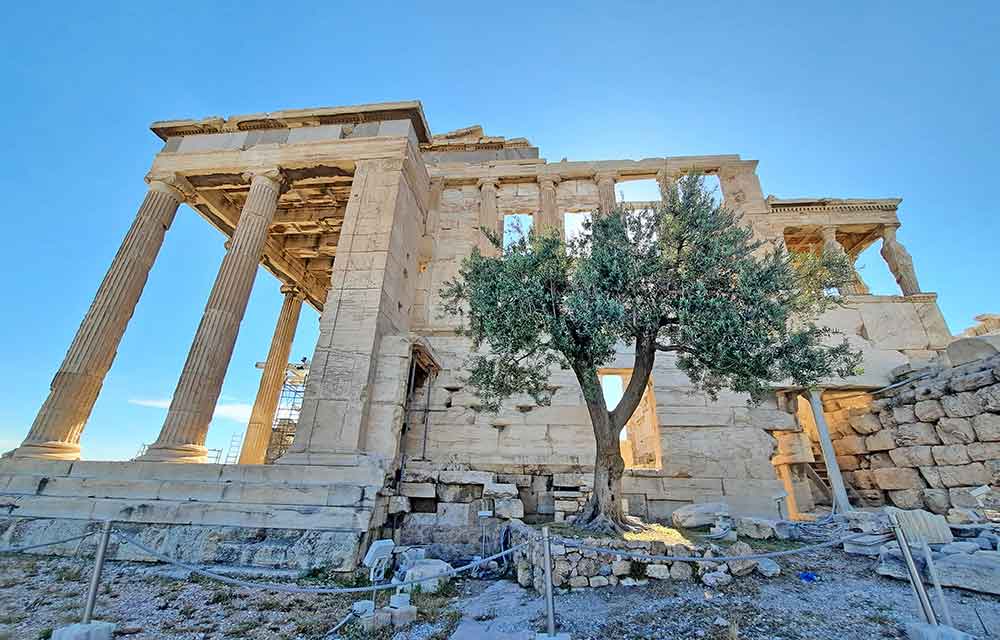
This post may contain affiliate links. To find out what this means and more information visit my disclosure page .
I’ve partnered with Take Walks to bring you this travel guide. This article is based on the destination and experiences I took part in. All views and opinions are my own.
Why Take an Early Morning Acropolis Tour?
There has to be a pretty solid reason to make me haul myself out of bed anytime before 9 am – I’m naturally a night owl. A few things do entice me to get up early: when I have a flight to catch or I want to get out, explore and take photos before the crowds arrive.
Over a million people visit the Acropolis every year. It’s Greece’s most popular attraction.
Even outside of the peak season, the Acropolis can resemble an ant hill as tourist steam up and down it. The best way to avoid crowds is to get there early, and the most efficient way to do it is on an Acropolis early morning tour .
If you’re planning your Athens Acropolis visit, check out the Pristine Parthenon tour I did with the guys from Take Walks and find out what to expect.
TLDR: The Pristine Parthenon Tour is the best way to see the Acropolis without the crowds. Your guide and skip-the-line tickets for the Acropolis AND the Acropolis Museum are part of an all-inclusive price with no nasty hidden extras.
Click here to go straight to the official page for the Pristine Parthenon Tour.
Guide to the Acropolis – What You’ll See on This Tour
During our Acropolis of Athens tour, we had the opportunity to see all the iconic landmarks with next to no crowds blocking our view. These are some of the ruins you’ll visit:
The Odeon of Herodes Atticus
The propylaea.
- Temple of Athena Nike
The Parthenon
The erechtheum.
- The Friezes from the Parthenon (in the Acropolis Musieum)
- The Original Caryatids (in the Acropolis Museum)
Pristine Parthenon: Tour the Acropolis Without the Crowds
After booking, my tickets were sent by email. The tickets have instructions about where to meet and the time – 7.15! For me, that felt like a deathly hour. Our meeting point was near the foot of Acropolis Hill where I joined our small group as we waited for our guide – group sizes are capped at 15!
One of the great things about Athens is that there are bakeries open at this time of the morning. I was able to pick up breakfast on the way to the meeting point and eat it while our licensed tour guide for the Acropolis explained to us how the tour would pan out.

Before the Tour
Our guide explained that the Acropolis and Museum Tour would last around 3.5 – 4 hours, starting with the Acropolis, to beat the crowds, and then moving on to the museum. We were then handed our audio sets, did a sound check and started our stroll to the main entrance.
The Acropolis opens its doors to visitors at 8 am and we wanted to be the first in. Because this was an Acropolis skip-the-line tour , our tickets fast-tracked us through the entrance – no queuing and waiting in line.
Beat the Crowds Tour of Acropolis
If you visit the Acropolis on a Sunday and arrive at 8 am, you’ll catch the tail end of the Evzones – the Presidential Guards – making their way back down from the Acropolis. Every Sunday they make their way to the top of the Acropolis to raise the Greek flag at sunrise.
Once through the gates, we made our first stop. Our Athens Acropolis tour guide stopped us next to the Odeon of Herodes Atticus.
Built in 161 AD, the Odeon of Herodes Atticus is one of the most recognizable structures in the Acropolis. One of the most interesting facts is that it’s still in use today!
It was primarily used for music performances and theatrical plays – its use hasn’t changed much over the centuries.
The Ancient Greeks sure knew a thing or two about how to make a building that stands the test of time. Although it was renovated in the 1950s, despite centuries of erosion and degradation from natural elements, a substantial amount is still original.
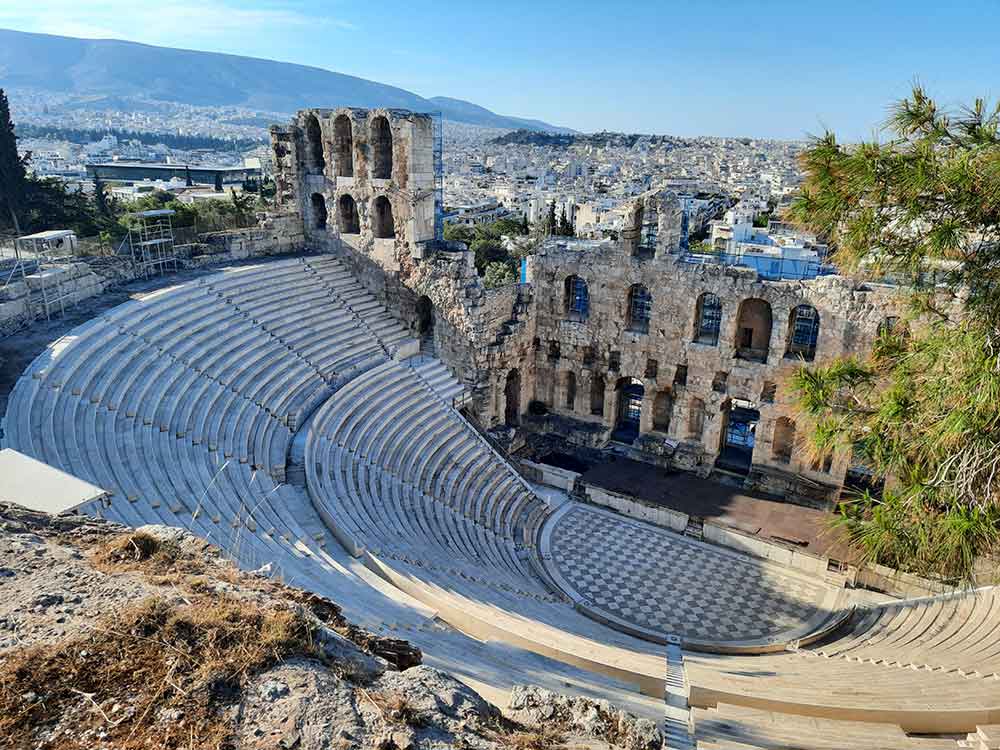
Our Acropolis walking tour continues through the main entrance – through a structure called the Propylaea.
The Propylaea is an enormous structure that has stood since 437 BC. Its purpose was to serve as a grand gateway to the sacred area of the Acropolis. It features marble staircases, porticos, and once would have been adorned with sculptures.

The Temple of Athena Nike
As you walk up the stairs and through the Propylaea, turn your head upwards and to the right. Here you’ll see the Temple of Athena Nike. This small temple was built on a platform near the entrance looking out upon the city of Athens and the sea in the distance.
It was built between 426-421 BC as a dedication to Athena Nike; the goddess of victory, and would have been covered with sculptures and friezes.

No tour of the Acropolis of Athens would be complete without spending a decent amount of time perusing around the Parthenon. This, after all, is what most people come to see, and it didn’t disappoint.
The Parthenon is the largest and most well-known temple on the Acropolis of Athens. Construction began in 447 BC when the Athenian Empire was at its height. It’s approximately 30 metres wide and 69 metres long. It features 46 outer columns and 23 inner columns and once would have housed an inner temple.
Currently, the Parthenon is undergoing some substantial renovations which will hopefully preserve it for another few thousand years! Renovations started in 2017 and are set to be completed by Summer 2023.

On the outside, you can still see some of the decorative sculptures and friezes that would have adorned the upper part of the building. However, many of these have been lost over time – one of the most renowned cases was by Lord Elgin. He removed a large portion of the sculptures and took them to the UK in 1801. They are on display in the British Museum.

The final iconic building at the Acropolis was the Erechtheum. This building is instantly recognisable thanks to its north porch. It features six female figures known as Caryatids which support the roof.
These sculptures are thought to represent the priestesses of Athena or her maidens, and they have become the symbol for the city of Athens. The ones you’ll see at the Acropolis are reconstructions. The original ones have been moved into the Acropolis Museum to help preserve them.
The Erechtheum is believed to have been built between 421-405 BC. It was dedicated to both Athena and Poseidon .
Wander around to the back of this building to see the ancient olive tree. The legend goes that this was a gift from the goddess Athena. The ancient tree has miraculously survived for over 2,500 years!
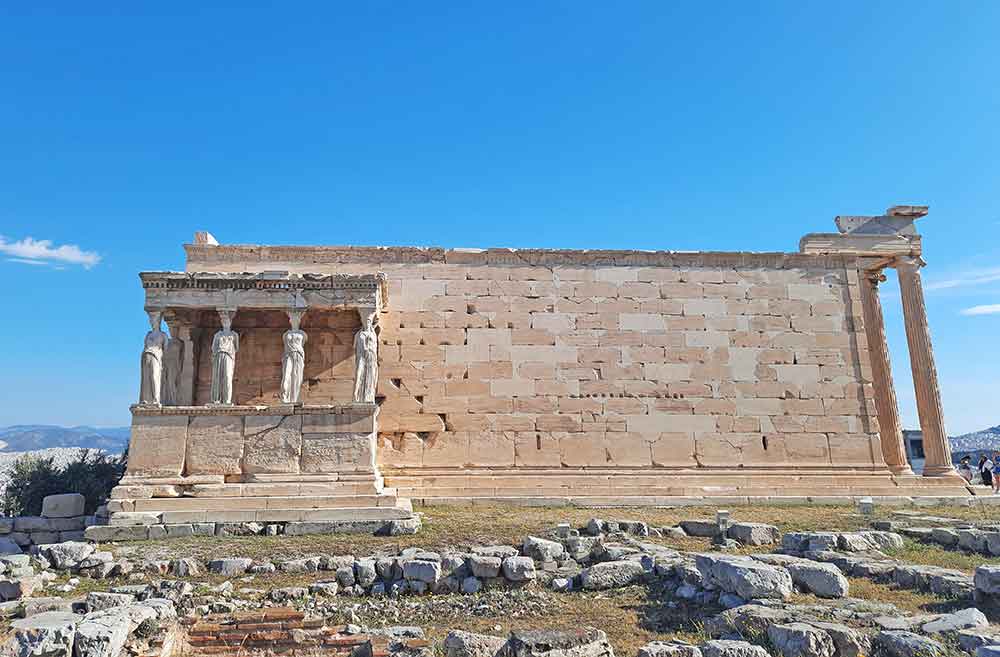
Free Time at the Acropolis
We finished the main part of our walking tour of the Acropolis with an opportunity for some free time. We were given about 20 minutes to go back and explore the area on our own.
I took advantage of this time to wander around and go back to get more photos of everything we had seen. Even though it was still before 10 am, you could really feel the crowds starting to pick up.
Our group gathered back together. Walking back out through The Propylaea you could really see how many people were swarming in through the entrance. As much as I would have loved to have spent longer here, I knew I’d hate how busy it was at this point. Time to leave.
We exited through the main entrance where a snake-like queue had already started to form. I’m glad we got to experience the Acropolis in its relative quiet before the crowds arrived.

Guided Tour of the Acropolis Museum
The next part of our morning was a skip-the-line Acropolis Museum guided tour.
The Acropolis Museum is a state-of-the-art museum offering a great insight into the history of the Acropolis. It is home to many important artefacts discovered at the site, including the famous Parthenon Marbles.
We started on the 3rd floor. Here is where you’ll find the friezes from the Parthenon. They depict battles, mythological creatures and other scenes from Ancient Greece. Our guide explained in detail the history behind each of these friezes, giving us a better appreciation for them.
She then pointed out the differences in the colour of the stone. If they were a brownish colour, they were original pieces, if they were whiter, they were reconstructions taken from an original piece displayed somewhere else in the world. The gaps are where there is no record of the piece.

Even though they are thousands of years old, it was incredible to see how much detail was on the carvings. I took an arts-based degree, and even after my training, there’s no way I’d be able to produce anything as remarkable as these. They are incredibly beautiful pieces of artwork.
Another highlight was the original Caryatids which came from the Erechtheum. These are located on the 1st floor. Because you can be much closer to the sculptures in the museum compared to the ones in the Acropolis, you’re able to see the level of detail on each of the Caryatids. It’s astonishing to think these are thousands of years old!
Besides an abundance of other artefacts, the museum also featured so many digital and physical models of what the Acropolis would have looked like in its heyday. It would have been quite something to look at all those thousands of years ago.

Is the Early Morning Acropolis Tour Worth It?
Yes, especially if you’re not a fan of crowds, which the Acropolis has. Getting there early, as soon as the gates open, in my opinion, is the best way to visit the famous Greek landmark.
If you’re looking to book a skip-the-line Acropolis tour, then Pristine Parthenon by Take Walks not only offers that, but you also have a knowledgeable and official guide giving you tons of information about the site.
Why Pristine Parthenon Is the Best Guided Tour of Acropolis
If you’re still not convinced why I think this is one of the best Acropolis tours in Athens, here’s a rundown:
- Bookable online with instant confirmation
- Small group sizes: maximum of 15
- Fast track skip-the-line entry for the Acropolis
- Early entry tour of Acropolis and Parthenon
- Licenced expert guide
- Whisper system used to hear your guide better
- Fast track skip-the-line entry for the Acropolis Museum
- All-inclusive ticket with no hidden extras

Booking the Early Morning Guided Tour Acropolis, Athens
Booking this skip-the-line Acropolis of Athens tour is easy. The best way is to book directly through the official Take Walks website , skipping any third-party vendors.
Buying your ticket direct is how you can guarantee you get the best price, and more importantly an official ticket. When you come to book, they also have an on-screen calendar to show what their availability is for different days.
Tours are capped at 15 to ensure you have the best experience, however, if you’re travelling as a group of friends or a family, then book well in advance to ensure you can all get on the same tour.
The price you see on the screen is the final price you pay, and you won’t have any sneaky hidden extras on the day. Your ticket is even sent straight to your inbox, so you won’t have the hassle of finding somewhere to get it printed out.
Then all you have to do is turn up and enjoy. Simple!
Check Availability for the Pristine Parthenon Tour
Tips for Visiting the Acropolis
If you’re planning to visit the Acropolis, Athens here are some useful tips based on both of my visits to the site.
1. Arrive early – Crowds start to get big from about 10 am onwards, so get there as soon as the gates open. Ideally with a skip-the-line ticket to fast-track your way through.
2. Bring water – It can get very hot and humid in Athens during the summer months so it’s important to keep hydrated throughout the day. It’s quite an exposed site, so there aren’t many chances to get away from the heat. The great thing is that there’s an onsite water fountain to refill your water bottle.
3. Wear comfortable shoes – Even though there’s a main path, a couple of things to be aware of is that it’s slippery: the polished marble in particular. Make sure your shoes have a decent grip. There are also plenty of rocks to navigate through. My advice; don’t wear your high heels!
4. Don’t forget to look up – The ancient architecture is stunning and some of the best views aren’t always at eye level. The Parthenon still has plenty of detail at roof height.
5. Respect the rules of the site – Make you don’t go to off-limits areas. Some parts are cordoned off, partly because they are undergoing renovation and partly to protect the site from damage. There are plenty of guards around, so if you do step into an off-limit area, you can be sure to hear their warning whistle.
6. Dress appropriately – Although there is no strict Acropolis dress code – like the dress codes for visiting religious temples in Thailand – make sure you’re wearing something suitable. The site is exposed, so you’ll need a hat and sunglasses for sure. During the winter, it can get windy on top, so you’ll certainly need a jacket.
7. Make sure your camera is fully charged – You won’t want to miss out on taking some awesome pictures of the sights, especially if you’re there without the crowds!
The Best Acropolis Tour, Athens – FAQs
So, I’ve gone into detail about the best Athens Acropolis tour, and given you Acropolis tips and advice to help plan your visit. This section covers any other questions you might have about your visit.
Do You Need a Tour Guide for Acropolis?
No, you need to go on a guided tour. However, it is highly recommended to book a guided tour of Acropolis , Athens. They will help put everything you’re seeing into context.
Can I Do a Self Guided Tour of Acropolis?
Yes, you could opt to do an Acropolis self-guided tour. On my first visit to the site, this is exactly what I did because the focus of my visit at that time was to go at my own pace to take hundreds of photos.
However, the downside was that I didn’t have a clue what most of the stuff was that I was looking at. I knew I had a guided tour booked for later in the week, so I wasn’t too worried, but if you don’t plan on doing a guided tour then I recommend reading up on the site beforehand for a better overall experience.
Which Is the Best Acropolis of Athens Tour?
There are dozens of different tours available. Be sure to check what’s included – on some tours you have to pay extra for entrance when you arrive! Doing the Pristine Parthenon tour of Acropolis in Athens not only guaranteed early entry, but was an all-inclusive price, with a skip-the-line entry for the Acropolis and the Acropolis Museum.
Where Can I Buy Acropolis of Athens Tickets?
To make sure you’re buying legitimate Athens Acropolis tickets, I either suggest buying from the on-site ticket booth or the official Acropolis website. You can also buy them from reputable vendors, like the included ticket on the Pristine Parthenon tour I did.
If you’re buying tickets to Acropolis in Athens through a vendor, check that they are officially licenced to sell tickets and not a scam.
What’s the Difference Between Acropolis vs Acropolis Museum?
Your Acropolis tour tickets don’t automatically include entry to the Acropolis Museum. They are two different attractions.
The Acropolis is an ancient citadel that includes the ruins of several historic structures, including the Parthenon. The Acropolis Museum is more modern, and it showcases artefacts from the archaeological site at the Acropolis as well as other sites around Athens.
When Is the Best Time to Visit the Acropolis?
The Acropolis is a year-round attraction. However, the best time to tour the Acropolis and Parthenon is during the shoulder and low seasons – October and April. Aim to arrive early morning on a weekday for fewer crowds.
When Are Acropolis Visiting Hours?
The Acropolis hours vary depending on the time of the year although it opens at 8 am daily all year round.
Acropolis of Athens hours in the winter: 8 am – 5 pm (last entry at 4.30 pm) Acropolis of Athens hours in the summer: 8 am – 8 pm (last entry at 7.30 pm)
Can You Visit the Acropolis at Night?
No, you need to plan your Acropolis Athens visit during opening hours. The site is closed at night. However, the whole of Acropolis Hill is illuminated at nighttime, so head to one of the nearby rooftop bars in Plaka to take in the view.
Is It Easy to Tour the Acropolis With Mobility Problems?
The Acropolis does have some facilities to make this site accessible for visitors with mobility issues. However, this particular Athens Acropolis tour took a route that would not have been accessible for a wheelchair user.
Now Go and See the Acropolis Without the Crowds!
If you’re in Athens, the Acropolis guided tour is a must.
Although you can visit the site at any time of day, because of the crowds, a lot of the charm is lost and it can feel like a wrestling match at times trying to see things.
On the Pristine Parthenon Tour, the Acropolis was pretty much empty – particularly at the beginning of the tour when the gates had just opened. As much as I dislike early starts, I know I dislike crowds more so it was 100% worth getting there before the chaos.
Enjoy the benefits of skip-the-line early access, with a knowledgeable guide. Now go and experience the best Acropolis guided tour for yourself.
Looking for more Greece travel guides to help plan your trip?…
- 29 Great Reasons to Visit Athens
- Island Hopping In The Aegean Sea, Greece
- Greece: Adventure Holiday Destination
Save it for later
If you found this early morning Acropolis tour article useful, save this post for future reference. Know someone else who will find this helpful, then why not share it with them?
Have a question about planning your Greece itinerary? then head to the Contact page and drop me a message.

Hey, I'm Becki......and I'm a self-confessed travel addict and experience connoisseur!
In other words, I’m a bucket-list traveller, on a mission to experience the best things our fabulous little planet has to offer with the least environmental impact.
When I'm not climbing mountains, scuba diving, spotting wildlife or exploring ruins, you'll probably find me sipping coffee, or with a glass of wine in hand planning my next adventure.
Similar Posts

Best 4 Days in Athens Itinerary: Complete Athens 4 Days Guide for First-Time Visitors
FacebookTweetPin Looking for the best 4 days in Athens itinerary? You’re in the right place! Welcome to Athens, the…

Best Castles in Lithuania: 13 Must-Visit Lithuania Castles
FacebookTweetPin Planning your trip to the Baltic States and wondering how to visit the best castles in Lithuania? Lithuania…

One Day in Gozo Itinerary: The Best Things to Do on Gozo, Malta (2023)
FacebookTweetPin Looking for the best one day in Gozo itinerary? You’re in the right place! Whether you planning on…

20 Interesting Facts About Sicily: Discover the Fascinating History and Culture of Italy’s Largest Island
FacebookTweetPin Dive into these interesting facts about Sicily, Italy, a region teeming with history, culture, and natural allure. I’ve…

9 Best Cities in Lithuania to Visit + 3 Other Top Places to Visit in Lithuania
FacebookTweetPin Planning your trip to the beautiful Baltic nation of Lithuania, and not sure which are the best cities…

Best Holiday Destinations To Relax And Unwind In 2023
FacebookTweetPin While there’s a time and a place for action-packed adventure holidays, sometimes you just need to get away…
- Athens Attractions
- Temple of Athena Nike
- Plan Your Visit
- Skip the Line Tours
- Guided Tours
- Acropolis Museum Tickets
- National Archaeological Museum Tickets
- Delphi Tours
- Athens To Meteora Tours
- Temple of Olympian Zeus
- Museum of Illusions Athens
- Temple of Poseidon & Cape Sounio Tours
- Ancient Olympia Tickets
- Walking Tours
- Hop-On Hop-Off Tours
- Travel Guide
- Things to do
- Festivals and Events
A comprehensive guide to Athens Acropolis Opening Hours
Open 8 AM - 7:30 PM
Last Admission

Last entry: Half an hour before closing time
Acropolis of Athens is closed on:
- Easter Sunday
- 25 December
- 26 December
Book Athens Acropolis tickets
Best time to visit the acropolis, weekday vs weekend.
- The best time to visit the Acropolis of Athens is typically on a weekday, especially in the morning or late afternoon.
- Weekends tend to be more crowded with tourists, so visiting during the week can offer a more relaxed experience with shorter queues and better opportunities for exploration.
Peak season vs Low season
- The off-season months from April to mid-June and mid-September through October are the best time to visit the Acropolis of Athens.
- The weather is fairly pleasant during these months as compared to the hot peak summer season, and tourist numbers are lower, making hotels and airfare more affordable.
- The winter months from November to March are an ideal time to visit if you are on a budget.
How long does it take to tour the Acropolis of Athens?
The Acropolis of Athens is a vast, rocky complex covering more than 30,000 square metres. It has several different structures like the Parthenon , the Old Temple of Athena and the Temple of Athena Nike , Erechtheion, and Propylaea, among many others. There is a lot of walking involved at the archaeological site to see all the ancient ruins and visitors shouldn't overlook the lesser-known structures. We recommend keeping aside at least 2 to 3 hours to be able to cover the entire historical landmark and make the most of your visit.
Frequently asked questions about the Athens Acropolis opening hours
The Athens Acropolis opening hours are from 8 AM to sunset. The actual time of closing changes based on the season. In summer i.e. from 1st April to 15th September, it closes at 7.30 PM. From 16th to 30th September, it's open from 8 AM to 7 PM, from 1st to 15th October - 8 AM to 6.30 PM, from 16th to 31st October - 8 AM to 6 PM, and from 1st November to 31st March (winter months) - 8 AM to 5 PM.
Yes, the Acropolis of Athens is open daily. It is closed only on certain holidays like 1st January, 25th March, 1st May, Easter Sunday, and 25th and 26th December.
During the summer months (1st April to 15th September), the Acropolis of Athens is open every day from 8 AM to 7.30 PM, with the last entry at 7 PM.
The Athens Acropolis opening hours during the winter months (1st November to 31st March) are from 8 AM to 5 PM, with the last entry at 4.30 PM.
Yes, last entry to the Acropolis of Athens is always half an hour before closing time.
The Acropolis of Athens is closed on the 1st of January, the 25th of March, the 1st of May, Easter Sunday, and the 25th and 26th of December.
The best time to visit the Acropolis of Athens is early mornings on weekdays during the months from April to mid-June and mid-September through October.
It takes around 2 to 3 hours to explore the Acropolis of Athens archaeological site.

Acropolis of Athens location

Acropolis of Athens entrances

Acropolis of Athens guided tours
‘Joker 2’ Trailer Launches to 167 Million Views in 24 Hours, Giving Warner Bros. It’s Biggest and Most Talked About Trailer Since ‘Barbie’ (EXCLUSIVE)
By Zack Sharf
Digital News Director
- James Gandolfini Reprised Tony Soprano in 2010 to Help Recruit LeBron James to the Knicks — the Video Footage Has Debuted Online After 14 Years 2 hours ago
- Michael Douglas Asked Marvel to Kill Him Off in ‘Ant-Man and the Wasp: Quantumania’ and Pitched a ‘Fantastic’ Death: ‘I Can Shrink to an Ant Size and Explode’ 3 hours ago
- Rob Schneider Denies Republican Comedy Set Was Cut Short Over Offensive Material: ‘I’m Not Apologizing for My Jokes. Enough With This Woke Bulls—‘ 5 hours ago

The trailer launch for “ Joker: Folie à Deux ” was no laughing matter for Warner Bros. The marketing for the studio’s upcoming DC sequel, headlined by Joaquin Phoenix and Lady Gaga, got off to a stellar start with 167 million viewers in its first 24 hours. The teaser trailer went online right after it debuted at Warner Bros.’s CinemaCon presentation in Las Vegas.
Popular on Variety
The trailer numbers are great news for Warner Bros. Beating “Barbie” is of note, as that film went on to earn $1.4 billion at the worldwide box office for the studio and was last year’s highest-grossing movie. The original “Joker” surpassed $1 billion in 2019; the sequel is aiming for even higher total given this initial interest and the addition of superstar Lady Gaga to the cast.
Among the trailers for the year’s studio tentpoles, “Joker: Folie à Deux” trounced the debut of “Kingdom of the Planet of the Apes (100 million views) and bested Pixar’s “Inside Out 2” (157 million views to become the biggest debut for a Disney animated film). The “Joker” trailer was below Marvel’s “Deadpool and Wolverine,” which set a record earlier this year as the biggest trailer launch of all time with 365 million views. However, the Marvel tentpole launched on Super Bowl Sunday and its viewership numbers factored in the telecast. The “Joker: Folie à Deux” trailer launch was purely digital.
“Joker” director Todd Phillips is back for the sequel, too. He said at CinemaCon that calling the movie a musical was not exactly correct.
“I like to say it’s a movie where music is an essential element,” Phillips said. “It doesn’t veer too far from the first film. Arthur has music in him. He has a grace to him.”
“Joker 2” will debut on the big screen on Oct. 4 — exactly five years after the first film. The sequel will screen in the Imax 70mm format.
More From Our Brands
Scientology boss david miscavige gets judge knocked off sex assault lawsuit, robb report’s napa valley wine club has 3 stellar new reds on the way, caitlin clark smashes another tv record as wnba draft draws 2.45m, be tough on dirt but gentle on your body with the best soaps for sensitive skin, tvline items: emily vancamp’s new show, phillipa soo joins ryan murphy’s dr. odyssey and more, verify it's you, please log in.
Advertisement
Biden Bashes Trump as a Pawn of Billionaires as He Lays Out His Tax Plan
Speaking in Scranton, Pa., his hometown, the president used a speech about economic fairness as a new avenue of attack against his Republican rival, who was in a courtroom two hours away.
- Share full article
Biden Digs at Trump During His Pennsylvania Hometown Visit
In a speech about his tax plan, president biden compared scranton, pa., to trump’s mar-a-lago to highlight the different economic and social values between america’s middle class and its wealthy..
We’re not asking anything as unusual. Under my plan, nobody earning less than $400,000 will pay an additional penny. I hope you’re all able to make $400,000. I never did. You know, I have to say, if Trump’s stock in Truth Social — his company — drops any lower, he might do better under my tax plan than his. [laughter] No billionaire should pay a lower tax rate than a teacher, a nurse, a sanitation worker. Folks, where we come from matters. When I look at the economy, I don’t see it through the eyes of Mar-a-Lago. I see it through the eyes of Scranton. And that’s not hyperbole, that’s a fact. Donald Trump looks at the world differently than you and me. He wakes up in the morning in Mar-a-Lago thinking about himself. How he can help his billionaire friends gain power and control, and force their extreme agenda on the rest of us.

By Nicholas Nehamas
Reporting from Scranton, Pa.
- April 16, 2024 Updated 6:21 p.m. ET
President Biden delivered a flurry of attacks on former President Donald J. Trump during a Tuesday speech in Pennsylvania about taxes and economic policy, painting his Republican rival as a puppet of plutocrats who had ignored the working class.
Visiting his hometown, Scranton, in a top battleground state that he has visited more often than any other, Mr. Biden laid out his vision for a fairer tax code, including raising rates on the wealthy and corporations and using the money to expand the economy and help working families.
But in a speech that signaled the Biden campaign’s intention to make the 2024 election a referendum on his polarizing Republican opponent, the president returned again and again to Mr. Trump. His jabs at his predecessor took aim at the former president’s wealthy upbringing, his friendships with billionaires and his 2017 tax cuts that disproportionately benefited America’s upper crust .
“Donald Trump looks at the world differently than you and me,” Mr. Biden told a crowd of more than a hundred supporters at a cultural center in Scranton. “He wakes up in the morning at Mar-a-Lago thinking about himself. How he can help his billionaire friends gain power and control, and force their extreme agenda on the rest of us.”
Aiming for a clear contrast, Mr. Biden laid out his proposals: Expanding the child tax credit. Providing a $10,000 tax credit for first-time home buyers. Raising the minimum tax rate for billionaires and corporations.
“We know the best way to build an economy is from the middle out and the bottom up, not the top down,” Mr. Biden said. “Because when you do that, the poor have a ladder up and the middle class does well and the wealthy still do very well. We all do well.”
Karoline Leavitt, a spokeswoman for the Trump campaign, disputed that Mr. Biden’s plan would benefit Americans.
“President Trump proudly passed the largest tax CUTS in history,” she said in a statement. “Joe Biden is proposing the largest tax HIKE ever.”
Throughout his speech, Mr. Biden wove in criticism of Mr. Trump — including a needling joke about the falling shares in the former president’s social media company.
“If Trump’s stock in Truth Social — his company — drops any lower, he might do better under my tax plan than his,” Mr. Biden said.
The president’s speech kicked off a three-day swing through Pennsylvania, with appearances scheduled in Pittsburgh on Wednesday and Philadelphia on Thursday. The trip came as Mr. Trump appeared in court in Manhattan for the second straight day as his first criminal trial begins — a striking split screen welcomed by the Biden campaign.

Since Mr. Biden delivered his State of the Union address last month, his campaign has shifted into general election mode, after a far quieter start to the year. In recent weeks, he has visited every major battleground state. His campaign has opened more than 100 field offices around the nation in coordination with state Democratic parties, spent $30 million in an advertising blitz and built a significant fund-raising advantage over Mr. Trump. An Arizona court decision that upheld a near-total abortion ban dating to 1864 has also energized Democrats .
As those efforts have taken place, Mr. Biden’s depressed poll numbers have improved, with a survey this month by The New York Times and Siena College finding that he had nearly erased Mr. Trump’s lead nationwide. The president had trailed Mr. Trump by five percentage points in the previous survey. Much of Mr. Biden’s recovery came from his improved standing among traditional Democratic voters, a signal that his campaign’s messaging efforts may be having an effect.
Still, Mr. Biden faces an uphill battle in convincing Americans that he is a better steward of the nation’s economy than Mr. Trump. In the latest Times/Siena poll, 64 percent of voters said they approved of how Mr. Trump had handled the economy while in office. Only 34 percent said the same of Mr. Biden, the poll found.
The tax cuts that Mr. Trump signed into law in 2017 have proved unpopular with voters. And while they increased investment in the U.S. economy and delivered a modest pay bump for workers, they fell short of Republican promises and are adding greatly to the national debt, one academic study found. Many parts of those tax cuts are set to expire next year.
Mr. Biden pledged in his speech that under his plan, nobody earning less than $400,000 would see their taxes go up.
“I hope you’re able to make $400,000,” he told the crowd. “I never did.”
As Mr. Biden spoke, Mr. Trump was seated in a Manhattan courtroom roughly two hours away, watching the selection of the first jurors in his trial. Mr. Biden has generally refrained from mentioning the charges Mr. Trump faces in four criminal cases, but his campaign did troll the former president on social media for appearing to fall asleep during proceedings on Monday.
Karine Jean-Pierre, the White House press secretary, did not answer when asked if Mr. Biden was watching the Trump trial or being briefed on it.
“His focus is on the American people,” she said during a briefing with reporters aboard Air Force One en route to Scranton.
But even in his hometown, Mr. Biden could not avoid the anger that many Democrats feel over his support for Israel during its war in Gaza. As Mr. Biden walked up the steps of his childhood home, a crowd of protesters down the block waved Palestinian flags and chanted “Genocide Joe has got to go” through a loudspeaker.
Mr. Biden is set to speak on Wednesday at the headquarters of the United Steelworkers union in Pittsburgh before visiting Philadelphia on Thursday. He narrowly defeated Mr. Trump in Pennsylvania in 2020, and winning the state is crucial to his re-election strategy.
Democratic allies of Mr. Biden said they thought his message on economic fairness would resonate in Pennsylvania.
“Scranton versus Fifth Avenue was one of the most successful frames from the 2020 campaign,” said Representative Brendan Boyle of Pennsylvania, referring to the location of Trump Tower in Manhattan. “You’re going to see more of it in this campaign.”
Nicholas Nehamas is a Times political reporter covering the re-election campaign of President Biden. More about Nicholas Nehamas
Our Coverage of the 2024 Election
Presidential Race
The start of Donald Trump’s criminal trial in Manhattan drew intense security, smothering media coverage and loud demonstrations to a dingy courthouse that will be the unlikely center of American politics for the next six weeks.
President Biden will kick off a three-day tour of Pennsylvania , a crucial battleground state, with a speech that focuses on taxes and aims to contrast his policies with those of Trump.
Trump leaned heavily on major Republican donors in March as he sought to close the financial gap separating him from Biden, new federal filings showed.
Vice-Presidential Calculations: As Trump sifts through potential running mates, he has peppered some advisers and associates with a direct question: Which Republican could best help him raise money ?
Embracing the Jan. 6 Rioters: Trump initially disavowed the attack on the Capitol, but he is now making it a centerpiece of his campaign .
Mobilizing the Left: Amid the war in Gaza, the pro-Palestinian movement has grown into a powerful, if disjointed, political force in the United States. Democrats are feeling the pressure .
On a Collision Course: As president, Trump never trusted the intelligence community. His antipathy has only grown since he left office, with potentially serious implications should he return to power .

COMMENTS
Independent school visit. For independent school visits, please telephone the Group Bookings on +30 210 9000903, from Monday to Friday, 9.00 a.m. to 5.00 p.m or email your request on [email protected]. School groups without a reservation risk being unable to enter the Museum.
The Athens Acropolis opening hours vary in different seasons depending on the daylight hours: 1st April to 15th September: 8 AM to 7.30 PM. 16th to 30th September: 8 AM to 7 PM. 1st to 15th October: 8 AM to 6.30 PM. 16th to 31st October: 8 AM to 6 PM. 1st November to 31st March: 8 AM to 5 PM.
Opening Hours: The Acropolis is open almost every day of the year from 8 am to 7:30 pm in the summer (last entrance at 7 pm) and 8 am to 5 pm in the winter (last entrance at 4:30 pm). Closing hours are subject to change, particularly in September and October, so be sure to check the official website for updated info.
From the 1st.09.2022 the opening hours apply. 1-15.09.2022: 8:00- 19:30 Last entrance to the Site at 19:00 ... From Friday 28th of May 2021 and on, the visitors of the Site are not be able to visit Acropolis North Slope (Peripatos) due to work in progress. People with Special Needs will be allowed to use this path, in order to approach the ...
Prices here in Canadian Dollars for two adults. The Acropolis is open daily from April to October from 8:00 AM to 8:00 PM, offering ample time to explore. Winter hours shorten a bit, so plan accordingly. Remember, the last entry is usually an hour before closing, so give yourself plenty of time to wander and wonder.
There are two types of tickets for the Acropolis of Athens entrance. The single-use tickets are 10 € and allow for a single visit to the Athens Acropolis and the Slopes. You can also buy 30 € combined tickets, which allows you to enter 6 other sites in Athens, besides the Acropolis, for 5 days starting from the first entrance.
A complete guide on how to visit the Acropolis Museum in Athens. Opening hours, admission fees, exhibits, events, activities, and useful information. ... Limited hours: Christmas Eve & New Year's Eve 09:00 - 15:00, Orthodox Good Friday 12:00 - 18:00, Orthodox Holy Saturday 08:00 - 15:00 .
Admission, Tickets, Guided Tours & Hours. Admission: Children under the age of 5, EU citizens under the age of 18 and visitors with disabilities are admitted free. The site is also free for holders of this Athens Pass. Tickets: Admission prices for the Acropolis Museum vary depending on the season.
Acropolis Museum hours align with The Acropolis itself. It is a stunning modern facility with some excellent shops and cafes all delightfully air conditioned, so this is a good place to visit in the heat of the day. Some people like to visit after they see The Acropolis, others before. That really is a personal choice.
Summer Season (1st April to 31st October): Monday: 9am to 5pm. Tuesday to Sunday: 9am to 8pm. Friday: 9am to 10pm. Closed on: The Acropolis Museum is closed on 1 January, Orthodox Easter Sunday, 1 May, and 25 and 26 December. Last admission: 30 minutes before closing. Acropolis Museum opening hours.
The time of year that you visit the Acropolis will dictate the hours of operation, though the final entry is always a half hour prior to closing, according to Greece Travel Secrets. Remember that it will take roughly 20 minutes to get to the top of the hill if you don't stop to look at monuments along the way. And absolutely don't save your ...
Info. Acropolis, Athens, 105 58. Acropolis / Koukaki. Wheelchair Accessible. +30 210 321 4172. Website. Refer to the website for opening hours and ticket prices. The Acropolis is known worldwide for its architectural masterpieces, including the Parthenon, the Temple of Athena Nike and the Erechtheion on the top of this hill.
When visiting Athens, no trip is complete without a visit to the Acropolis. This iconic ancient citadel, perched high above the city, is home to some of the ... The opening hours of the Acropolis vary depending on the time of year. From April 1st to October 31st, the site is open from 8 am to 8 pm. From November 1st to March 31st, the site is ...
Visiting the Acropolis Athens. You should allow at least 2-3 hours for visiting the Acropolis Athens and its museum. Entrance to the Acropolis Museum is included in your Acropolis admission ticket. The exhibitions here are well worth your time and allow you to gain additional context to the structures that you have seen on Acropolis hill.
Most visitors will find two to three hours enough time to see everything at the site, make sure to allow a couple of extra hours to visit the Acropolis Museum (located near the south slope of the Acropolis). Plan out your visit. Bear in mind that the Acropolis is located on an exposed hill, the steps are slippery (especially when wet) and there ...
The monument closes at 3 p.m. on certain public holidays. - It takes at least 2 hours to complete the visit. - It is preferable to buy tickets online in order to skip the long queue. - To get to the Acropolis, you can access it on foot, it's a 15-minute walk from Syntagma Square. By metro, stop at the "Acropoli" station.
Visitors typically need around one and a half to 2 hours to thoroughly explore the Acropolis Museum. However, history and Ancient Greece enthusiasts or those interested in more in-depth exploration can opt for guided tours, which would extend their visit to two and a half to 3 hours.
The hours right before closing are also a popular time to visit as there are fewer crowds. The new entry system will see a limit on how many people can access the site each hour. From 8 to 9 am ...
- Quick visit (1 hour): A rushed visit through the main areas like the Parthenon is possible. - Standard visit (1-2 hours): This allows you to appreciate the architecture, artwork, and explore at a leisurely pace. - In-Depth visit (3+ hours): Consider this for a more comprehensive experience, including the Acropolis Museum (separate ticket).
Tips for Visiting the Acropolis. If you're planning to visit the Acropolis, Athens here are some useful tips based on both of my visits to the site. 1. Arrive early - Crowds start to get big from about 10 am onwards, so get there as soon as the gates open. Ideally with a skip-the-line ticket to fast-track your way through. 2.
The Athens Acropolis opening hours are from 8 AM to sunset. The actual time of closing changes based on the season. In summer i.e. from 1st April to 15th September, it closes at 7.30 PM. From 16th to 30th September, it's open from 8 AM to 7 PM, from 1st to 15th October - 8 AM to 6.30 PM, from 16th to 31st October - 8 AM to 6 PM, and from 1st ...
Film. News. Apr 11, 2024 2:25pm PT. 'Joker 2' Trailer Launches to 167 Million Views in 24 Hours, Giving Warner Bros. It's Biggest and Most Talked About Trailer Since 'Barbie' (EXCLUSIVE ...
Reporting from Scranton, Pa. April 16, 2024, 4:06 p.m. ET. President Biden delivered a flurry of attacks on former President Donald J. Trump during a Tuesday speech in Pennsylvania about taxes and ...
Former President Trump railed against the judge in his criminal hush money case early Monday, just hours before the first criminal trial against a former U.S. president is set to begin. Repeating c…